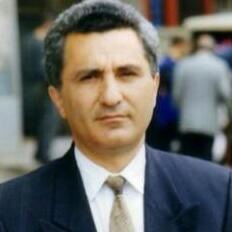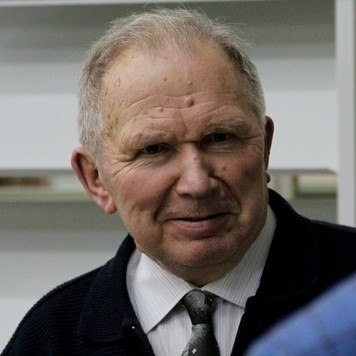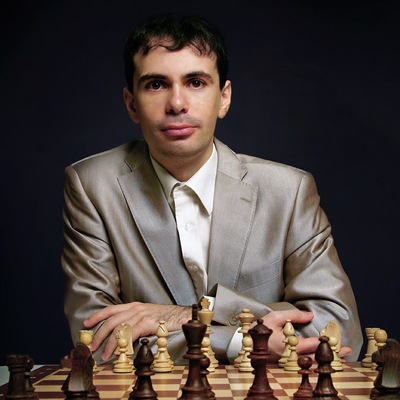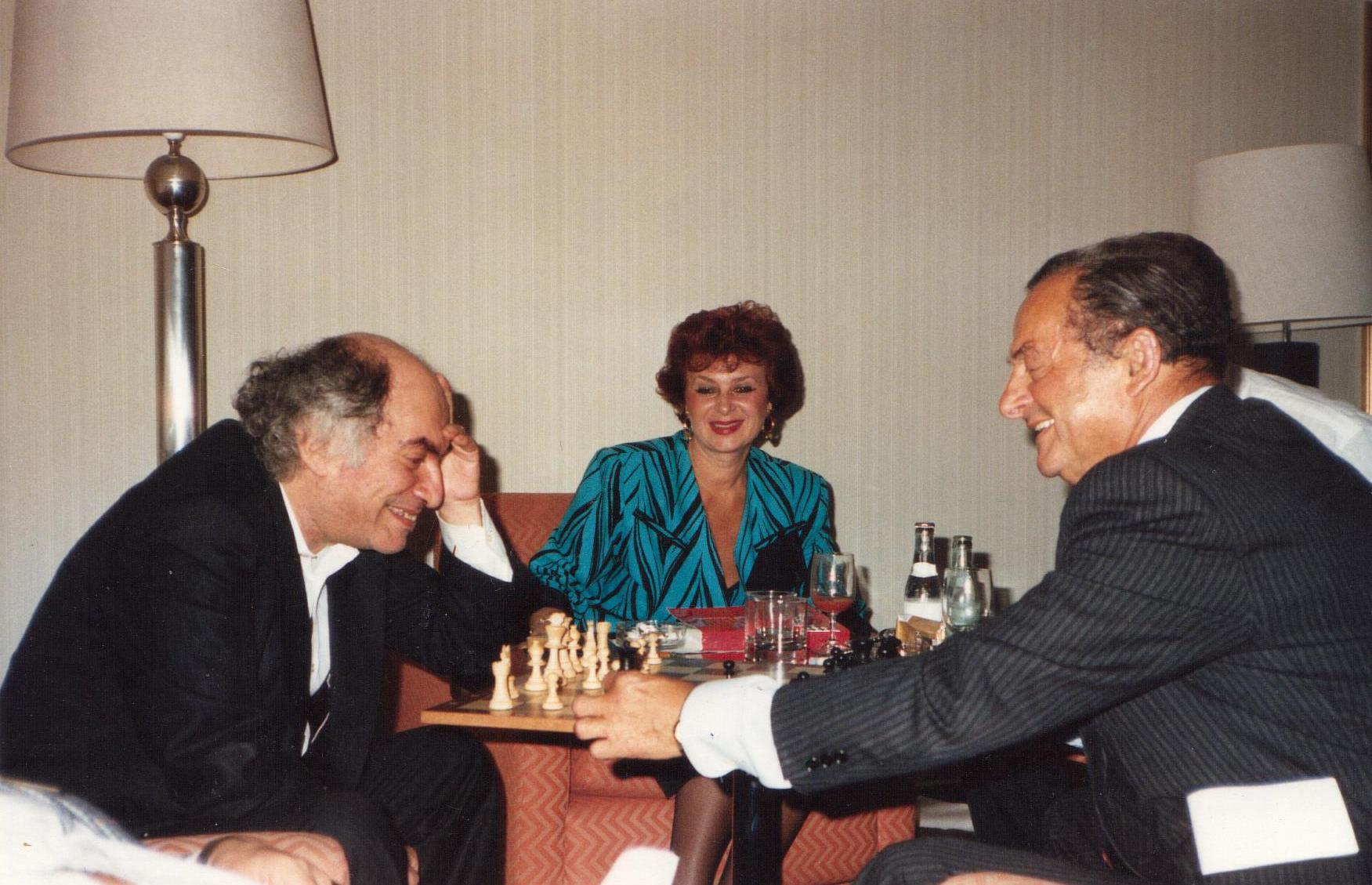
Welcome to the webstore of Elk and Ruby Publishing House. We specialize in publishing high-quality chess books.
We were founded in 2017 and have so far published 71 great chess books from excellent authors, listed below. We have more exciting books in the pipeline.
All of our books are available on Amazon and they are all also available in electronic format on Amazon Kindle and many on the Forward Chess app for computers, iOS and Android (www.forwardchess.com) as well. They can also be ordered online through select book shops, including Barnes & Noble in the United States and Waterstones, Blackwell's and WHSmith in the UK.
Magnus Carlsen reveals his summer reading - and it's our new book Alexander Alekhine, The Russian Sphinx: Volume I
BIG NEWS!!! Goodbye website, hello WEBSTORE!! Click on the purchase links to order. Please note that fullfilment of orders marked "USA/UK only" is entirely carried out by IngramSpark and any queries about your order such as transportation damage should be raised with them directly by clicking the "FAQ" link in the email with tracking information and then clicking on the relevant option. Likewise, fullfilment of orders marked "world-wide shipping from Europe" is entirely carried out by Bookmundo and any queries about your order should be raised with them directly by clicking on the "Let us know" link in the email they sent to confirm your order..
Specialist chess shops selling Elk and Ruby books include Chess4Less in the USA (www.chess4less.com), House of Staunton in the USA (www.thehouseofstaunton.com), the US Chess Federation shop (www.uscfsales.com), the chess.com shop (https://shop.chess.com), and Chess River in the USA https://chessriver.com, Schach Niggemann in Germany (www.schachversand.de), New in Chess in the Netherlands (www.newinchess.com), De Beste Zet in the Netherlands (www.debestezet.nl), Chess & Bridge in the UK (https://chess.co.uk), Variantes in France (www.variantes.com), Le Pion Passé in France (www.lepionpasse.com), Le Due Torri in Italy (www.scacco.it), Norsk Sjakkforlag in Norway (www.sjakkbutikken.no), La Maison des échecs in Belgium (www.maisondesechecs.be), Mat et mots in Belgium (www.matetmots.be), De Denksportkampioen in Belgium (www.denksportkampioen.be), Caissa in Poland (www.caissa-chess.com), Skaki64 in Greece (www.skaki64.gr/e-shop), Chess-shop.gr in Greece (www.chess-shop.gr), Svenska Schackbutiken in Sweden (www.schackbutiken.se), Karel Mokry's bookstore in the Czech Republic (www.chessbookshop.com), SlavChess in Israel (www.slavchess.com), Ideas Deportivas Canarias in Spain (www.mundochess.es), Ajedrez21 in Spain (www.ajedrez21.com), and La Casa del Ajedrez in Spain (www.lacasadelajedrez.com).
MORE BIG NEWS!!! We have launched a partnership in India to print books locally and sell them in India at local prices. Our first three titles have been printed and are available for purchase from our fantastic local partner Citadel Chess World!! These 3 titles are now available at just INR 600!: Magnus Wins With White, Magnus Wins With Black and From Boy to Man to Challenger: The Fiercest Battles of Gukesh D.
Reach out to Citadel Chess World - 98848 00162 Shrinidhi, 97811 68668 Padmaavati.
We can be contacted at info@elkandruby.com and on Twitter/X @ilan_ruby
Our latest releases!!




welcome to THE ELK AND RUBY CHESS BOOK webstore!
cLICK ON THE BUTTONS BELOW TO SEE THE PRICES AND ORDER!
Sign up for our mailing list!
*Required
Our authors and books
Cyrus Lakdawala
International Master Cyrus Lakdawala was born in Mumbai, India, in 1960, moved to Montreal, Canada, in 1966, and later moved at age 18 to San Diego, California, where he continues to reside. He reached a peak USCF rating of 2597 in 1994 and obtained the IM title in 2002. He is a a 6-time Southern California State Champion and won the San Diego Chess Club Championship 23 times.
Cyrus began writing chess books in 2009 and since then has written 77 books, making him the most prolific chess writer in the world. He continues to coach and two of his students have also become IMs.
From Boy to Man to Challenger: The Fiercest Battles of Gukesh D (2024) - in paperback, hardback, Amazon Kindle and Forward Chess

*** THE NEW WORLD CHESS CHAMPION ***
On 12 December 2024 Gukesh D became the 18th World Chess Champion, defeating Ding Liren by a score of 7.5–6.5. This made him the youngest undisputed world chess champion in history and the second Indian to hold the title after Vishy Anand.
This book, published just a few months before his amazing world title victory, covers his 70 most exciting games up to and including the 2024 Candidates Tournament.
*************************************
Gukesh Dommaraju became the challenger for the 2024 World Chess Championship when the then 17 year old won the Candidates Tournament in Toronto earlier that year, ahead of favourites including Hikaru Nakamura, Fabiano Caruana and Ian Nepomniachtchi. A year earlier Gukesh wasn't so well known in the West, even though the chess prodigy had been consistently breaking records:
*Gukesh was the second-youngest Grandmaster in chess history, missing being the youngest-ever by only 17 days.
*He was the fourth-youngest player to shatter the stratospheric 2700 rating barrier.
* He was the youngest-ever winner of the Candidates cycle at age 17, making him the youngest challenger in a World Chess Championship match.
Gukesh's style and strategic mastery much resemble those of the young Anatoly Karpov. He wins imperceptibly, where every 12 moves or so you notice his position improving, seemingly without having done anything! Gukesh seeks to smother his opponent's intentions in the crib, before they have a chance to grow into actual threats.
In 70 fully annotated games, this book covers Gukesh's fiercest battles against many of the world's top players. Opponents include world champions Magnus Carlsen, Ding Liren, Vishy Anand and Vladimir Kramnik, as well as other world-class players such as Caruana, Nepo, Nakamura, Giri, Firouzja, Vidit, and his long-standing rival Praggnanandhaa among others. Seven games are taken from the Toronto Candidates Tournament.
To buy in India at local prices reach out to our local partner Citadel Chess World - 98848 00162 Shrinidhi, 97811 68668 Padmaavati.
American Dream: The Best Games of Hikaru Nakamura (2024) - in paperback, hardback, Amazon Kindle and Forward Chess

Paperback

Hardback
Hikaru is a five-time US chess champion, ranked as high as second in the world with a stratospheric peak rating of 2816, the 10th highest of all time. He is also a top chess streamer with over a million followers across social media, consistently on the list of the five wealthiest gamers in the world. Nakamura has represented the US in 5 Olympiads, earning a team Gold and two Bronze medals.
“Naka’s” chess style is confrontational. He thrives on aggression, confrontation and complications, making him one of the most entertaining players in the world. In 72 fully annotated games, this book covers Hikaru’s most exciting and instructive battles against many of the world's top players. Opponents include world champions Carlsen, Kramnik, Anand, and Ding Liren, leading US rivals Caruana, So and Shankland, as well as other world-class players such as Short, Nepo, Gelfand, Karjakin, Topalov, and Kamsky.
Sergey Voronkov
Sergey Voronkov was born in 1954 and lives in Moscow. He is a leading Russian chess historian, journalist and author. Sergey has written ten books in Russian and numerous articles on Russian chess history.
He graduated in Journalism from Moscow State University and edited over 100 chess books for the Fizkultura i Sport publishing house in 1978-1991. He was Deputy Chief Editor of the magazine Chess in Russia (the successor to Chess in the USSR) in 1992-1999 working under Yuri Averbakh. As an editor of the Ripol Klassik publishing house in 2002-2015 Sergey increased the total number of books edited by him to around 150, including fourteen written by Garry Kasparov (the original versions of the Modern Chess, Garry Kasparov on Garry Kasparov and My Great Predecessors series among others). He regularly contributes articles to the leading Russian-language ChessPro website.
For his first book David Janowski (1987 in Russian, co-authored with Dmitry Plisetsky) Sergey won the prize for Best Chess Book from the USSR Sports Committee. His other books include David Versus Goliath (2002 in Russian, co-authored with David Bronstein, published in English as Secret Notes, 2007), Russians Versus Fischer (2004 in Russian, co-authored with Dmitry Plisetsky, English editions published in 1994 and 2005, Italian edition published in 2003), and Fyodor Bogatyrchuk: the Dr. Zhivago of Soviet Chess (2013 in Russian, in two volumes).
Sergey’s father Boris Voronkov was a distinguished chess coach of the RSFSR, an International Master at correspondence chess, an author of two chess books, and a participant in the semi-final of the Soviet Championship in 1956.
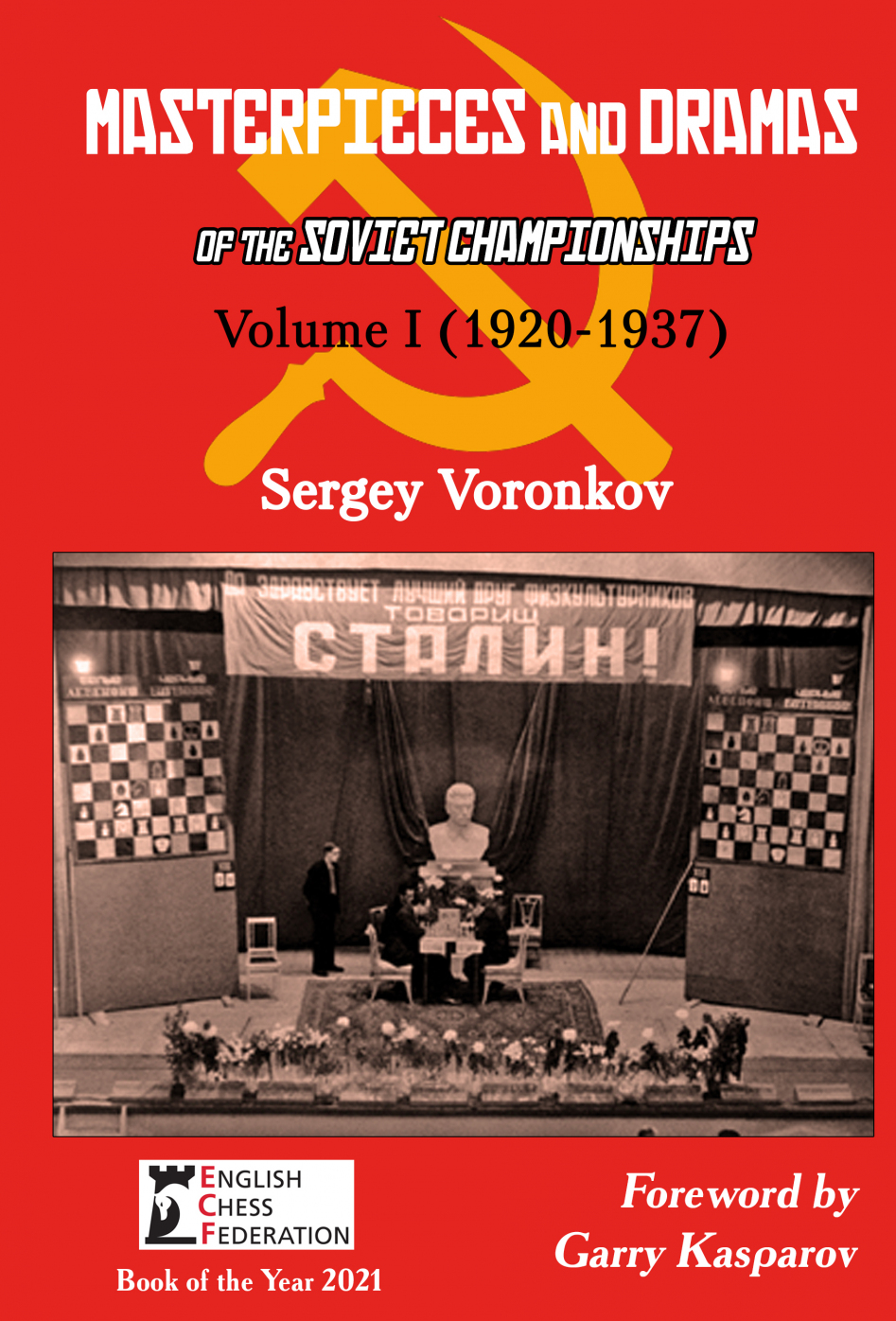
Masterpieces and Dramas of the Soviet Championships: Volume I (1920-1937), published in 2020 - in paperback, hardback, Amazon Kindle and Forward Chess
*****English Chess Federation Book of the Year 2021*****
In his three-volume treatise, leading Russian chess historian Sergey Voronkov vividly brings to life the long-forgotten history of the Soviet championships held in 1920-1953. Volume I covers the first 10 championships from 1920-1937, as well as the title match between Botvinnik and Levenfish. The key contestants also include world champion Alekhine and challenger Bogoljubov, lesser-known Soviet champions Romanovsky, Bogatyrchuk, Verlinsky, and Rabinovich, and names that today will be unfamiliar yet were big stars at the time: Riumin, Alatortsev, Makogonov, Rauzer, Ragozin, Chekhover, and many others.
This book can be read on many levels: a carefully selected collection of 107 of the best games, commented on mostly by the players themselves, supported by computer analysis. A detailed and subtly argued social history of the Soviet Chess School and of how chess came to occupy such an important role in Soviet society. A discussion of how the chess community lost its independence and came to be managed by Party loyalists. A portrayal of how the governing body and its leader, Nikolai Krylenko, strived to replace an entire generation of free-thinking chess masters with those loyal to the state. A study of how the authorities’ goals changed from wanting to use chess as a means of raising the culture of the masses to wanting to use chess to prove the superiority of the Soviet way of life. Or a sometimes humorous, often tragic history of talented, yet flawed human beings caught up in seismic events beyond their control who just wanted to play chess.
This book is illustrated with around 170 rarely seen photos and cartoons from the period, mostly taken from 1920s-1930s Russian chess magazines.
As Garry Kasparov highlights in his foreword “this book virtually resembles a novel: with a mystery plot, protagonists and supporting cast, sudden denouements and even ‘author’s digressions’ – or, to be exact, introductions to the championships themselves, which constitute important parts of this book as well. These introductions, with wide and precise strokes, paint the portrait of the initial post-revolutionary era, heroic and horrific at the same time. I’ve always said that chess is a microcosm of society. Showing chess in the context of time is what makes this book valuable even beyond the purely analytical point of view.”
Masterpieces and Dramas of the Soviet Championships: Volume II (1938-1947), published in 2021 - in paperback, hardback, Amazon Kindle and Forward Chess
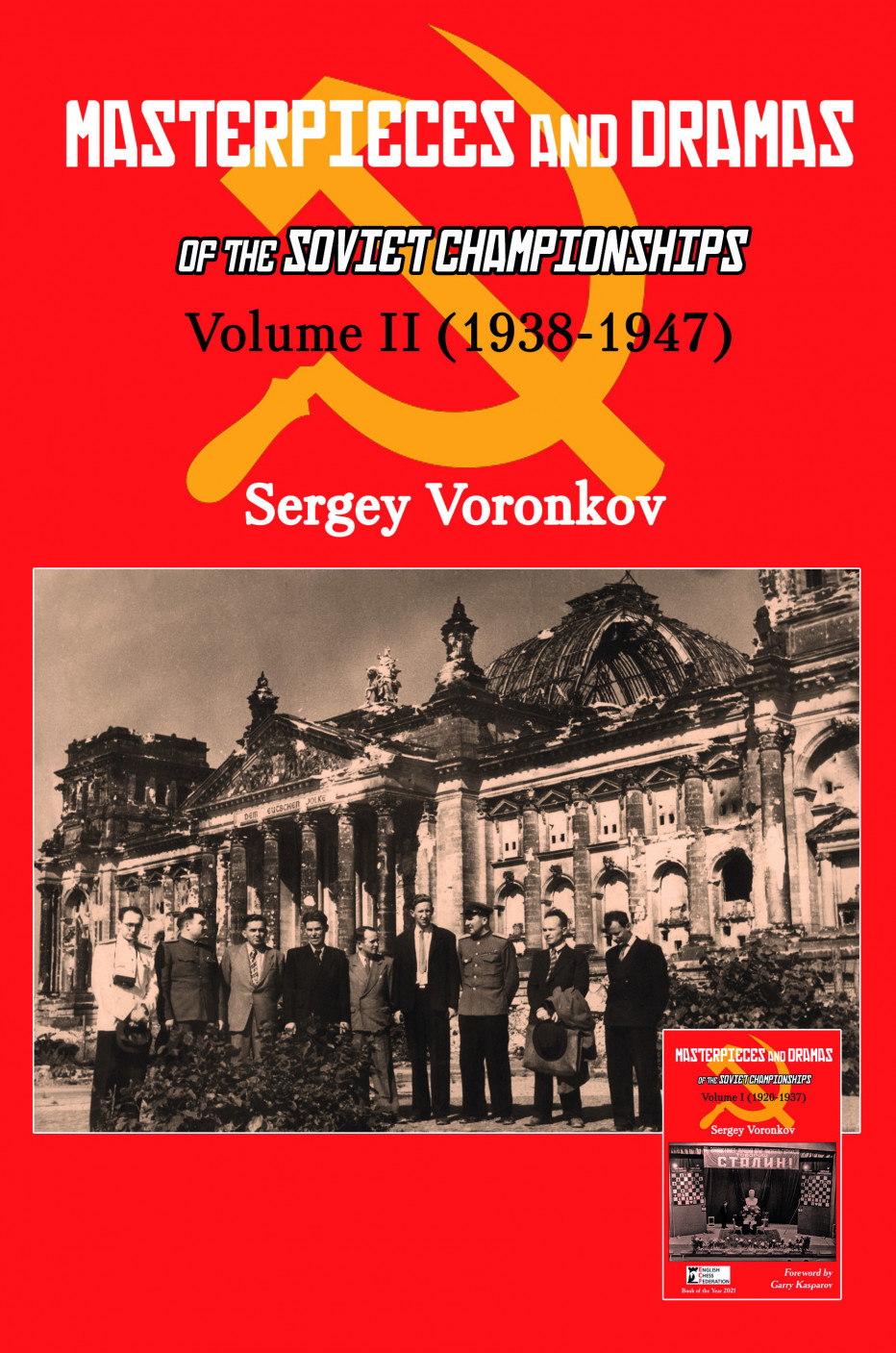
*****Short-listed for the FIDE Book of the Year prize 2022*****
The second part of Sergey Voronkov’s three-volume treatise continues from where Volume I left off. It covers the eleventh to fifteenth Soviet championships, the 1941 match tournament for the title of Soviet Absolute Champion, and the main events in the country’s chess history between these tournaments. Themes include the downfall of Nikolai Krylenko, the persecution and disappearance of Soviet chess players during the purges, and the experience of chess players in World War Two. The atmosphere of the time is captured in contemporary accounts and memoirs of key players and cultural figures.
We see Botvinnik and Keres established as leading challengers for Alekhine’s throne, with plans being made to arrange a title match. We encounter for the first time and witness the rise of great Soviet players such as Smyslov, Bronstein and Boleslavsky, and enjoy the games of many other stars including Flohr, Lilienthal, Bondarevsky, Kotov and Tolush.
This volume contains 84 games and fragments mostly annotated by the players themselves and their peers, and subjected to recent computer analysis. It is illustrated with around 250 photos and cartoons from the period, the main sources being Russian chess magazines and tournament bulletins.
Volume I of Masterpieces and Dramas of the Soviet Championships was named the English Chess Federation’s Book of the Year 2021. The jury stated: “The book reads like a novel… A most remarkable, absorbing and entertaining chess history which fully lives up to its title, Masterpieces and Dramas, on and off the board. A worthy winner of Book of the Year 2021 over strong competition.”
Masterpieces and Dramas of the Soviet Championships: Volume III (1948-1953), published in 2022 - in paperback, hardback, Amazon Kindle and Forward Chess
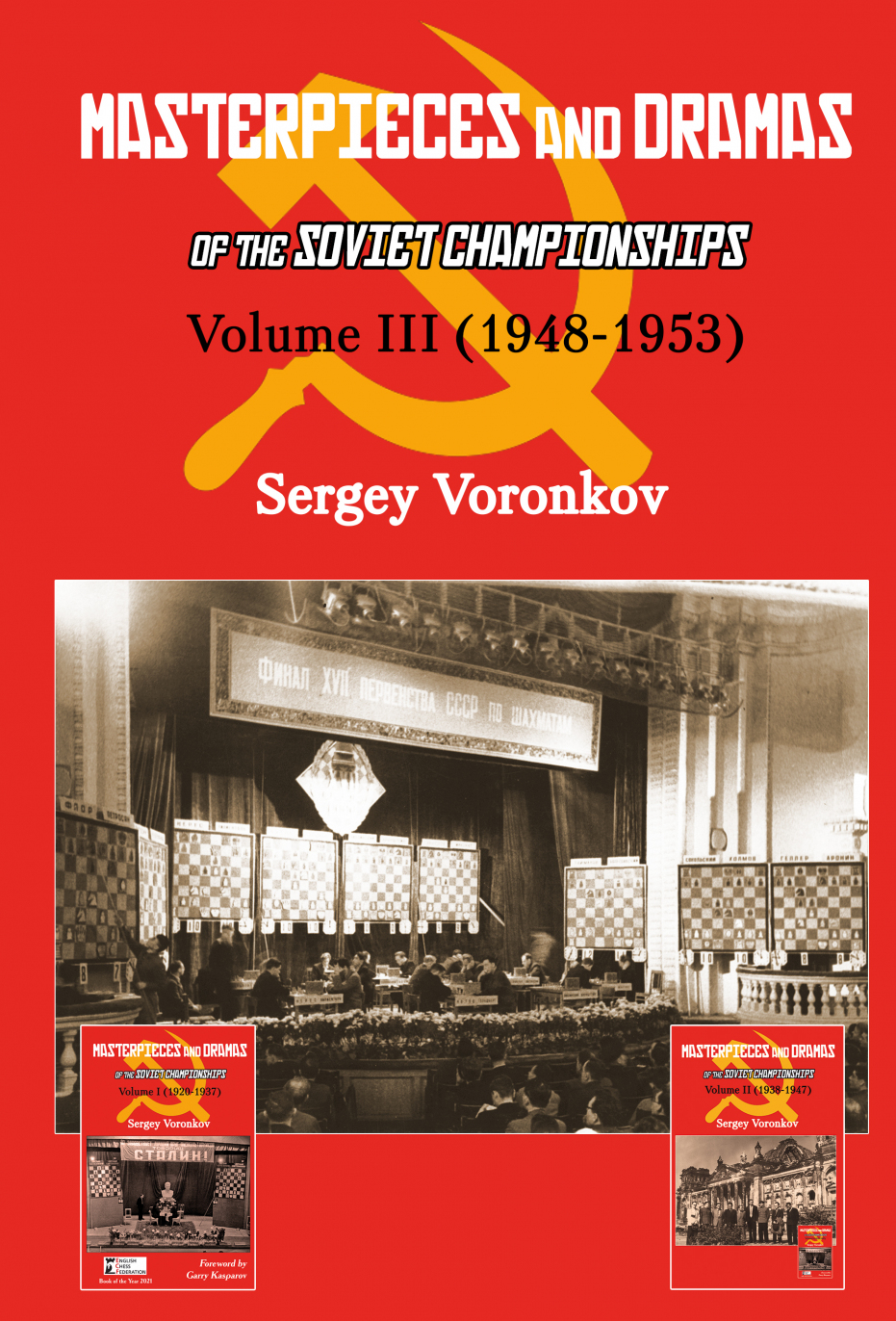
The third volume of Sergey Voronkov’s epic tale takes the reader on a historical journey through the late Stalinist period in the USSR. It covers in depth the five Soviet championships from 1948 to 1952 and the playoff match between Botvinnik and Taimanov in 1953, which concludes one month before Stalin’s death. Against a background of rampant anti-Semitism, a new wave of repressions and descent into the First Cold War, in which chess was an important front, the USSR captures the world chess crown and Botvinnik and the generation that followed him, including Smyslov, Keres, Bronstein, and Boleslavsky, assert their places at the top-tables of Soviet and indeed global chess. Yet a new group of legends begins to emerge, including Petrosian, Geller, Korchnoi, Taimanov, Averbakh, Simagin, Kholmov, and Furman making their championship debuts, as well as a semi-final appearance by Nikitin and Spassky’s first quarter-final. At the same time, the reader learns about lesser-known masters Yuri Sakharov and Johannes Weltmander, victims of Stalinism who found solace in chess from their otherwise tragic lives.
The present volume contains 77 games and fragments, once again mostly annotated by the participants and other contemporary masters, augmented with modern computer analysis. It is illustrated with over 220 photos and cartoons from the period. Many of these photos come from unique archives, including that of David Bronstein, and are published for the first time.
Alexander Alekhine - The Russian Sphinx: Volume I (1892-1921), published in 2025 - in paperback, hardback, Amazon Kindle and Forward Chess

Award-winning historian Sergey Voronkov has written a four-volume psychological biography of Alexander Alekhine, presenting the former world chess champion in a much more complicated, conflicted and tragic light than you have ever seen him before! This first volume traces his early development through to his departure from Soviet Russia in 1921, while also attempting to untangle the knot of his complex relationships with all his five wives.
Unpublished or long forgotten memoirs, as well as original newspaper and magazine articles from around the world, are drawn together in forensic research to paint the most extensive picture of Alekhine ever created. Key events in his life are reconsidered, including his release from internment in Germany during World War 1, his escape from execution in Odessa, his service under the Bolsheviks as a detective, his trip to the Urals as a Comintern translator, as well as just how he emigrated.
His character development is considered beginning with a detailed examination of his childhood, based on memoirs of his classmates. Voronkov then considers Alekhine’s transition from shy boy to dandy (and even the role played in that by his erstwhile friend José Capablanca), as well as how our protagonist gained the mental toughness of a world champion, and his chess philosophy. Some details make you admire him, others make you pity him, still others cast him in an unfavorable light...
Chess-wise, Voronkov presents over 50 games and fragments with original commentary by Alekhine and his opponents, most of which has not been published in books before. These include eleven completely unknown Alekhine games as well as ten game scores of other players with light commentary by Alekhine from the first Soviet Championship in 1920, found in Alexander Kotov’s archive.
In many cases, Alekhine’s earliest annotations are compared with his later ones to the same games, often leading to surprising conclusions. In particular, Voronkov highlights brilliant variations shown in Alekhine’s analysis that were supposedly found during play but which were actually discovered by the champion only years later when he republished his games. This led to Alekhine radically changing his assessments of positions in his writings as the years passed. We also see how Kotov had a habit of taking Alekhine’s commentary and presenting it as his own.
This book is illustrated by over 170 photos and other visuals, many published for the first time.
YouTube review by Grandmaster Danny Gormally
Interview with Magnus Carlsen by Levitov Chess, where Carlsen mentions enjoying reading Masterpieces and Dramas of the Soviet Championships, Volume I.
Tibor Karolyi
International Master Tibor Karolyi is a former Hungarian chess champion. His book Endgame Virtuoso Anatoly Karpov won the Guardian Chess Book of the Year Award in 2007. He has written books on many great players’ careers, including Kasparov, Karpov, Tal, Portisch and Judit Polgar, as well as Tigran Petrosian and Viktor Korchnoi. He has coached Peter Leko, Olympic champions Sofia Polgar and Ildiko Madl, and Olympic silver medalist and European Community champion Zoltan Gyimesi. Five of his junior pupils have won a total of nine world championship medals for their age groups. He is twice the Senior World Champion at Racketlon.
Hans Renette
Hans Renette, a FIDE Master with two International Master norms, is a historian and chess coach. He has written chess biographies of the great players Emanuel Lasker, Henry Edward Bird, Louis Paulsen, Gustav Neumann and John Wisker as well as Viktor Korchnoi.
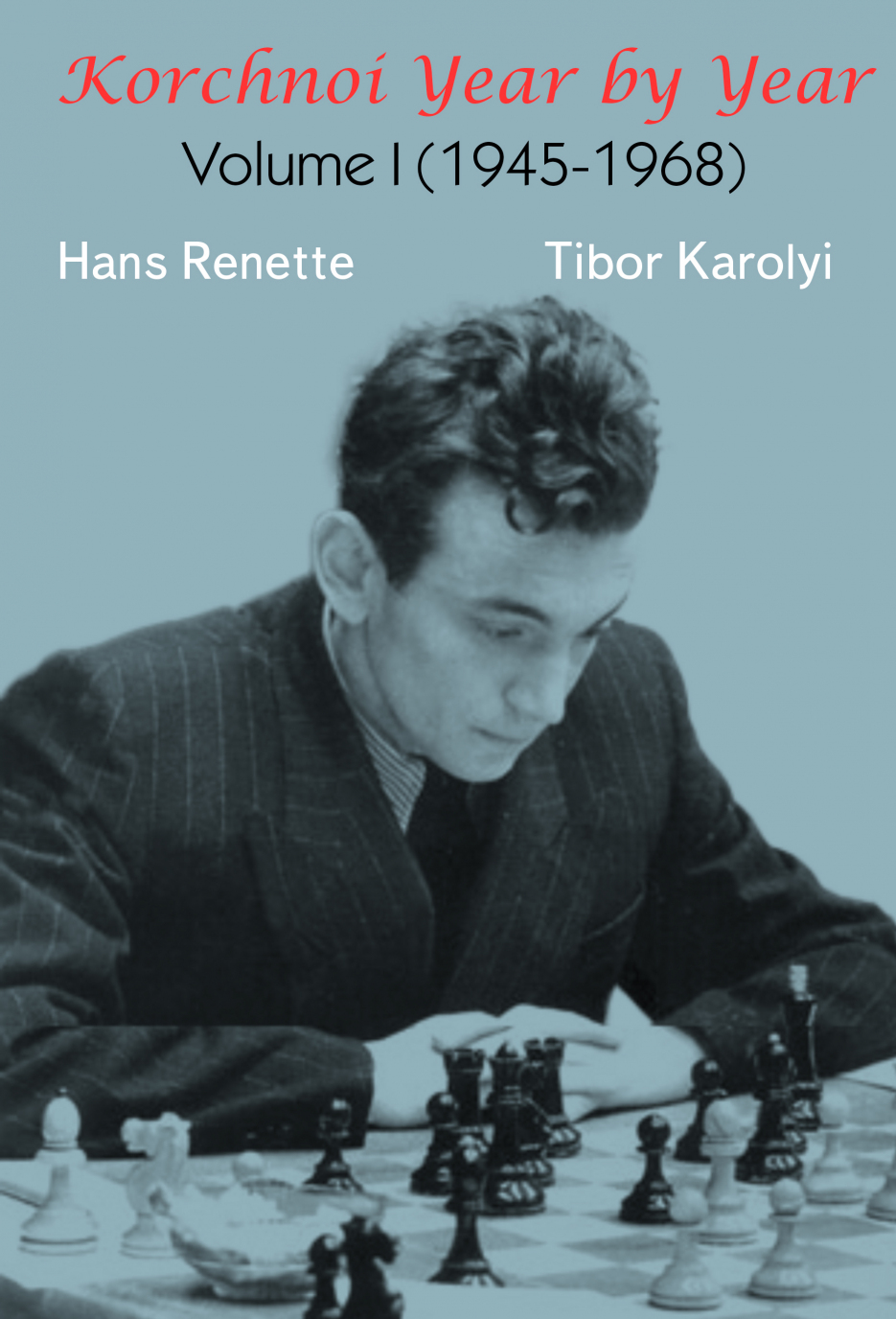
Korchnoi Year by Year: Volume I (1945-1968), published in 2023 - in paperback, hardback, Amazon Kindle and Forward Chess
Viktor Korchnoi (1931 to 2016) was a giant of the chess world with a career embracing seventy years and over 5,000 recorded games. He contested two world championship matches against Anatoly Karpov, coming within a whisker of being crowned World Champion in 1978. He was a world championship candidate, Soviet champion and Olympiad medal-winner on numerous occasions.
In this first of four volumes on Viktor Korchnoi’s chess career, FIDE Master Hans Renette and International Master Tibor Karolyi deeply analyse 181 games and fragments up until 1968. This period encompasses his bitterly tough childhood involving the Second World War and poverty, the death of his father and grandmother, his mother’s mental health problems and his loyal support from his step-mother, but also his chess beginnings and early coaches, his marriage and the birth of his son. We learn about his early rivalry with Mark Taimanov and Boris Spassky in Viktor’s hometown of Leningrad (now St. Petersburg), and his later rivalry with Mikhail Tal and Tigran Petrosian. He exchanged blows with Bobby Fischer on equal terms.
Korchnoi won three of his four Soviet championship titles during this period, for the first time in 1960, and according to Chessmetrics rating calculations he began a four-month stint as world number 1 in 1965. He played at the 1962 candidates tournament in Curacao and reached the 1968 candidates final versus Spassky. This volume concludes with two of Korchnoi’s most impressive international tournament wins, at Wijk aan Zee and Palma de Mallorca in 1968.
The work is supplemented with a generous portion of photos taken in particular from Soviet-era chess publications and the Korchnoi family archive.
Korchnoi Year by Year: Volume II (1969-1980), published in 2024 - in paperback, hardback, Amazon Kindle and Forward Chess

***Short-listed for the English Chess Federation 2024 Book of the Year Prize!!***
The second volume of Elk and Ruby’s treatise on Viktor Korchnoi, penned by FM Hans Renette and IM Tibor Karolyi, covers the period 1969-1980. This encompasses Korchnoi’s famous world championship fight with Karpov at Baguio City in 1978, his candidates final matches against Karpov in 1974 and Hubner in 1980, as well as the related candidates cycles and major tournament performances. Much biographical colour is supplied on his life and character, with this period including his defection from the Soviet Union to the West in 1976. Like in Volume I, original material is provided from interviews with key protagonists and their relatives, while sources in Russian, German, Dutch and Hungarian as well as English are used to paint the most comprehensive portrait of Korchnoi available.
140 games and fragments are analysed in detail in this work. As well as Karpov and Hubner, opponents include Fischer, Spassky, Petrosian, Smyslov, Portisch, Geller, Najdorf, Timman, Larsen, Mecking, Sosonko, Andersson, Ljubojevic, Polugaevsky, Nunn, and Miles among others. Many new discoveries are made in the analysis. In particular, the authors identify that Korchnoi worked hard to improve his endgame ability significantly during the time that he was boycotted in tournaments by the Soviets, which is most surprising given that he was in his mid-forties by then, and was the best player of his time at endgame tactics. Further, the authors found that his reputation as a pawn grabber was highly exaggerated, and that he carried out a huge number of king attacks on the h-file. They also discovered that Korchnoi more than matched Karpov for openings in the 1978 title bout despite the unprecedented preparation of the Soviet chess machine, and that the key reason he lost that match was time trouble.
The book is supplemented with a generous supply of photos, many taken from the Korchnoi family archive and never before published.
Korchnoi Year by Year: Volume III (1981-1991), published in 2024 - in paperback, hardback, Amazon Kindle and Forward Chess

Paperback

Hardback
The third volume of Elk and Ruby’s treatise on Viktor Korchnoi, penned by FM Hans Renette and IM Tibor Karolyi, covers the period 1981-1991. This encompasses Korchnoi’s famous world championship match with Karpov at Merano in 1981, his candidates matches against Portisch and Kasparov in 1983, Hjartarson in 1988 and Sax and Timman in 1991, as well as the candidates tournament of 1985 at Montpellier, the GMA world cup series and major tournament performances. Much biographical colour is supplied on his life and character, with this period including his family’s arrival from the Soviet Union to the West in 1982 and its subsequent breakup. Like in volumes I and II, original material is provided from interviews with key protagonists and sources from a wide range of languages are used.
140 games and fragments are analysed in detail in this work. Other opponents include Tal, Spassky, Ivanchuk, Topalov, Gulko, Larsen, Sosonko, Seirawan, Ribli, Torre, Yusupov, Van der Wiel, Van der Sterren, Andersson, Polugaevsky, Nunn, Miles, Short, Speelman, and Beliavsky, among others.
The book is supplemented with a generous supply of photos, some taken from the Korchnoi family archive and never before published.
Korchnoi Year by Year: Volume IV (1992-2016), published in 2025 - in paperback, hardback, full-colour hardback, Amazon Kindle and Forward Chess
The fourth and final volume of FM Hans Renette and IM Tibor Karolyi’s treatise on the life and games of Viktor Korchnoi will surprise you. Covering the period from 1992 until the maestro’s death in 2016 at the age of 85, it contains a bumper 208 highly instructive games and fragments. Fighting games, attacks, endgames, theoretical battles, time scrambles, classical and rapid – it has the lot.
And Korchnoi was no weakling in his incredible late career! He won the category 16 Madrid tournament in 1995 at the age of 64 ahead of Short, Salov, Yusupov, Polgar and Timman among others. His first place at Sarajevo in 1998 saw him achieve a tournament performance rating of 2831 at the age of 67. He was the highest-rated 70-year old ever with an Elo of 2639 in 2001. In that same year he won the category 17 double-round robin tournament at Biel, ahead of Gelfand, Svidler, Lautier, Grischuk and Pelletier. In 2004 he achieved a tournament performance rating of nearly 2800 in the city of Paks, Hungary, at the age of 73.
Viktor was still unleashing opening novelties in his late 70s, playing tournaments around the world and winning some of them. Notably, he was World Senior Champion in 2006 and was ranked in the world’s top hundred as late as 2007, when aged 75. He became Swiss champion for the fifth time in 2011 at the age of 80 and he even introduced a novelty in a game with Uhlmann in 2015 when aged almost 84.
This book contains games against Magnus Carlsen (whom he beat in 2004), Fabiano Caruana (whom he beat in 2011), Kasparov, Karpov, Spassky, Gelfand, Timman, Short, Ponomariov, Yusupov, Svidler, Uhlmann, Hort, Beliavsky, Piket, Speelman, Tiviakov, Adams, Sadler, Romanishin, Vallejo, Vasiukov, Sutovsky, Gashimov, Ashley, and the legendary trainer Mark Dvoretsky among many others.
It also contains 80 tournament and family photos, the vast majority of them published in a book for the first time. This book comes in B/W paperback, B/W hardback and full-colour hardback. In the full-colour version of the book, 70 of these photos are in colour.


YouTube review by Grandmaster Danny Gormally
Tigran Gyozalyan
FIDE Master and FIDE Trainer Tigran Gyozalyan was born in 1957 in Armenia. A multiple participant in the Higher Leagues of the Armenian Championship, he took 4th place in 1981 and was 4th equal in 1984. He was also champion of the Moscow Trade Union Olympiad in 1976. He is the author of The King is a Powerful Piece! published in 2017.
Tigran has been training juniors for 25 years. Among his pupils, Grandmaster Samvel Ter-Sahakyan has won European and world championships for his age group, and Derek Lim was World Schoolboys Champion. Other pupils include WIM Narine Gasparian, WIM Liana Aghabekian, and FM Lee Qing Aun. In 1979, Petrosian kindly gave Gyozalyan chess lessons and they formed a close relationship.
Since 2005 he has been working as a chess coach in Singapore. His website is royalchess.sg.
Petrosian Year by Year: Volume I (1942-1962), published in 2020 - in paperback, hardback, Amazon Kindle and Forward Chess
Petrosian Year by Year: Volume II (1963-1984), published in 2022 - in paperback, hardback, Amazon Kindle and Forward Chess
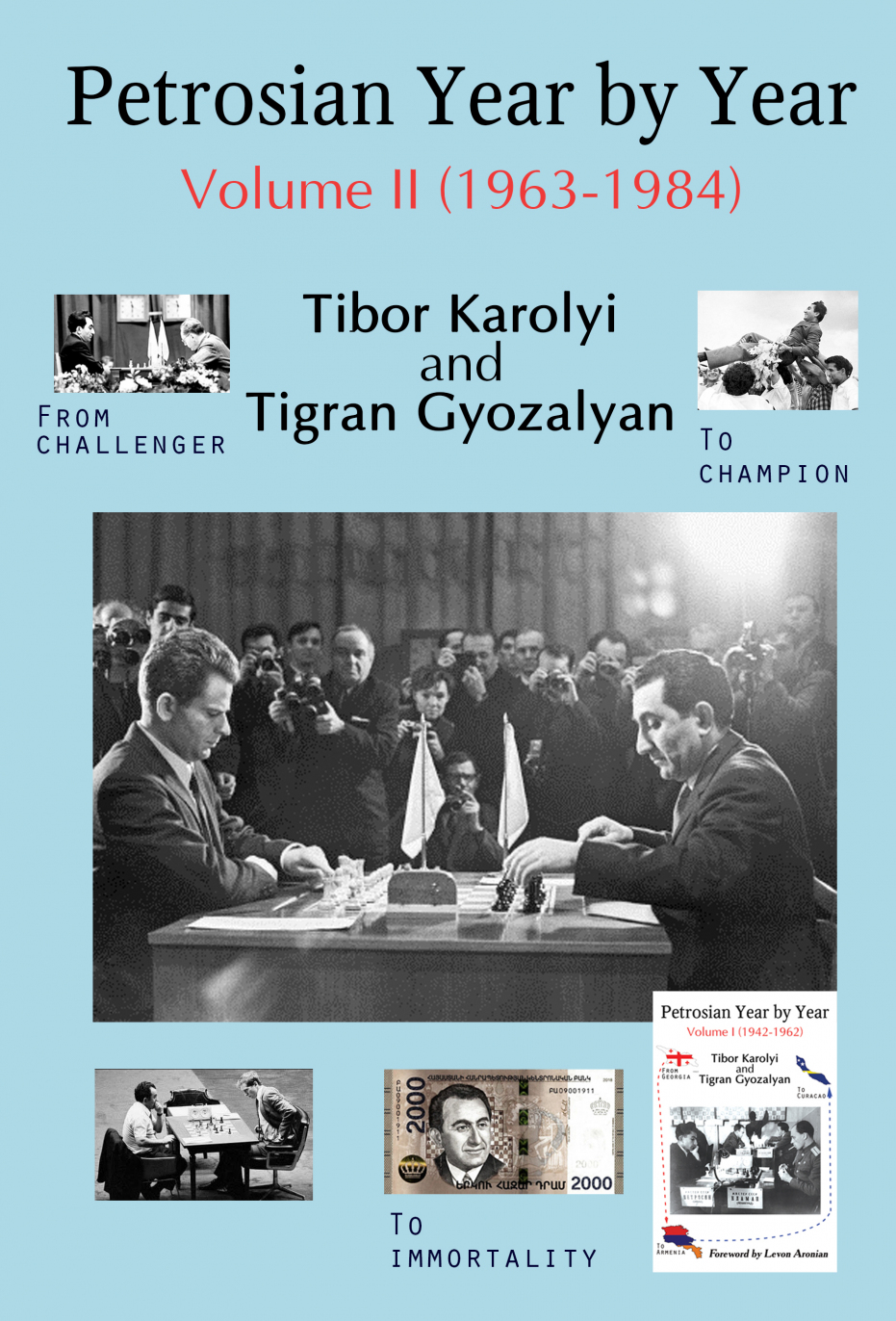
International Master Tibor Karolyi and FIDE Master Tigran Gyozalyan have written a comprehensive two-volume treatise on the life and games of Tigran Petrosian, who was world champion from 1963-1969. The present Volume II takes the reader on a journey from Tigran’s victory in the 1963 world title match against Mikhail Botvinnik, when he firmly established himself as the best player in the world, through his next two title matches against Boris Spassky in 1966 and 1969 and subsequent candidates matches against Bobby Fischer, Victor Korchnoi and other world-class players of the era. It covers all his tournaments and matches of the second half of his career, ending with his final games in 1983.
Karolyi and Gyozalyan provide deep modern analysis of 175 full games and fragments, and summarise almost all known games played by Petrosian in the period. They also provide considerable background colour on each game, with round-by-round analysis of tournaments and matches in which they were played. Many of these games have not previously been analysed in detail in modern books, and those that were have nevertheless been subjected to considerably improved analysis.
Petrosian’s opponents in Volume II include world champions and challengers Kasparov, Karpov, Fischer, Spassky, Tal, Smyslov, Botvinnik, Korchnoi, and Bronstein, as well as leading players such as Timman, Larsen, Reshevsky, Beliavsky, Polugaevsky, Portisch, Romanishin, and many others. There is a special focus on his coaches Suetin and Zaitsev.
An added bonus is the inclusion of rare photos taken from private collections in Georgia and Armenia, many of which have never before been published in the West.
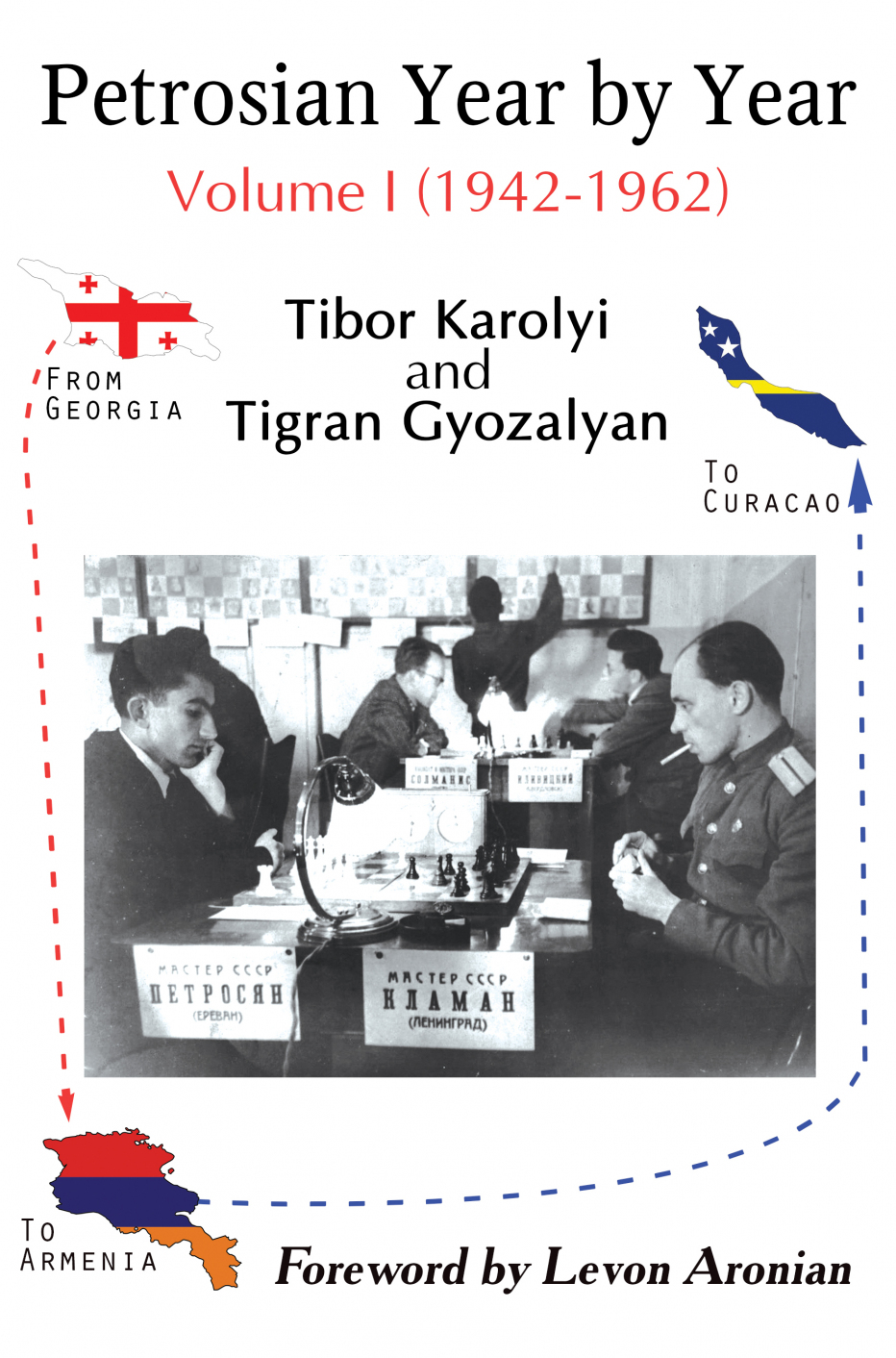
International Master Tibor Karolyi and FIDE Master Tigran Gyozalyan have written a comprehensive two-volume treatise on the life and games of Tigran Petrosian, who was world champion from 1963-1969. The present Volume I takes the reader on a journey from Tigran’s childhood, through the war years, successes in Georgian and Armenian national championships, his emergence as an elite player winning the Soviet championship and Olympic gold, and victory at the famous 1962 Candidates Tournament in Curacao.
Karolyi and Gyozalyan provide deep modern analysis of 148 full games and fragments, and summarise almost all known games played by Petrosian in the period. They also provide considerable background colour on each game, with round-by-round analysis of tournaments and matches in which they were played. Very few of these games have previously been analysed in detail in modern books, and those that were have nevertheless been subjected to considerably improved analysis.
Petrosian’s opponents in Volume I include world champions and challengers Fischer, Tal, Spassky, Botvinnik, Smyslov, Euwe, Korchnoi, and Bronstein, as well as leading players such as Keres, Geller, Benko, Polugaevsky, Reshevsky, Taimanov, Kotov, Gligoric, and many others. There is a special focus on his coaches Ebralidze, Lilienthal and Boleslavsky.
An added bonus is the inclusion of rare photos taken from private collections in Georgia and Armenia, many of which have never before been published in the West.
With a foreword by the greatest Armenian chess player of modern times Levon Aronian.
YouTube review by Grandmaster Danny Gormally
Alexander Nikitin
Alexander Nikitin (1935-2022) coached Garry Kasparov from 1973 until 1990. He was Kasparov’s chief second in his candidates and world championship matches from 1983-1987. In 1992 Nikitin seconded Boris Spassky during the latter’s return match against Bobby Fischer, and later in the 1990s he coached the young Etienne Bacrot. Other illustrious former pupils include Grandmaster Dmitry Jakovenko.
At just 17 years of age Nikitin became one of the youngest USSR masters of sport in chess, in 1952. He was awarded the title of International Master in 1992. Nikitin gained the titles of honored trainer of the Azerbaijan Soviet Socialist Republic in 1980 and of the USSR in 1986. He became FIDE Senior Trainer in 2004. Nikitin participated in several Moscow championships, and his best result was sharing 2nd-5th places in 1954. He also played in the USSR championship in 1959. As a member of the Soviet team he won the student world championship in 1955, 1957 and 1958. Nikitin shared 3rd-4th places together with Razuvaev and ahead of Taimanov at the Botvinnik Memorial veterans tournament, held in Elista in 2002. He was a senior trainer in the Petrosian School from 1977 to 1993, which he ran from 1984 after the ex-world champion’s death. Super grandmasters that Nikitin coached at the school include Levon Aronian, Alexander Grischuk and Boris Gelfand.
He was the author of a number of chess books in several languages, including on opening theory. In the 2000s, Nikitin assisted Kasparov in producing the latter’s autobiographical works.
Coaching Kasparov, Year by Year and Move by Move, Volume II: The Assassin (1982-1990), published in 2020 - in paperback, Amazon Kindle and Forward Chess
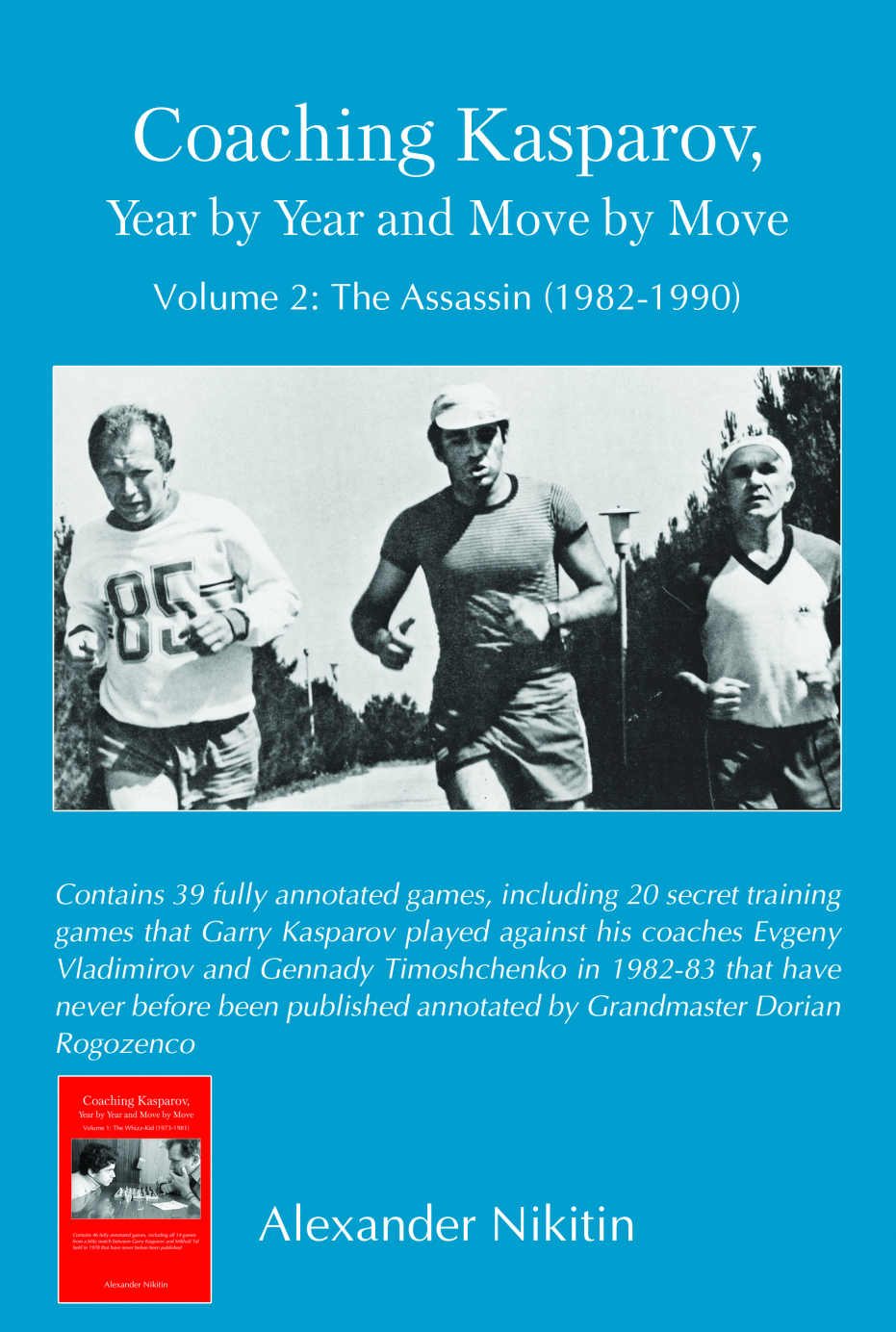
Coaching Kasparov, Year by Year and Move by Move, Volume I: The Whizz-Kid (1973-1981), published in 2019 - in paperback, Amazon Kindle and Forward Chess
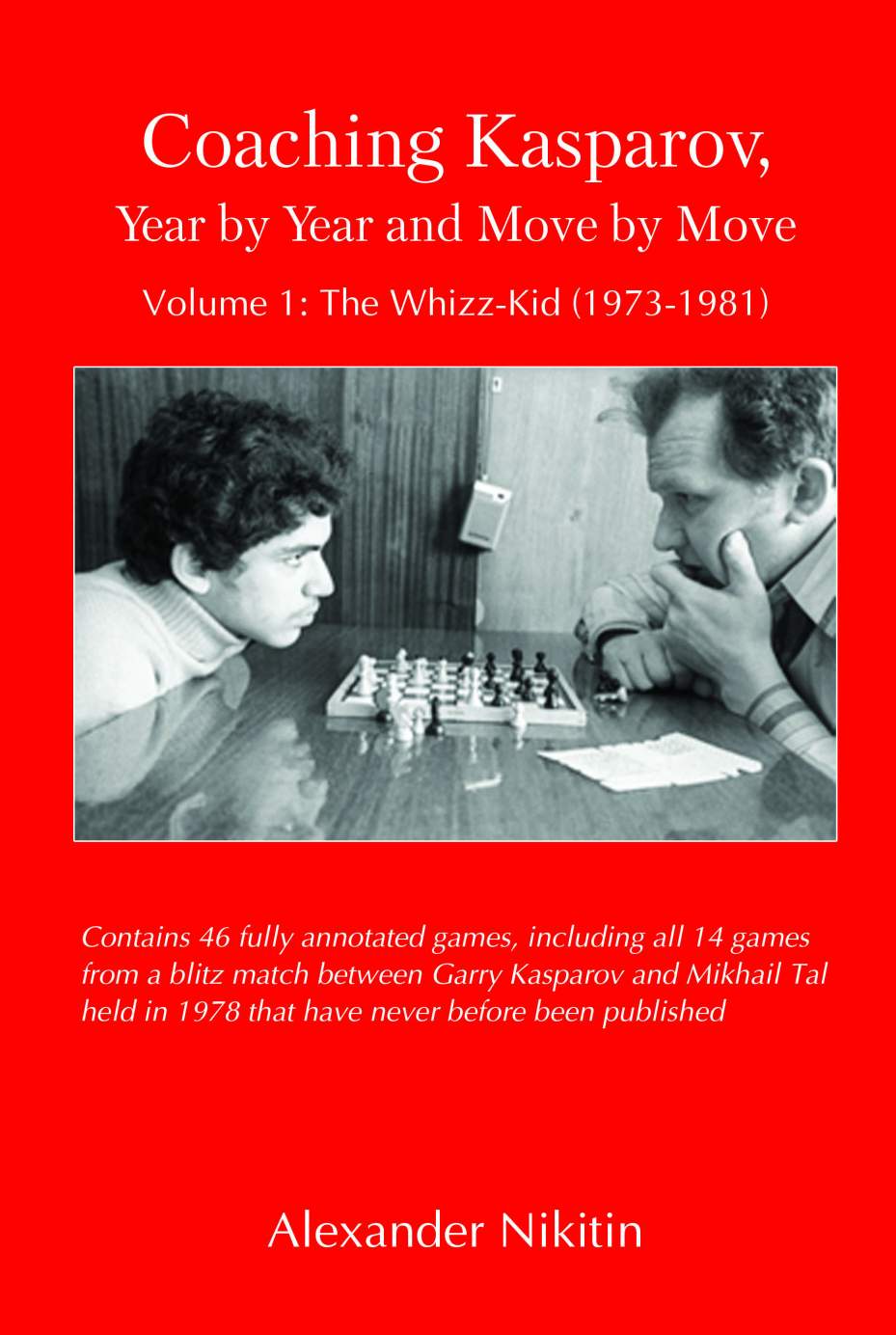
*****Short-listed for the English Chess Federation Book of the Year Award 2020*****
In Coaching Kasparov, Year by Year and Move by Move Garry Kasparov’s long-term coach, second and mentor Alexander Nikitin tells the story of how he trained Kasparov from a brilliant but raw junior into becoming and then remaining the world champion. Volume I, the present work, covers the period 1973-1981, until Kasparov reached the age of 18. The author goes to great lengths to describe his educational approach during the early period to raise Kasparov’s theoretical knowledge and practical performance, covering both play and psychological training.
In Nikitin’s blow-by-blow tournament accounts he describes how he handled various unexpected situations to get the best out of Kasparov with detailed recipes. His numerous insights will be of great interest to today’s chess coaches who wish to take a comprehensive approach to improving their pupils’ performances.
The present volume contains 46 games fully annotated by Nikitin, including all 14 games of a blitz match played between the 15-year old Kasparov and ex-world champion Mikhail Tal on 26 December 1978 in Tbilisi that have never before been published and which are provided specially for the 2019 edition of this book.
Most of the other games are well known, but Nikitin explains many of Kasparov’s decisions in those games from the point of view of the future world champion’s coach, providing the context of his young pupil's thought process and mistakes and tracing his progress. He also uses these games to illustrate and expand upon his coaching advice. This makes his commentary quite unique and instructive, of formidable practical use to budding players, coaches and parents.
Evgeny Vasiukov, Chess Champion of Moscow (2020) - in paperback, Amazon Kindle and Forward Chess
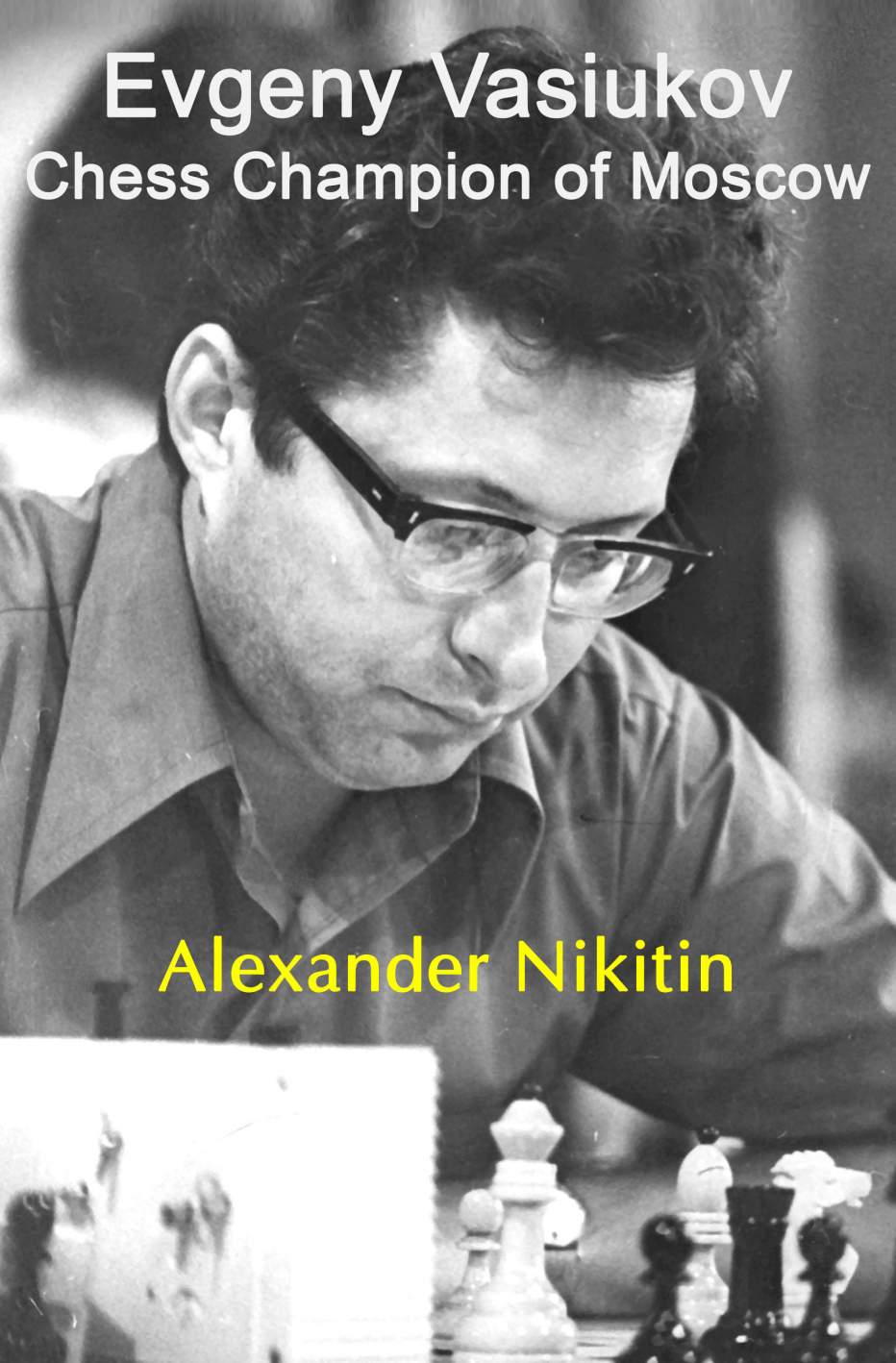
In this book his life-long friend and sparring partner, Garry Kasparov’s long-term coach Alexander Nikitin, presents a selection of games illustrating Vasiukov’s career and legacy. Opponents in this games collection include world champions and challengers Tigran Petrosian, Boris Spassky, Tal, Smyslov, Bronstein and Korchnoi, as well as other leading players such as Lev Alburt, Alexander Morozevich, Mark Taimanov, Portisch and Geller, among others. Readers will find the annotations both highly instructive and entertaining, in an informal style.
Evgeny Vasiukov (1933-2018) was a top-level grandmaster from Moscow who won the Moscow championship 6 times, and over 50 major tournaments in total, including the strong Manila 1974 tournament ahead of Bent Larsen, Lajos Portisch and Svetozar Gligoric. He participated in 11 Soviet championships and was a coach and aide to Anatoly Karpov, Mikhail Tal, David Bronstein, Viktor Korchnoi and Efim Geller among other famous players. In particular, he was part of Karpov’s team of seconds in the world championship matches against Korchnoi in 1978 and Kasparov in 1984 and 1985. In 1995 he won the world senior chess championship. His play was notable for an attacking approach with swashbuckling combinations in the style of Mikhail Chigorin, as well as innovations in offbeat openings such as 2.d3 against the French Defense. He boasted positive career scores against Vasily Smyslov, Larsen and Bronstein.
*****Short-listed for the English Chess Federation Book of the Year Award 2020*****
In Coaching Kasparov, Year by Year and Move by Move Garry Kasparov's long-term coach, second and mentor Alexander Nikitin tells the story of how he trained Kasparov from a brilliant but raw junior into becoming and then remaining the world champion. Volume II, the present work, covers the period 1982-1990, including the first four world championship matches against Karpov and the candidates matches against Smyslov, Korchnoi and Beliavsky.
The present volume contains 39 fully annotated games. These include 20 secret training games that Kasparov played against his grandmaster coaches Evgeny Vladimirov and Gennady Timoshchenko in 1982-83 that have never before been published and which are annotated by Grandmaster Dorian Rogozenco, national coach of the German Chess Federation and captain of the German national team. These games are provided by the Kasparov family specially for the 2020 edition of this book. The reader has a unique opportunity to gain an insight into Kasparov's secret preparation in those years, which were a new starting point in his career: he had to adjust his openings. Rogozenco is a big expert on Kasparov's games, having helped FIDE World Champion Ruslan Ponomariov prepare for his planned match against Kasparov in 2003.
Kasparov's legendary opening repertoire, which was to define trends in chess theory for decades, was created not just through deep analysis, but also via training games. The never previously published material in this book consists of 16 games with classical time control and 4 rapid thematic games. Testing the Catalan for the first time with white, searching for ideas in the King's Indian with black, preparing the Queen's Gambit with both colors, playing typical Sicilian positions and trying new openings (for instance the Tarrasch as the big surprise for his candidates match versus Beliavsky) - all this can be found in these games.
Further, the time records on most of Kasparov's original scoresheets (all of them pictured in this book) show that Kasparov and his coaches paid serious attention to such an important training aspect as the distribution of time during the game.
From intuitive positional sacrifices to precisely calculated combinations and instructive play in typical pawn structures - the training games provide a lot of interesting material for both players and coaches.
The other games, annotated by Nikitin, are well known, but Nikitin explains many of Kasparov's decisions in those games from the point of view of the world champion's coach, providing the context of his pupil's thought process and mistakes and tracing his progress as they together gradually out-thought Korchnoi and then Karpov. He also uses these games to illustrate and expand upon his coaching advice. His many insights include the preparation of the “cross-fire” strategy (playing the same opening against the same opponent with both colors) and a systematic approach to maintaining time discipline during games based on chronometric analysis. This makes his commentary quite unique and instructive, of formidable practical use to budding players, coaches and parents.
Zenon Franco
Grandmaster and FIDE Senior Trainer Zenon Franco was born in Asuncion, Paraguay, in 1956. After living in Buenos Aires he moved to Spain, where he lived until his death in 2024. Zenon was the author of over 30 chess books published in many languages and was a regular chess columnist of the Paraguayan Hoy and ABC newspapers for two decades. He also wrote regularly for several chess magazines in Argentina, Italy and Spain. In 2017, he received the 2016 Isaac Boleslavsky book of the year award from the FIDE Trainers Commission.Zenon was Pan-American Champion in 1981 (San Pedro de Jujuy, Argentina). He participated in 11 Olympiads, from Haifa, Israel, in 1976, to Batumi, Georgia, in 2018. Zenon won the individual Gold Medal for the best result on first board at the Olympiads of Lucerne, Switzerland, 1982, and Novi Sad, Yugoslavia, 1990. He also represented Spain at the 1998 Olympiad in Elista, Russia.
Magnus Wins With White (2020) - in paperback, Amazon Kindle and Forward Chess
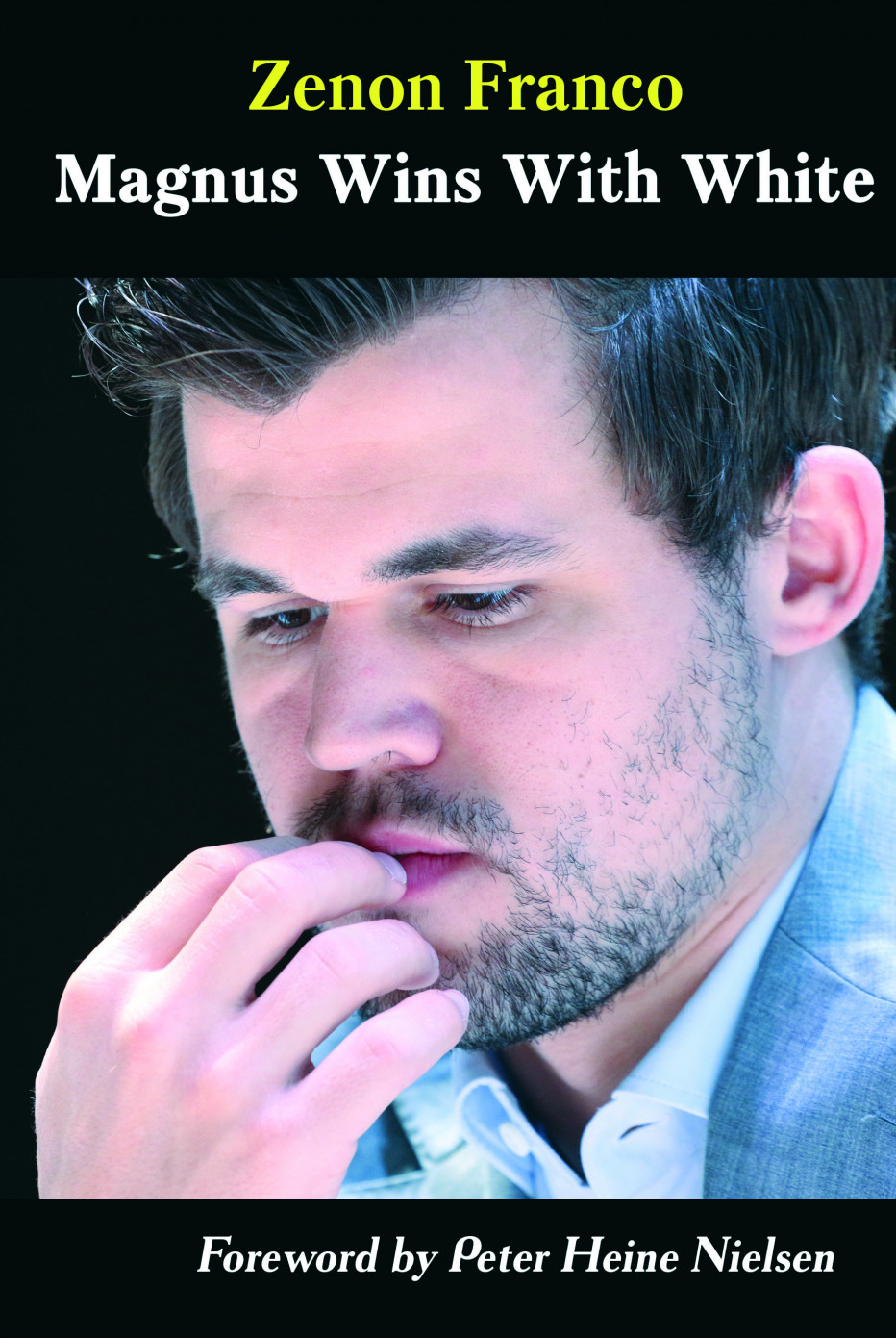
In Magnus Wins With White Grandmaster Zenon Franco deeply analyses 32 of Magnus Carlsen’s most instructive games where he wins with the white pieces. This book is written in “move by move” style, a good training tool containing exercises and tests. This format is a great platform for studying chess, improving both skills and knowledge, as the reader is continually challenged to find the best moves and the author provides answers to probing questions throughout.
Most of the games are taken from Magnus’s recent career, including one from 2020 and eight from 2019. His opponents are nearly all super-grandmasters, and they include former world champions Viswanathan Anand and Vladimir Kramnik, as well as Wesley So, Maxime Vachier-Lagrave, Alexander Grischuk, Levon Aronian, Boris Gelfand, and, naturally, Anish Giri. In the majority of these games, Magnus demonstrates his ability to outplay his opponents in the middlegame by simply making stronger moves and applying constant pressure that eventually forces the opponent to crack and play weaker moves. In some games, however, this takes place in the endgame.
With a foreword by Magnus Carlsen's Chief Second and Coach Peter Heine Nielsen.
To buy in India at local prices reach out to our local partner Citadel Chess World - 98848 00162 Shrinidhi, 97811 68668 Padmaavati.
Magnus Wins With Black (2020) - in paperback, Amazon Kindle and Forward Chess
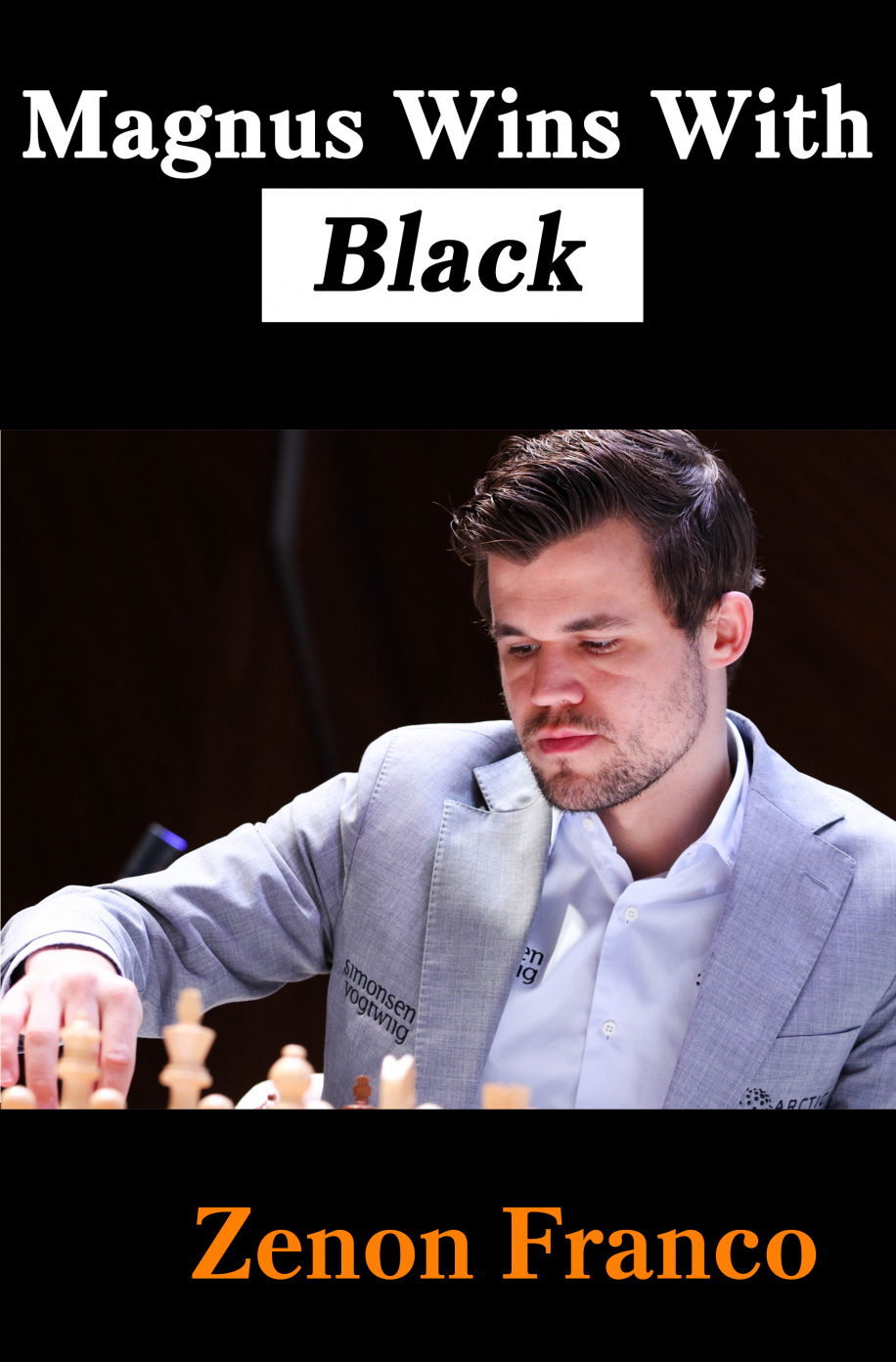
In Magnus Wins With Black Grandmaster Zenon Franco deeply analyses 30 of Magnus Carlsen’s most instructive games where he wins with the black pieces. This book is written in “move by move” style, a good training tool containing exercises and tests. This format is a great platform for studying chess, improving both skills and knowledge, as the reader is continually challenged to find the best moves and the author provides answers to probing questions throughout. It is the second of two volumes written by Franco for Elk and Ruby Publishing House on the games of Magnus Carlsen. His first volume Magnus Wins With White has proved to be an international best seller.
The main difference between these games and those in the previous book is that fewer of them are attacking games than when Carlsen plays White. This should not come as a surprise, because White has more chances to dictate the game scenario. Nevertheless, there are still some examples in this volume where Carlsen wins by attack. Another important difference is that there are more endings in this volume, which is also understandable.
What remains unchanged is that the fights are always intense. Carlsen never stops trying to win the game, no matter if, objectively, his chances are small. There are several examples where, at some point, his opponents collapse, unable to withstand the tension that Carlsen maintains in the game.
Most of the games are taken from Magnus’s recent career, including one from 2020 and six from 2019. His opponents are nearly all super-grandmasters, and they include former world champions Viswanathan Anand and Vladimir Kramnik, as well as Fabiano Caruana, Maxime Vachier-Lagrave, Alexei Shirov, Levon Aronian, Ding Liren, Ian Nepomniachtchi, and Anish Giri.
To buy in India at local prices reach out to our local partner Citadel Chess World - 98848 00162 Shrinidhi, 97811 68668 Padmaavati.
Nail It Like Nepo!: Ian Nepomniachtchi’s 30 Best Wins (2021) - in paperback, Amazon Kindle and Forward Chess
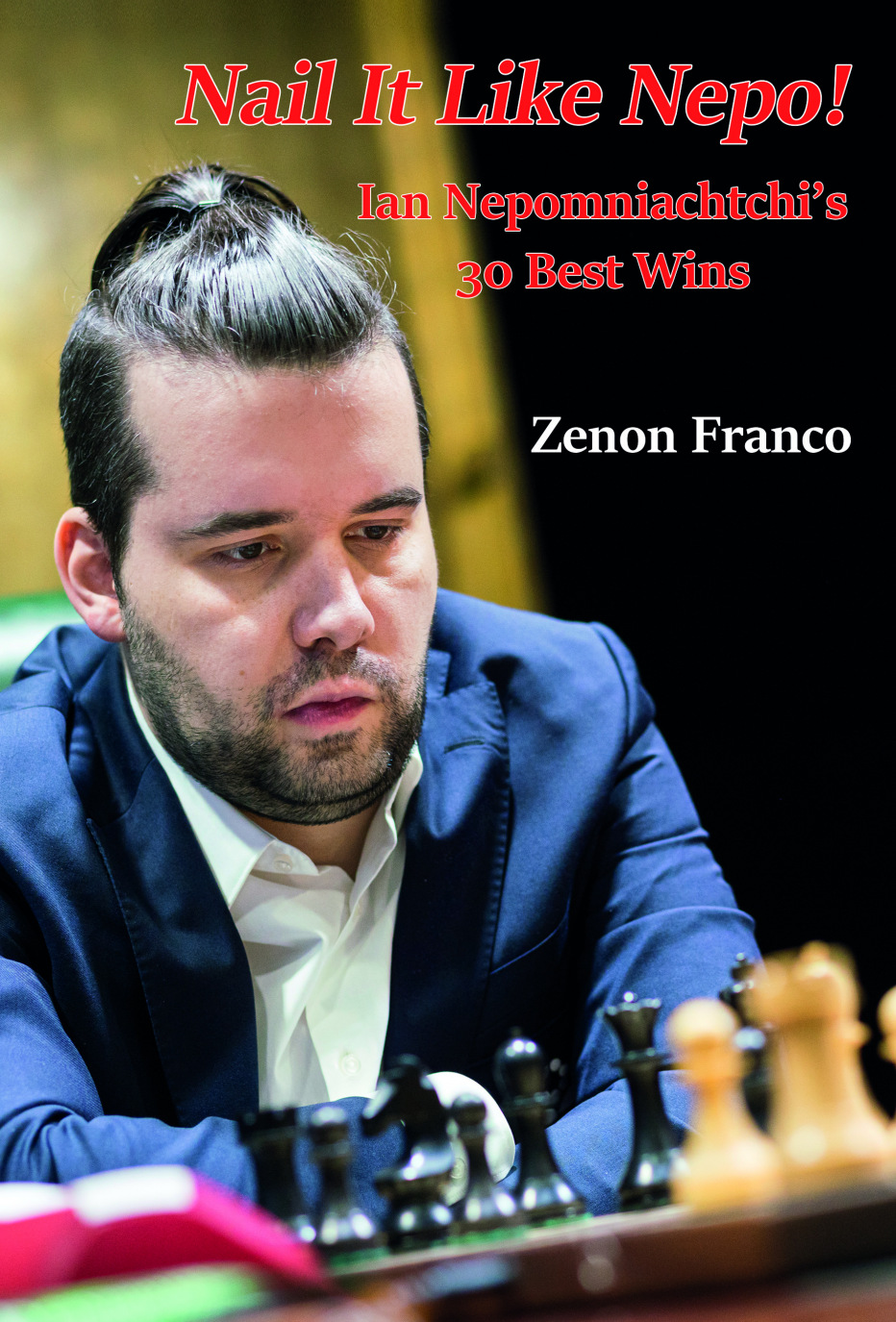
Ian Nepomniachtchi’s road from Grandmaster to becoming Magnus Carlsen’s world championship challenger in 2021 was a long one. GM in 2007 and Russian champion for the first time in 2010, Ian only hit the elite in recent years. His victory in Ekaterinburg occurred at his very first candidates tournament. In this book Grandmaster Zenon Franco analyzes Nepo’s chess through his 30 best wins and several fragments, considering his style, his strengths, as well as his weaknesses and how he has overcome them. Like Magnus, we see fighting, practical chess with a player not afraid to push his g and h pawns in front of his king, and a more aggressive than positional style. Above all, Franco compares Nepo to Lasker, Korchnoi and Magnus Carlsen himself. In instructional move by move format, we see Ian’s best wins against Carlsen, Anand, Kramnik, Giri, Aronian, Vachier-Lagrave, Svidler, Gelfand, Karjakin, and other elite players of the last decade.
Zenon’s highest ever place in the Elo list was 66th in January 1982. As a coach, Zenon was director of the Escuela Kasparov Marcote de Galicia from 1995 to 1999. His most successful pupils included Grandmaster Francisco Vallejo Pons and IM David Martinez Martin, Spanish editor of Chess24.com.
In 2016, Zenon was granted an award by the Paraguayan parliament “in recognition for his invaluable and meritorious contribution to Paraguayan sport”: for his chess career and for his help in the development of chess in Paraguay.
YouTube review by Grandmaster Danny Gormally
Genna Sosonko
Genna Sosonko (born 1943, Troitsk, Russia) is a Soviet-born Dutch Grandmaster who is widely recognized as the number one writer on the history of Soviet chess.
Playing career
Once ranked among the world’s top twenty chess players, Genna acted as second to ex-Word Champion Mikhail Tal and to ex-World Championship Challenger Viktor Korchnoi during world championship candidates matches. He emigrated from the Soviet Union to the Netherlands in 1972, where he continues to live.
He won the Dutch Championship in 1973 and 1978 (jointly). His tournament record includes 1st at the Barcelona Zonal Tournament 1975, 1st at Lugano 1976, 1st at Wijk aan Zee 1977, 1st at Nijmegen 1978, 3rd at Amsterdam 1980, 1st at Wijk aan Zee 1981, 3rd at Tilburg 1982 and 4th at Haninge 1988. He also drew a match with Jan Timman (+1 =0 −1) in 1984.
Genna played for the Dutch team at the Chess Olympiads eleven times, in 1974-84, and 1988-96. He won two individual medals: gold at Haifa 1976 and bronze at Nice 1974, and two team medals: silver at Haifa 1976 and bronze at Thessaloniki 1988.
FIDE, the World Chess Federation, awarded Sosonko the International Master (IM) title in 1974, the GM title in 1976 and the FIDE Senior Trainer title in 2004.
Literary career
Sosonko has authored seven non-technical chess books in English centering heavily on his chess life in the Soviet Union and his relationships with and memories of both leading Soviet players and lesser-known characters in chess history.
Evil-Doer: Half a Century with Viktor Korchnoi (2018) in paperback and Amazon Kindle
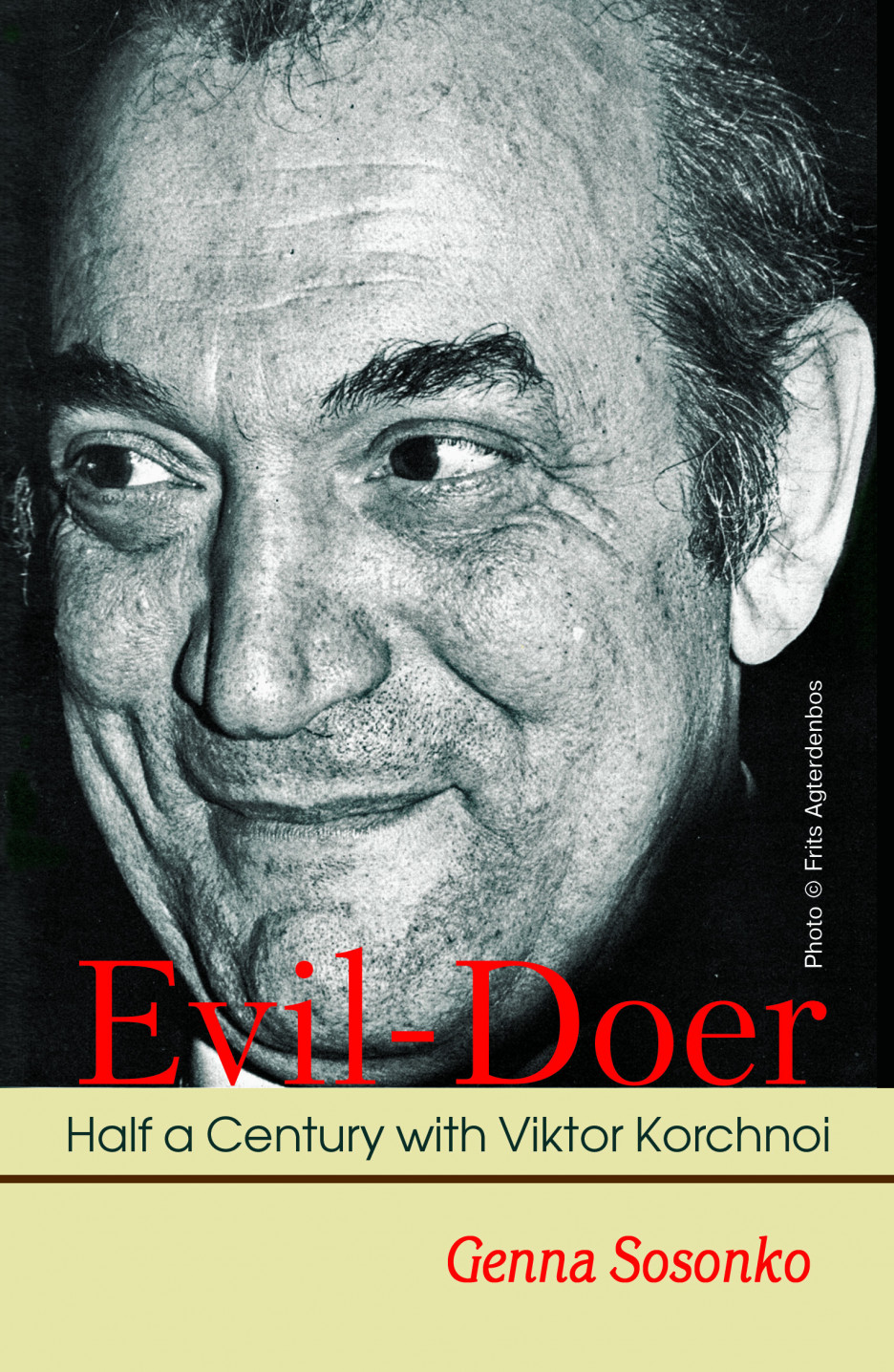
Viktor Korchnoi was one of the leading grandmasters of the 20th century, coming within one game of winning the world championship in 1978. His battles with Karpov for the world crown were among the most important chess matches ever played. A man with a unique – and in many ways tragic – life and career, Korchnoi’s defection to the West in 1976 was a major event in Cold War politics.
Grandmaster Genna Sosonko was Korchnoi’s coach and second during tournaments and candidates matches in 1970-71 and then a close friend of Korchnoi for decades. Indeed, Sosonko’s emigration to the West in 1972, which is described in detail in this memoir, had a key impact on Korchnoi’s decision to defect four years later. They would meet up at tournaments and at home and discuss chess, politics, and just about everything else. Their conversations constitute an important part of this book, in which Sosonko tackles difficult questions about Korchnoi’s personality and places much of his often challenging behavior into its historical context. This book, like Sosonko’s previous masterpiece The Rise and Fall of David Bronstein, contains no games but focuses on Korchnoi’s life, from his early childhood to his final years. Further, it includes many previously unpublished photos from the private collections of Sosonko and the Korchnoi family.
Smyslov on the Couch (2018) - in paperback and Amazon Kindle
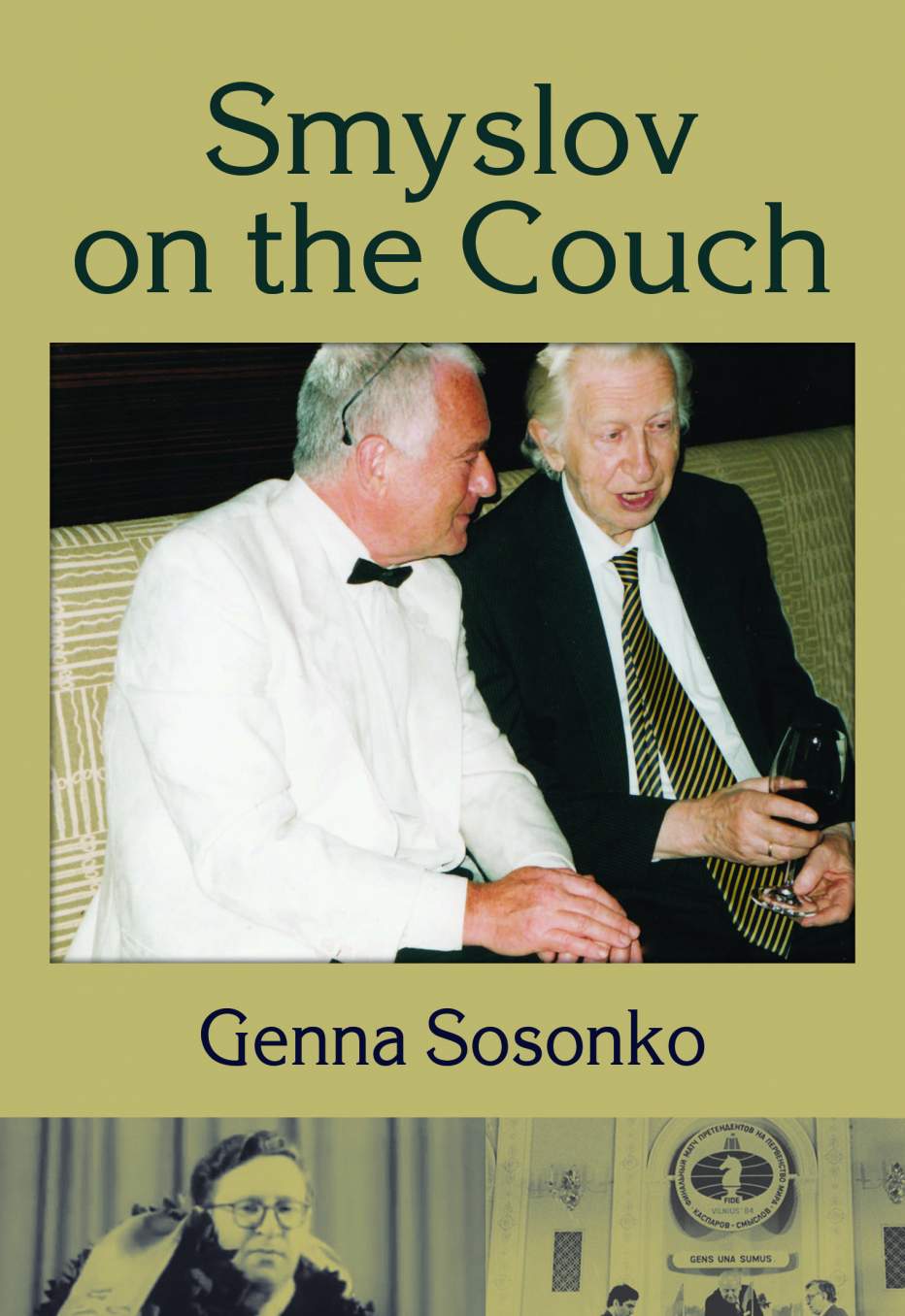
In his third full-length memoir about one of the world's greatest ever chess players Genna Sosonko portrays a warm picture of the seventh world champion Vasily Smyslov, with whom he spent considerable time over the board, during tournaments and while meeting at each other's homes. Smyslov the man was far more balanced and spiritual than most of his contemporaries, capable of a relaxed and yet principled approach to life. Unlike most top players he was able to reach a very high standard in his chosen hobby - in his case, classical singing - even while playing chess at the very top. His natural inclination to see the best in people was, however, challenged as the world around him underwent fundamental changes late in his life.
The new freedoms of the post-Soviet era also engendered one of the most extraordinary polemics in chess history - David Bronstein's article 'Thrown' Games in Zurich (2001) - bringing accusations against Smyslov that forced him to defend himself at the age of eighty, by which time many witnesses to the events in Zurich were already deceased. In this book, Genna focuses in particular on that polemic, places it in the wider context of the so-called Soviet Chess School, and asks whether Bronstein's hurt and accusations were justified.
The Rise and Fall of David Bronstein (2017) - in paperback and Amazon Kindle
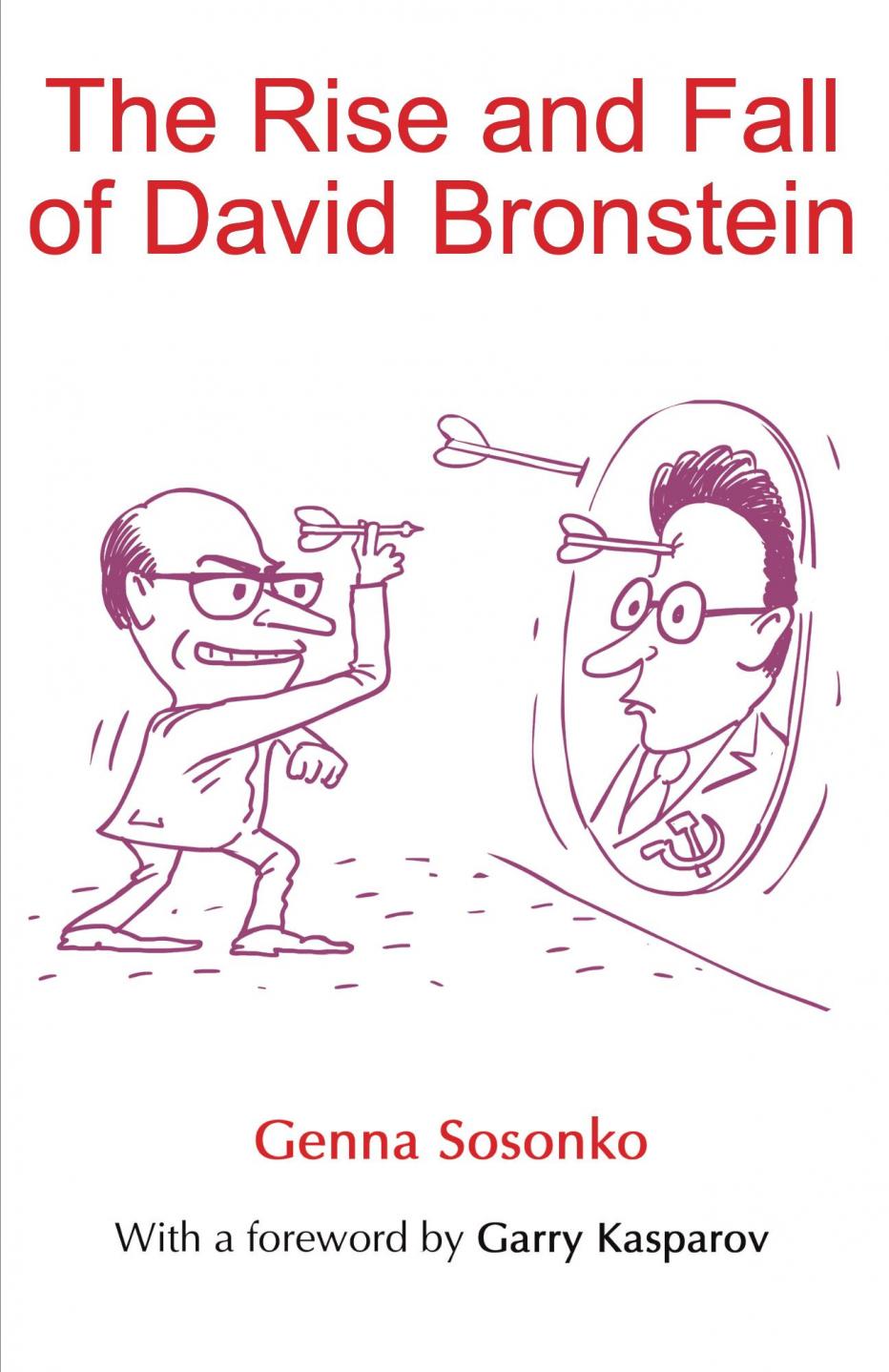
First published in Russian in 2014 and written by Genna Sosonko – widely recognized as the number one writer on the history of Soviet chess – this is a truly unique book about the life and destiny of the great chess player David Bronstein (1924-2006).
Emerging from a challenging background – he narrowly escaped the holocaust in WWII, during which he starved, and his father spent seven years in a gulag – Bronstein faced Botvinnik in the world championship match in 1951 and nearly defeated him. But this ‘nearly’ inflicted a wound on David so deep that it would not heal for the rest of his life.
Sosonko knew Bronstein well. Their conversations – many of which have made it into this book – not only portray the thoughts and character of one of history’s most original grandmasters but also take us back to a time unlike any other in world history. This is not a biography in the traditional sense of the word. Rather, Sosonko’s fascinating book asks eternal questions which don’t have neat and simple answers.
With a foreword to the English edition by Garry Kasparov.
YouTube review by Grandmaster Danny Gormally
Interview with Genna Sosonko about his Elk and Ruby books on The Perpetual Chess Podcast
YouTube review by Grandmaster Danny Gormally
Grigory Bogdanovich
Grigory Bogdanovich (born in 1949) began work as a chess coach in the early 1980s. He was awarded the USSR Master of Sport title in 1983 after successful results in the Moscow team championship, during which his famous opponents included David Bronstein, Artur Yusupov and Andrei Sokolov. Later, he was twice Soviet Correspondence Chess Champion as part of the victorious Moscow team. In 1990 he graduated for the second time, from the Higher School of Coaches, after previously gaining a degree in engineering and economics. He has recorded a string of victories in international chess tournaments, and gained the International Master title in 1991. Grigory spent over a quarter of a century playing for Bad Mergentheim chess club (Baden-Wurttemberg). He has written several opening books in English and Russian.
The Creative Power of Bogoljubov Volume I: Pawn Play, Sacrifices, Restriction and More (2020) - in paperback, hardback and Amazon Kindle
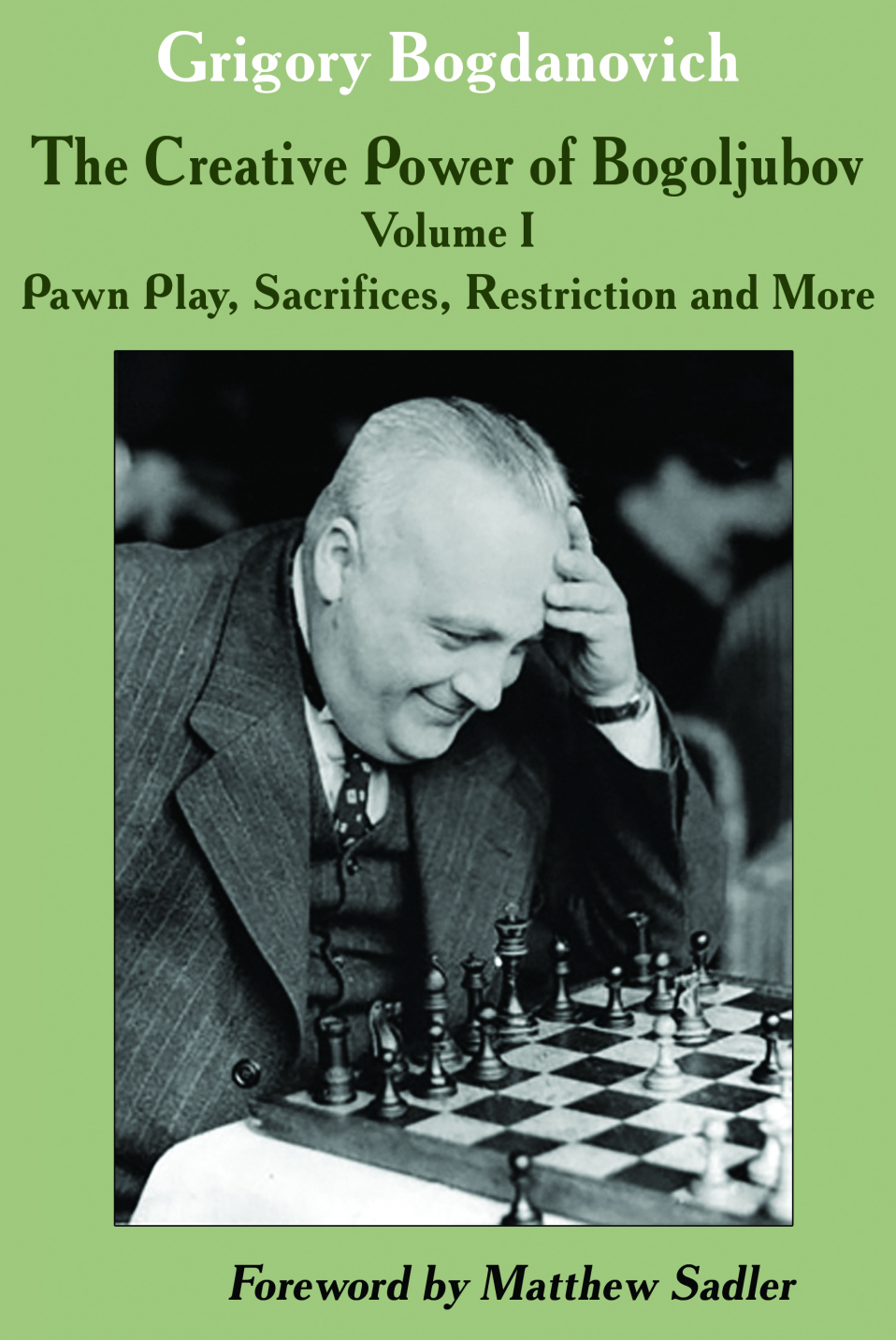
Efim Bogoljubov was one of the world’s very strongest players in the 1920s and 1930s. Twice he played Alexander Alekhine for the world championship title (1929 and 1934) and he won the famous Moscow 1925 tournament, ahead of Jose Capablanca, Emanuel Lasker and many other stars. He also won the Soviet championship in 1924 and 1925, as well as a host of other international tournaments. His play featured many sparkling combinations, as well as a deep positional understanding.
International Master Grigory Bogdanovich has written a two-volume treatise on Bogoljubov’s life and games, covering over four hundred fully annotated games and fragments over both volumes. His analysis of Bogoljubov’s games is split into instructive themes, making his treatise a fantastic textbook for learning a huge range of winning techniques. In the present Volume I, which contains 194 games and fragments, Bogdanovich covers the topics of objectivity, imagination, combinational play, piece and pawn sacrifices, play with rook’s pawns, pawn phalanxes, restriction play, conversion of an advantage, exchanges and central strategy. Drawing on contemporary sources with the addition of modern computer analysis, the author provides annotations by Bogoljubov himself, Alekhine, Lasker, Mikhail Botvinnik, Aron Nimzowitsch, Savielly Tartakower, Hans Kmoch and many other famous players and teachers.
The biographical section will also be of immense interest to chess historians. It contains a number of original documents written by and to Bogoljubov previously unpublished in the West, and in some cases not published at all. They were originally selected by the late Anatoly Matsukevich, who had planned to write his own biography of Bogoljubov and who had obtained these documents from Bogoljubov’s personal archive. Topics covered include plans for a match against Capablanca and an earlier match against Alekhine before the latter became world champion, neither of which materialized. The book also contains a number of photos of Bogoljubov, from both chess and family life. With a foreword by Matthew Sadler.
The Creative Power of Bogoljubov Volume II: Attack, Defense, Planning and More (2021) - in paperback, hardback and Amazon Kindle
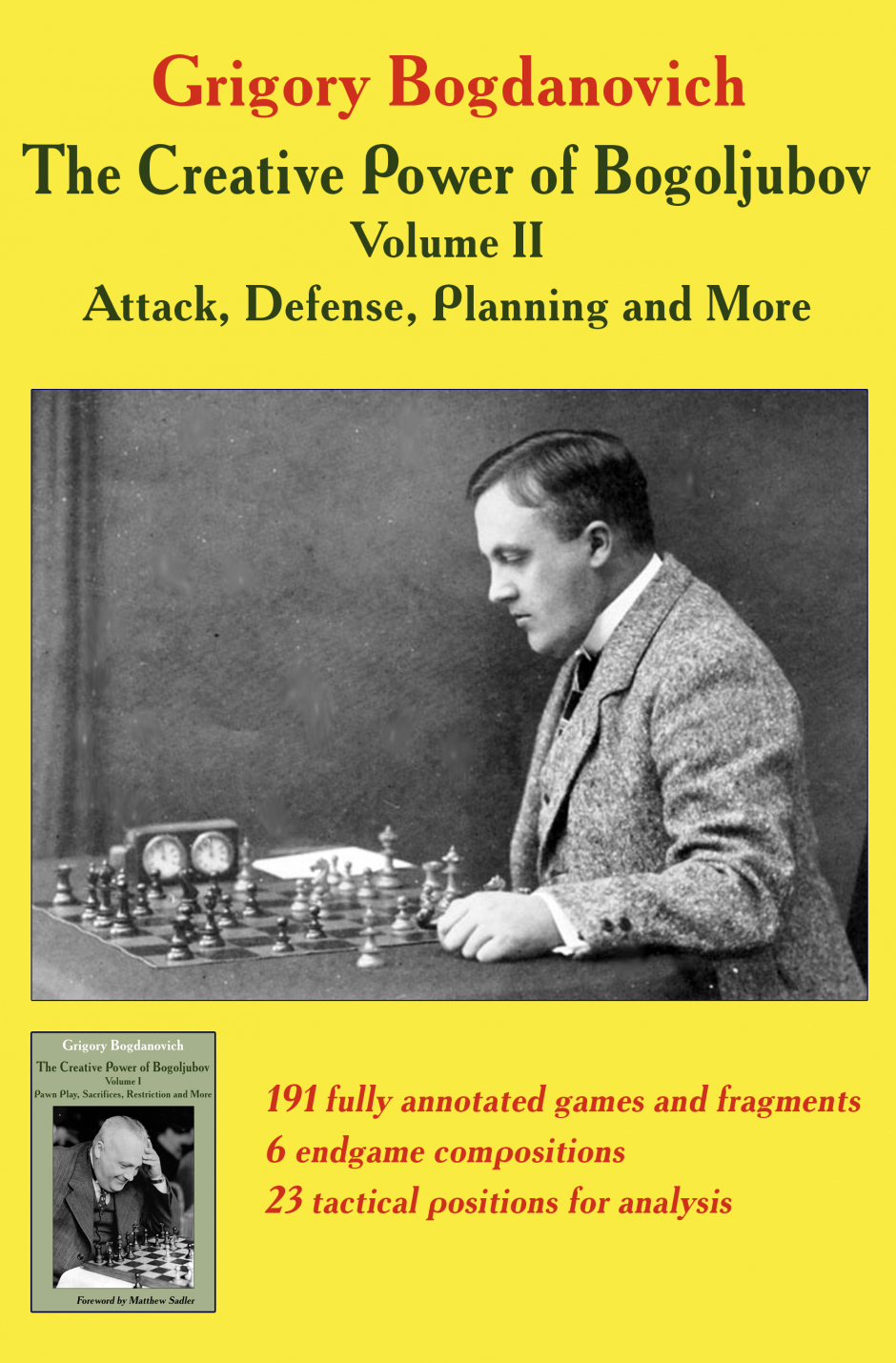
In the second part of his two-volume treatise on Bogoljubov’s games, International Master Grigory Bogdanovich provides 191 fully annotated games and fragments as well as 6 endgame compositions and 23 tactical positions for the reader to analyze. As in the first volume, his analysis of Bogoljubov’s games is split into instructive themes, making his treatise a fantastic textbook for learning a huge range of winning techniques. The present volume covers the topics of attack, defense, planning, Bogoljubov’s contribution to opening theory, and endgame technique.
In the openings chapter, there is a special section on how Bogoljubov handled Spanish Exchange, Carlsbad, Stonewall and Pillsbury knight structures. It also includes his contributions to theory in the King’s Gambit, Two Knights, Four Knights, Spanish, French, Queen’s Gambit Cambridge Springs, Slav and Semi-Slav, Zukertort System and Bogo-Indian.
The chapter on Bogoljubov’s endgame technique covers pawn structures, king activity, pawn endings, same-colored and opposite-colored bishop endings, knight endings, rook endings, queen endings, material imbalances and multi-piece endings among others.
This book also contains further photos from Bogoljubov’s career.
Tomasz Lissowski
Tomasz Lissowski, born in 1952 in Warsaw, is a chess historian, journalist, trainer and organizer. He is the author or co-author of several books, on Kieseritzky (1996, with GM Bartek Macieja), Zukertort (2002, with Dr. Cezary W. Domanski), Najdorf (2005, with GM Adrian Mikhalchishin), Przepiorka (2013, with Jerzy Konikowski and Jerzy Moras) and others.
The Wizard of Warsaw: A Chess Biography of Szymon Winawer (2023) - in paperback, hardback, Amazon Kindle and Forward Chess
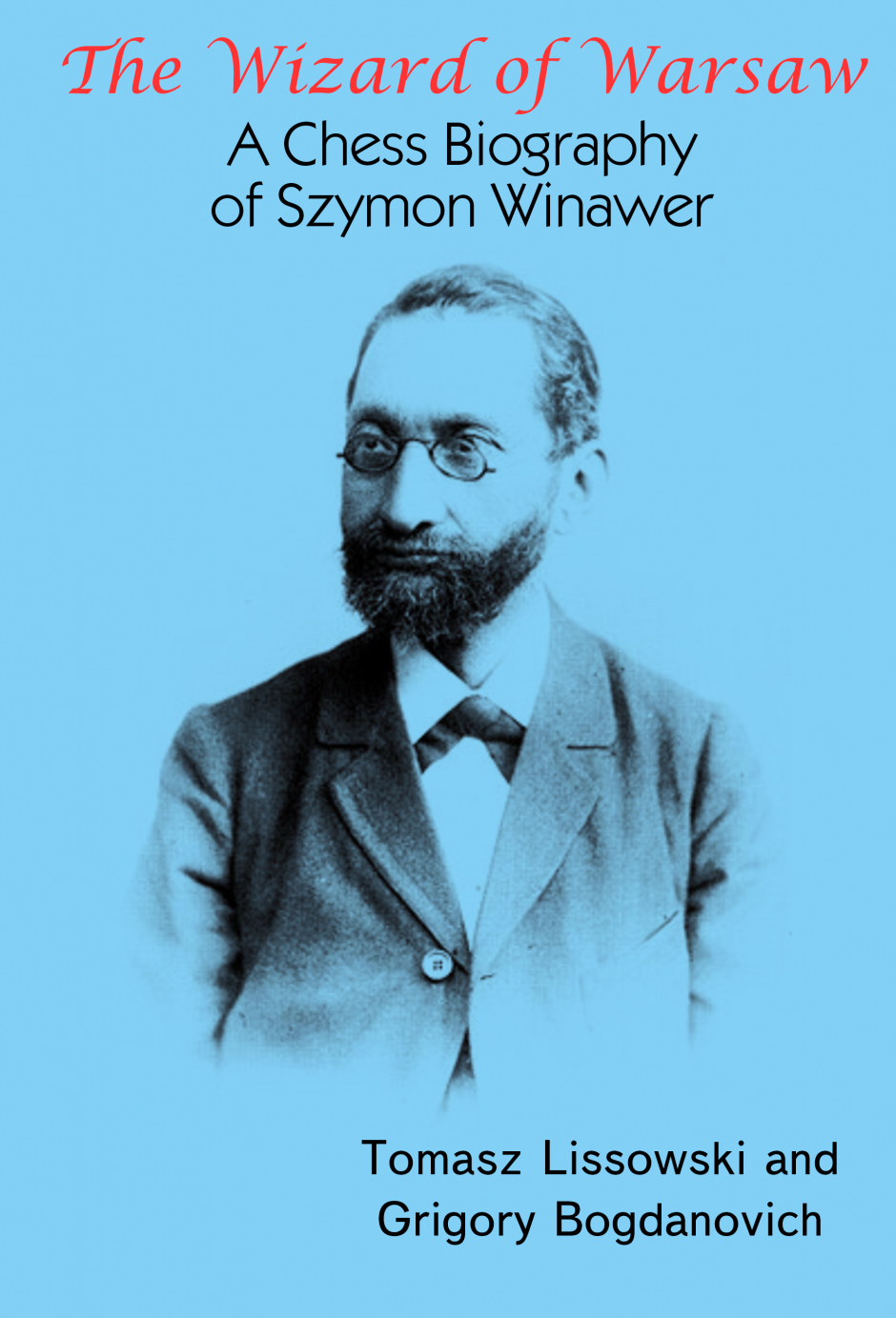
Szymon Winawer was a world top-10 player in the 1870s and 1880s, dueling with such titans as Steinitz, Lasker, Anderssen, Marshall, Chigorin, Zukertort, Louis Paulsen, Janowski, Maroczy, Tarrasch and others, and defeating most of the leading players of his time. He won or took prizes in major international tournaments, including Paris 1867 (second, behind Kolisch and above Steinitz), Leipzig 1877 (fourth, behind Paulsen, Anderssen and Zukertort), Paris 1878 (first equal with Zukertort, though he lost the play-off), Berlin 1881 (third equal with Chigorin, behind Blackburne and Zukertort), Vienna 1882 (first equal with Steinitz), and Nuremberg 1883 (first, ahead of Blackburne).
Winawer was a proponent of fighting chess, regularly deploying the King’s Gambit and Ruy Lopez as white, demonstrating winning combinations as well as positional sacrifices and endgame precision. He attacked the castled king with his h-pawn 150 years before Alpha-Zero. He displayed technique using Horowitz bishops and opening the g-file. At the same time, we see in the book that he also played solid positional chess. Moreover, several opening ideas are named after him, including the popular Winawer Variation of the French Defense.
The Warsaw-born player was not a chess professional and never published any annotated games of his own, but some of his concepts, both in the opening and in the middlegame, are still valid in the 21st century. Indeed, many strategic ideas (blockade, exploiting doubled pawns, maneuvering) described in the works of Nimzowitsch and other hypermodernists can be found, in embryonic form, in the games of Winawer played half a century earlier.
In the first half of this biographical work, Warsaw-based chess historian Tomasz Lissowski, who has co-written books on Kieseritzky and Zukertort among others, portrays Winawer’s life and his sporting achievements in the context of the epoch. This book delivers not only a description of the evolution of chess in Poland in the nineteenth century, but a sense through the prism of chess of the political and social history of Poland and the Austro-Hungarian, German and Russian empires in a period of war and upheaval. It is illustrated by many historical photos from the period.
In the second half of this book, International Master Grigory Bogdanovich paints Winawer’s creative portrait, as well as examining the legacy that this ingenious improviser left to chess culture. The book contains in total 132 annotated instructive games and fragments of Winawer and his contemporaries.
From Vienna to Munich to Stockholm: A Chess Biography of Rudolf Spielmann (2023) - in paperback, hardback, Amazon Kindle and Forward Chess
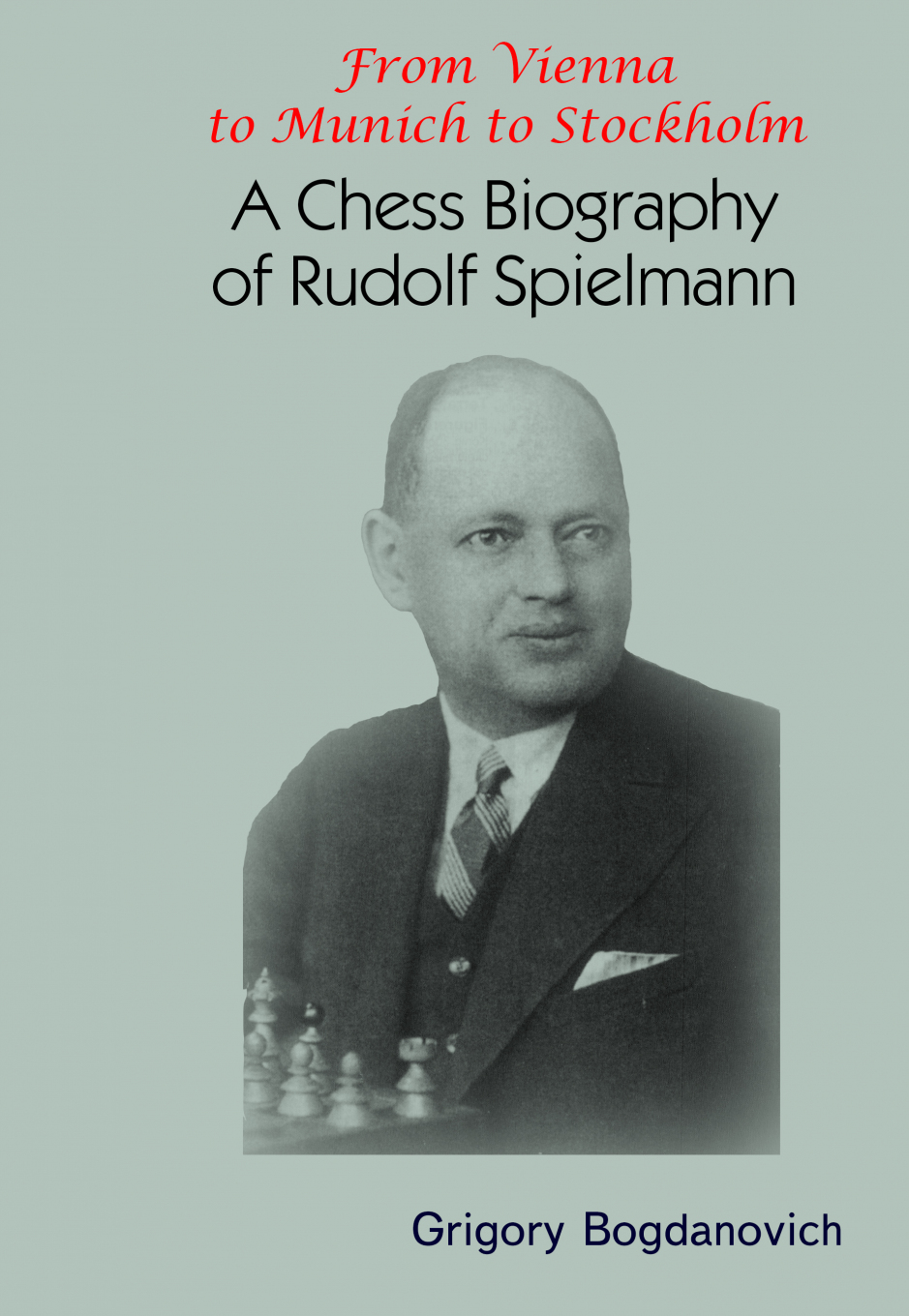
Rudolf Spielmann was one of the strongest chess players in the world in the first half of the 20th century. Following his shared second place at the Carlsbad tournament in 1929 with Capablanca, half a point behind Nimzowitsch, he was considered one of the world’s top five. His career spread over four decades and included a host of tournament and match victories, such as defeating Bogoljubov over ten games in 1932.
Often known as the Last Romantic in chess with his predilection for the King’s Gambit and Vienna Game and love of sacrifices, he bequeathed a rich legacy of ideas and techniques. These combinational and positional master classes are examined here in 213 instructional games and fragments, organized thematically in a way similar to Grigory Bogdanovich’s previous volumes on Bogoljubov.
Detailed commentary is provided on games against leading contemporaries. Opponents in this work include five world champions Lasker, Capablanca, Alekhine, Euwe, and Botvinnik, as well as Marshall, Janowski, Tarrasch, Tartakower, Nimzowitsch, Reti, Rubinstein, Romanovsky, Bogoljubov, and many others. Bogdanovich’s commentary is richly supplemented by that of stars of the epoch and, above all, of Spielmann himself.
The book further contains a biographical sketch and is supplemented by a large number of tournament photographs and portraits. Spielmann’s life was ultimately tragic – a lonely death in Sweden aged just 59 as a Jewish refugee from Nazi Germany following the demise three years earlier of his sponsor, while several family members failed to escape the Holocaust.
Additional materials in the book include a detailed table of tournaments and matches from his career, as well as a translation of Spielmann’s fascinating article dating to 1923 called “From the Sickbed of the King’s Gambit”.
Alexander Koblenz
Alexander Koblenz (1916-1993) was chess champion of Latvia four times in the 1940s, competed in the final of the Soviet championships in 1945, won a number of Latvian and international tournaments, and qualified for the USSR Master of Sports title, also in 1945. According to Chessmetrics he was the world number 43 in July 1945. He coached Mikhail Tal permanently over 16 years and seconded him in his two world title matches against Mikhail Botvinnik (1960 and 1961). Koblenz wrote 20 books on chess in his lifetime. He was also a leading chess organizer and journalist in Latvia.
Mikhail Tal: The Street-Fighting Years (2021) - in paperback, Amazon Kindle and Forward Chess
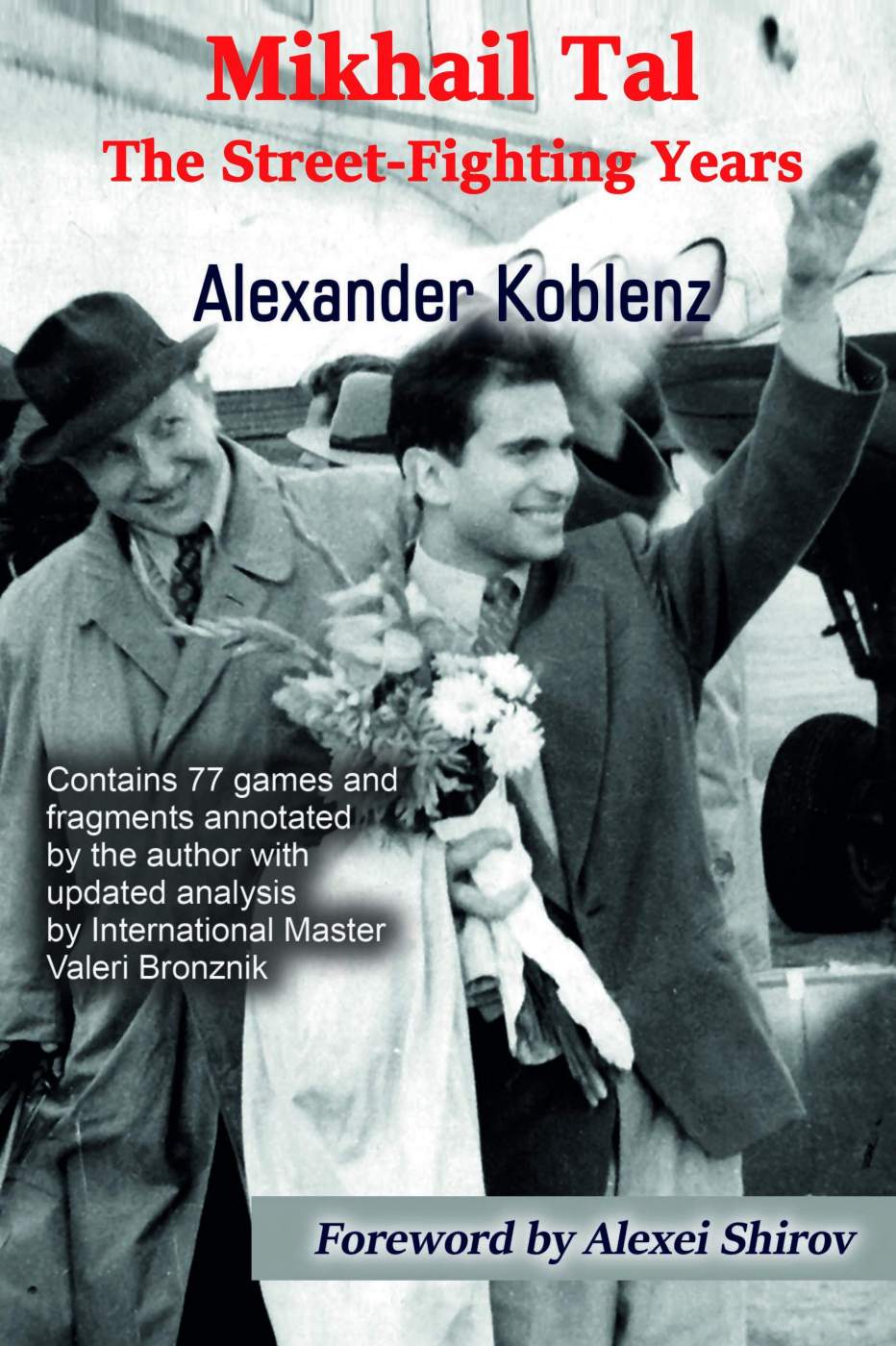
In Mikhail Tal: The Street-Fighting Years, Tal’s long-term coach and second Alexander Koblenz takes the reader through the first 12 years of Tal’s chess career, from promising junior to world champion in 1960 and encompassing his return world championship match against Mikhail Botvinnik in 1961.
This classic book, first published in the Soviet Union in 1963, contains 77 games and fragments annotated by the author who provides ring-side commentary and unique inside knowledge, as well as background information to the games and anecdotes.
Five of the games are taken from Tal’s 1960 world title match and seven from his 1961 world title match. Aside from Botvinnik, opponents include Bobby Fischer, Vasily Smyslov, Tigran Petrosian, Boris Spassky, David Bronstein, Viktor Korchnoi, Paul Keres, Efim Geller, Yuri Averbakh and many other stars of chess during the 1950s and early 1960s.
The analysis has been updated using the latest computer technology by International Master Valeri Bronznik. Bronznik delivers a masterclass in modern analysis of classical games while allowing Koblenz full scope to demonstrate how Tal destroyed his opponents with the best attacking chess known at the time. Indeed, Bronznik makes many new and exciting discoveries in Tal’s games and this work serves as an instruction manual for playing practical, street-fighting chess.
As Alexei Shirov writes in his foreword, “I am very happy that this old but highly instructive book is finally out in English. The old Russian edition has always been a special treasure for me and I truly enjoyed reading it through again.”
YouTube review by Grandmaster Danny Gormally
Jakov Geller
Jakov Geller, born in Moscow in 1986, achieved the grandmaster title in 2011. His coaches included grandmasters Jakob Meister and Marat Makarov. Jakov worked as a coach in Togliatti from 2007 to 2015, and his pupils have included grandmasters Ivan Bukavshin and Alexandr Predke, international masters Darsen Sanzhaev, Alexey Mokshanov and Rudik Makarian, and WGM Dinara Dordzhieva. The Russian team that Jakov coached in 2009 took first place in the U16 Olympiad. He was named Children’s Trainer of the Year in 2010 by the Russian Chess Federation. Jakov has won prizes in over 20 Russian and international tournaments and he has written frequently for Russian and international chess publications, including American Chess Magazine, Chess Informant and 64. Jakov has lived in Moscow since 2016.
Grandmaster Ivan Bukavshin: A Chess Prodigy’s Career in 64 Games (2020) - in paperback, Amazon Kindle and Forward Chess
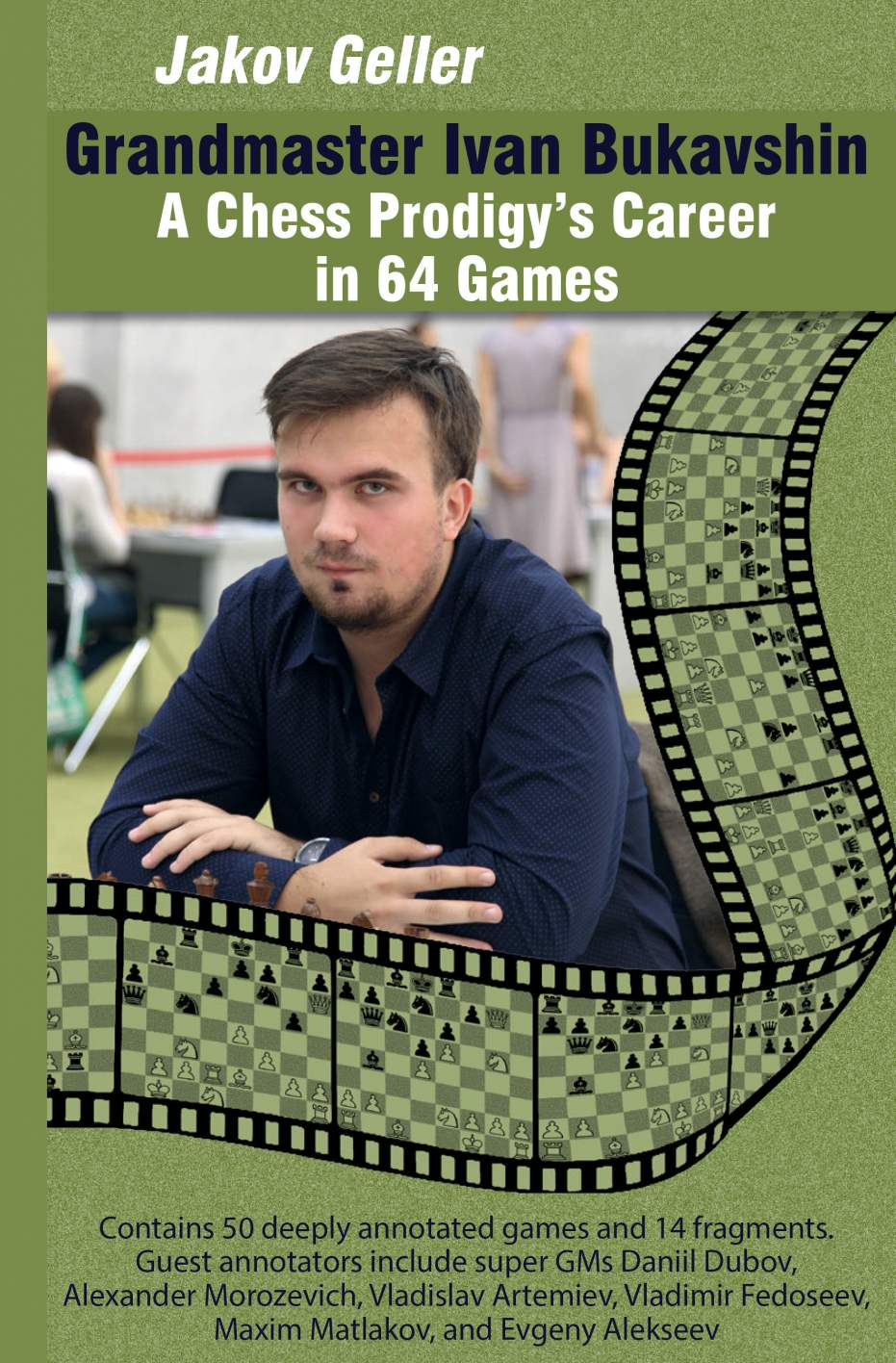
Ivan Bukavshin, born in Rostov-on-Don in 1995, was a Russian chess prodigy. He was European U12, U14 and U16 champion and placed third in the world U16 championships among many other successes, gaining the Grandmaster title at just 16 years of age. Ivan finished third in the Aeroflot Open in 2015, behind Daniil Dubov and Ian Nepomniachtchi, where he put in a performance rating of 2803. Ivan achieved a series of 2700+ performances over 2013-2015. He tragically died in early 2016 at the age of 20.
This book, by his
friend and coach Grandmaster Jakov Geller, takes a detailed look at Ivan’s life
and career in 50 deeply annotated games and 14 fragments. Apart from Jakov, 20
other guest grandmasters annotate games in this book, including super GMs
Dubov, Alexander Morozevich, Vladislav Artemiev, Vladimir Fedoseev, Maxim
Matlakov, and Evgeny Alekseev. The list of Ivan’s opponents in these games
includes Peter Svidler, Alexander Morozevich, Vladimir Fedoseev, Ernesto
Inkariev, Richard Rapport, and Dmitry Andreikin.
This book will be of interest to active chess players seeking to improve their game, where they can learn from interesting opening novelties, spectacular attacking combinations and subtle endgame victories.
1500 Forced Mates (2021) - in paperback, Amazon Kindle and Forward Chess
Jakov's new book focuses on a key element of tactics: forced mate. It contains 1500 positions rife with tactical resources; 1380 of them are presented as puzzles. The book is divided into 31 chapters, most of which are dedicated to a single tactical method, which is described in detail. This fundamental work systematizes the methods for delivering forced mate, which include sacrifices, pawn promotion, vacation, attraction, elimination, deflection, blocking, seizing the square, x-rays, pins, discovered checks, double checks, windmill and interference. The rest of the chapters are titled Combinations; they are used to consolidate the provided knowledge and test the acquired skills. They contain the theoretical basics of the combinations and cases studied, but to solve these puzzles the reader will also need to use techniques they studied in previous parts of the book, rather than in only the current chapter. Therefore, each new tactical method studied gradually increases the diversity of combinations used in the subsequent chapters. The puzzles in every chapter also gradually increase in difficulty. The last chapter makes the book useful even for top-level players, because it consists solely of difficult puzzles and can be used as a universal test to check forced mating skills.
The greatest value of this book is in the learning system that can be used as a foundation for young chess players to study tactics. The author has used this system countless times when working with his pupils and it has proved to be highly successful. Together with the carefully crafted examples it turns this work into a universal textbook that can be used by both students and coaches.
This book is accessible to beginners once they have learned to mate in one, and contains puzzles with mostly 2-move to 6-move solutions. Puzzles in the final chapter will challenge even grandmasters, with solutions often requiring 9-11 moves.
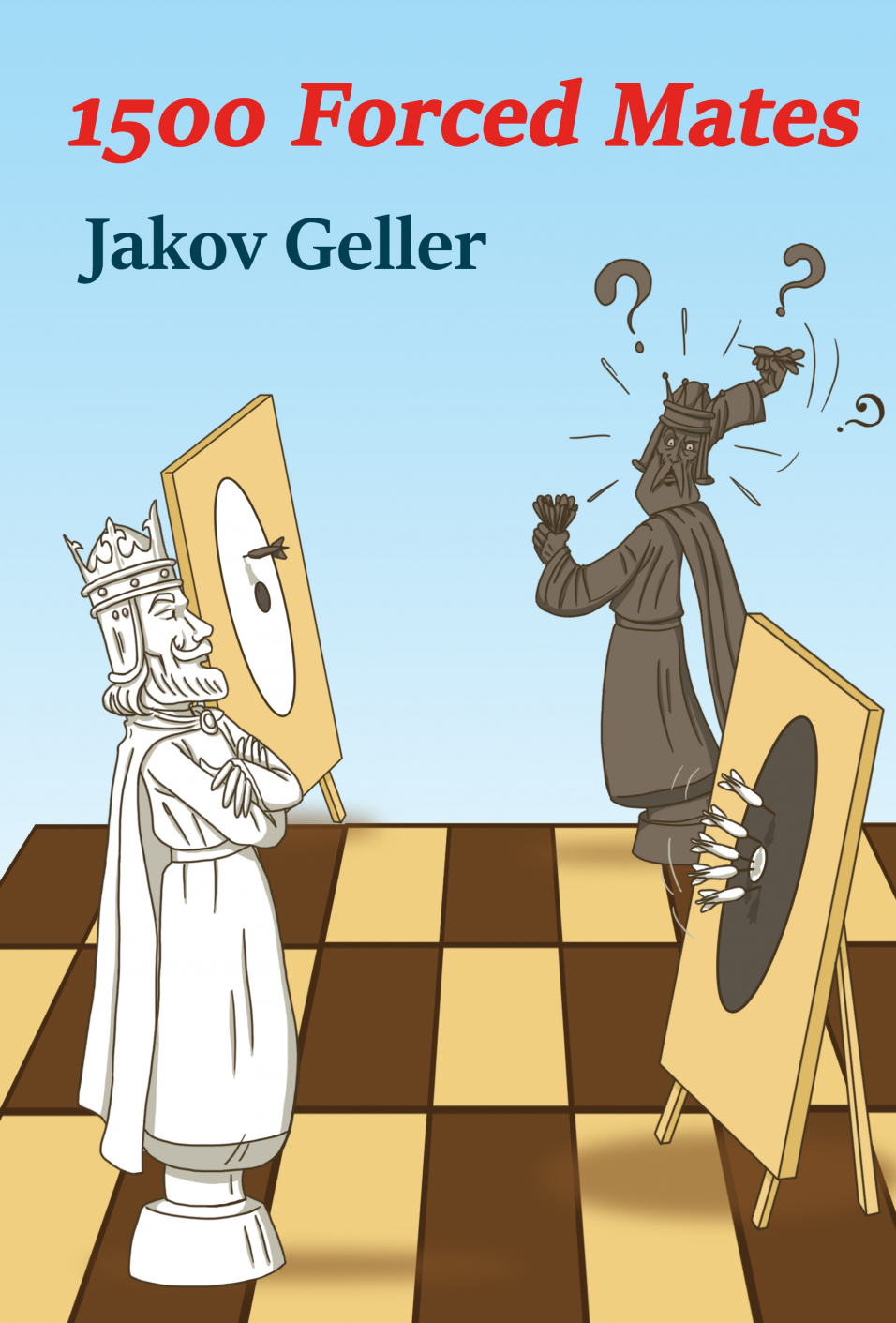
Mate Threats and Defense - 1000 Tactical Examples (2022) - in paperback, Amazon Kindle and Forward Chess
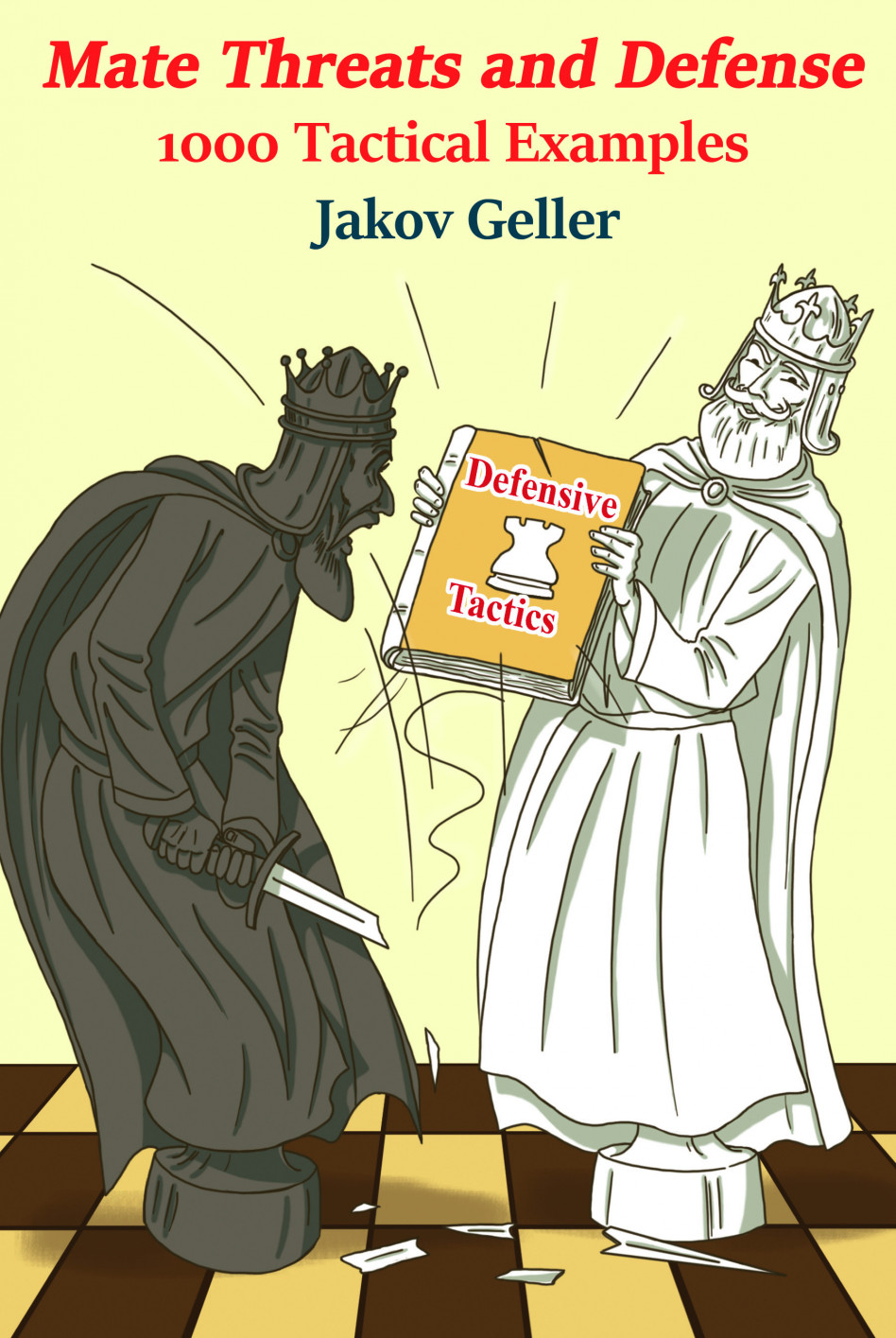
This tactics book by FIDE Senior Trainer Grandmaster Jakov Geller teaches the reader how to create mate threats and execute them using a mixture of combination techniques, as well as how to deploy all key defensive techniques to combat mate threats. Unlike most tactics books, the text provides readers with a detailed explanation of all elements of a mating combination, both individually and when combined with others. This knowledge enables the reader to identify tactical opportunities in their game and execute them or defend against them with confidence.
This book contains 1,000 carefully selected examples, of which 924 are exercises for the reader to solve. They begin with simple one-move illustrations of the concepts and then go on to more complex tests, with many featuring combinations of 5-6 moves and sometimes more. The book is split into 28 chapters, the majority of which focus on defending against mate threats. Nine defensive techniques are given their own chapters. With every new defensive technique studied, the combinations in subsequent chapters become increasingly diverse. The difficulty level of exercises in each chapter hence gradually increases.
This work is a direct sequel to the book 1500 Forced Mates published by the author with Elk and Ruby in 2021 and is intended for a wide audience of chess improvers.
David Gertler
David Gertler (USA), has held the FIDE Master title since 1985. A former Chess Life magazine staff member, he has written many published articles and game analyses. Highlights of his half century of tournament competition range from being co-champion of the 1982 US Junior Open to twice finishing joint-second in the US Senior Open. David has played the Mackenzie Variation more than 1,000 times (with great success) in classical, rapid, and blitz games.
Play the Mackenzie! – A Sharp White Attack in the Ruy Lopez (2024) - in paperback, Amazon Kindle and Forward Chess

This theoretically solid opening repertoire for White, based on playing 5.d4 in the main line of the Ruy Lopez (1.e4 e5 2.Nf3 Nc6 3.Bb5 a6 4.Ba4 Nf6), gives you a great way to bamboozle your opponent, who is probably unprepared for this variation and its many pitfalls. Black can easily go wrong within the next few moves and quickly lose material or succumb to a crushing attack. White is poised to castle and engage in battle; Black’s king is vulnerable in the center and may find no relief on the kingside as White develops pieces to powerful outposts and forces pawn moves that allow attackers to pour in.
This variation is named after Scottish-American master George Mackenzie, who popularized it in the nineteenth century. He was undefeated with it, overwhelming some top masters of that day.
Elite competitors from many eras have played the Mackenzie Variation, including Morphy, Lasker, Alekhine, Tal, Short, and Cramling. In recent years, grandmasters such as Jones, Kosteniuk, and Yoo have used it to great effect, especially in rapid and blitz games, when opponents have little time to find a sound defense.
A final chapter shows you how to meet the popular Berlin Defense (3…Nf6) with a Mackenzie-style thrust, 4.d4. Again, many difficult decisions and tricky positions await the unwary Black player.
As well as variations and advice, this book contains 57 model games with key annotations, from Morphy in 1858 through to a dozen examples from the 2020s.
“In this lucid and well-researched book, David Gertler shows you how to make the Mackenzie Variation a formidable weapon.” – Stuart Rachels, former US champion and author of The Best I Saw in Chess.
Sergei Tkachenko
Sergei Tkachenko (born in 1963, near Odessa, Ukraine) is a member of the Ukrainian team that won the 5th World Chess Composition Tournament in 1997 and which came second in 2000, 2004, 2013, and 2017. He has won the studies section of the Ukrainian Chess Composition Championship six times and has won prizes, many of them for first place, in over 100 international chess composition tournaments.
Sergei coaches the Ukrainian chess composition team. He is also the press secretary of the Chess Composition Committee of the Ukrainian Chess Federation.
Sergei is an award-winning author who has written 18 chess books published by Elk and Ruby, including compositions and on historical themes. He is deputy chief editor of a Ukrainian chess composition magazine called Problemist of Ukraine and has a regular studies column on the ChessPro website. Sergei is a member of the Ukrainian Union of Journalists. He is a historian and archivist, a mechanical engineering graduate, and additionally spent five years studying theater production.
Yakov Vilner, First Ukrainian Chess Champion and First USSR Chess Composition Champion: A World Champion's Favorite Composers (2019) - in paperback and Amazon Kindle
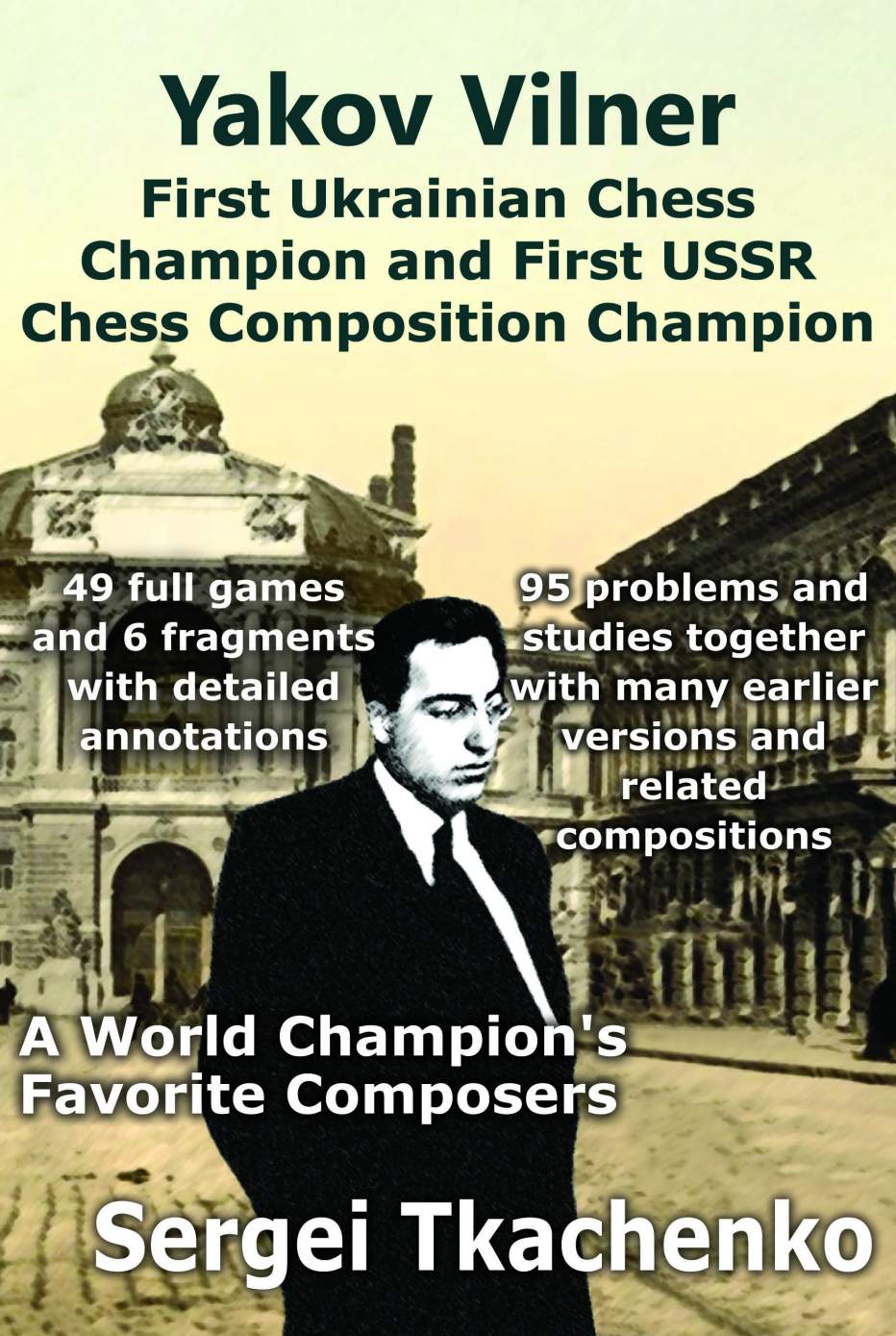
Yakov Vilner (1899-1931) was one of the leading Soviet chess masters in the 1920s. He won the Ukrainian championship three times (1924, 1925 and 1928), the Odessa championship five times (1918, 1923, 1925, 1926 and 1928) and competed in five USSR championships, his highest position being sixth equal in 1924. His attacking, combinational style delivered many memorable games and he regularly played against strong contemporaries such as Bogoljubov, Romanovsky, Bogatyrchuk, Verlinsky and an upcoming teenager called Botvinnik.
Vilner was also a leading chess composer. He won the USSR composition championship for three-move problems in 1929 and in total he won prizes at 30 chess composition competitions.
In this historical work illustrated with rare archival photos from the period, Sergei Tkachenko tells the story of a man who, despite suffering constantly from the respiratory illness that would eventually end his life at the age of just 31, was a leading chess organizer and journalist in Ukraine as well as a player and composer, against a background of major social and political upheaval that significantly impacted the chess world. It was Vilner who, in 1919 as a member of the Revolutionary Tribunal in Odessa, managed to save Alexander Alekhine from the firing squad, which Tkachenko wrote about in his book Alekhine's Odessa Secrets: Chess, War and Revolution. The latter work was short-listed for the 2018 English Chess Federation Book of the Year.
Tkachenko has selected 49 full games and another six fragments, annotated in detail by Vilner himself, Tkachenko, Romanovsky, Bogatyrchuk, and other leading players of the 1920s. The author has also included all 95 of Vilner’s known problems and studies, some of which are fairy problems, as well as many earlier versions and related compositions. Like in Tkachenko’s other collections, all 95 compositions are set on the right-hand side of the page with the solution overleaf.
This book will be of great interest to fans of Soviet chess history, exciting games collections and problem solving.
Bishop and Knight Save the Day: A World Champion's Favorite Studies (2019) - in paperback, Amazon Kindle and Forward Chess
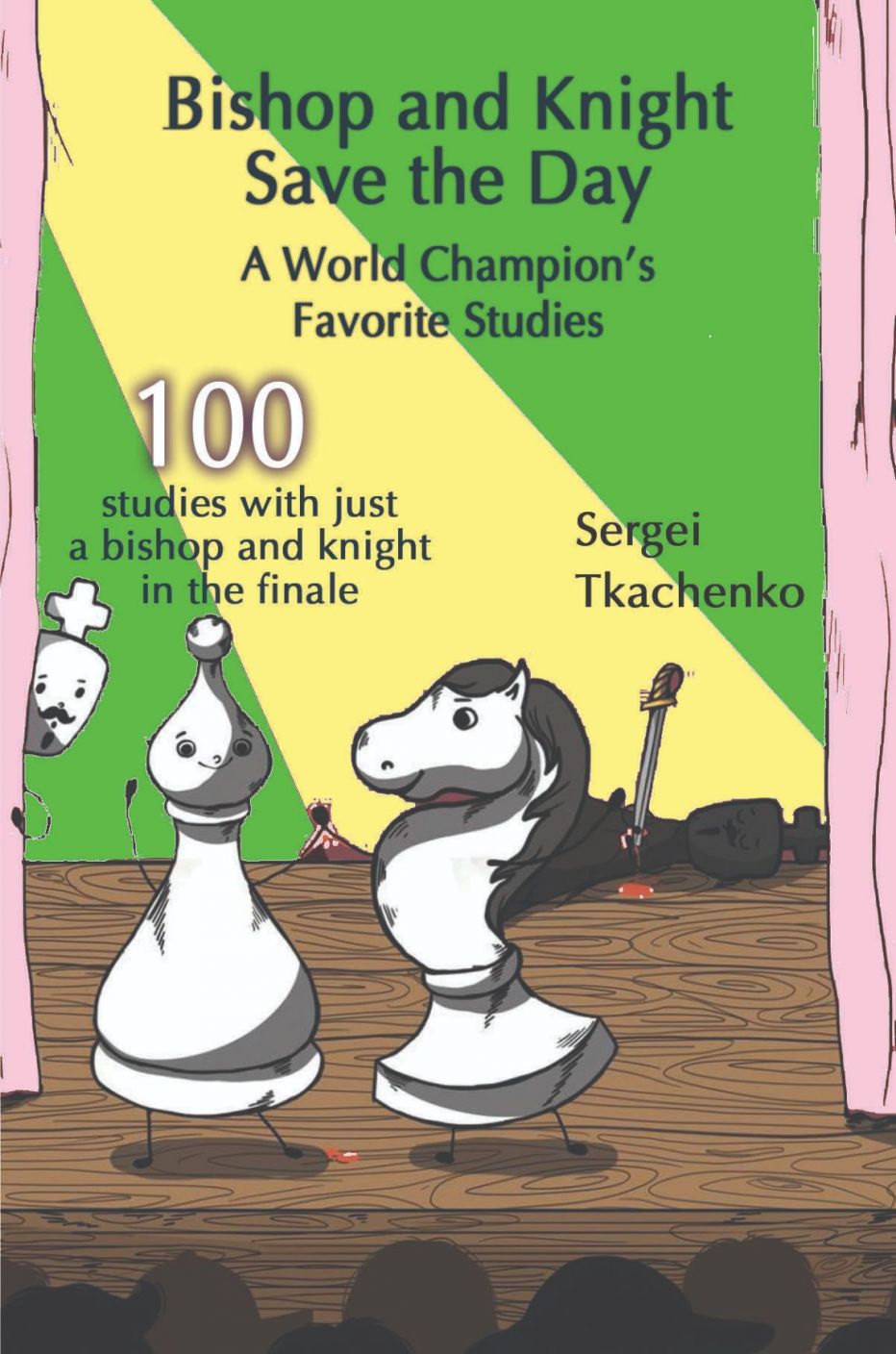
Sergei Tkachenko, a member of the Ukrainian team that won the 5th World Chess Composition Tournament in 1997 and which came second in 2000, 2004, 2013, and 2017, has collected 100 studies whose common theme is that white ends up with just a bishop and knight in the finale, yet manages to win or draw. There are no more than six moves in almost all solutions, so experienced chess players can analyze the positions directly from the diagrams. Newbies to chess problems will also find analyzing these studies useful. The diverse set of tactical ideas involving a bishop and knight in the finale will enable them to gain a deeper understanding of how the bishop and knight pair combine.
Some of these studies are classics from bygone ages. Others were originally published in the Soviet Union or ex-Soviet countries.
This is the seventh book in the World Champion’s Favorite Studies series by Sergei Tkachenko to be published by Elk and Ruby Publishing House.
Oleg Pervakov's Industrial Strength Endgame Studies: A World Champion's Favorite Composers (2018) - in paperback, Amazon Kindle and Forward Chess
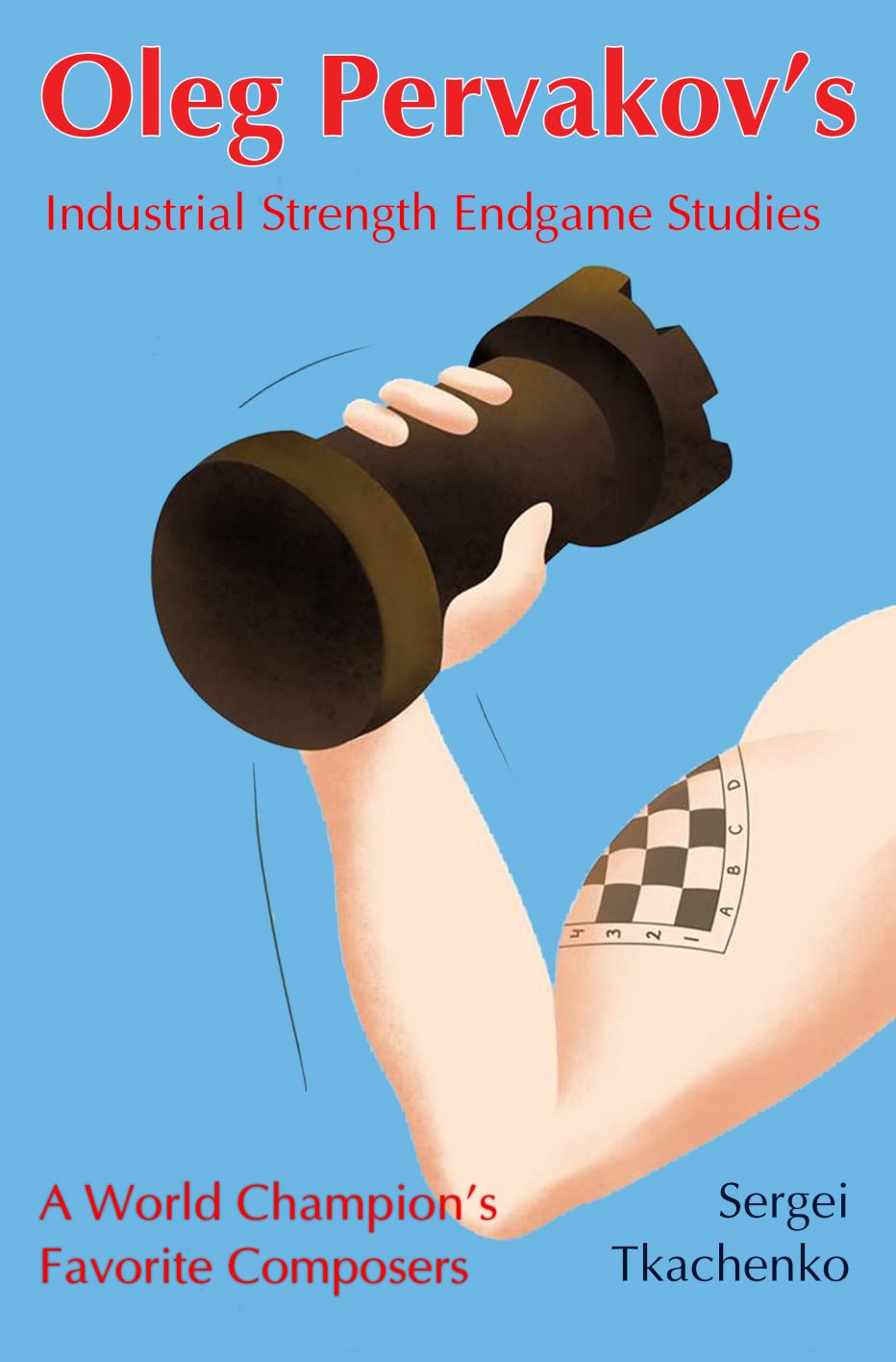
Oleg Pervakov (born in 1960 in the city of Kirov) is widely recognized as Russia’s greatest living chess composer. He has composed nearly 500 studies and he has won the individual chess composition world championship three times: in 2004-2006, 2007-2009 and 2013-2015.
In this book, Sergei Tkachenko, a member of the Ukrainian team that won the 5th World Chess Composition Tournament in 1997 and which came second in 2000, 2004, 2013, and 2017, has selected 100 of Oleg Pervakov’s best studies. The selection is quite varied – from elegant short studies with six moves to romantic grotesques with many pieces on board and over 30 moves to the solution. Yet what all of these studies have in common is spectacular play by both sides. And watch out: they are tough! That said, Oleg’s compositions are never boring. You may buy this collection of studies to test your endgame tactical abilities, to improve your endgame understanding, or simply to appreciate chess in all its beauty.
Unlike previous studies books compiled by Sergei Tkachenko this book is not pocket-sized due to its longer solutions.
Alekhine's Odessa Secrets: Chess, War and Revolution (2018) - in paperback, Amazon Kindle and Forward Chess
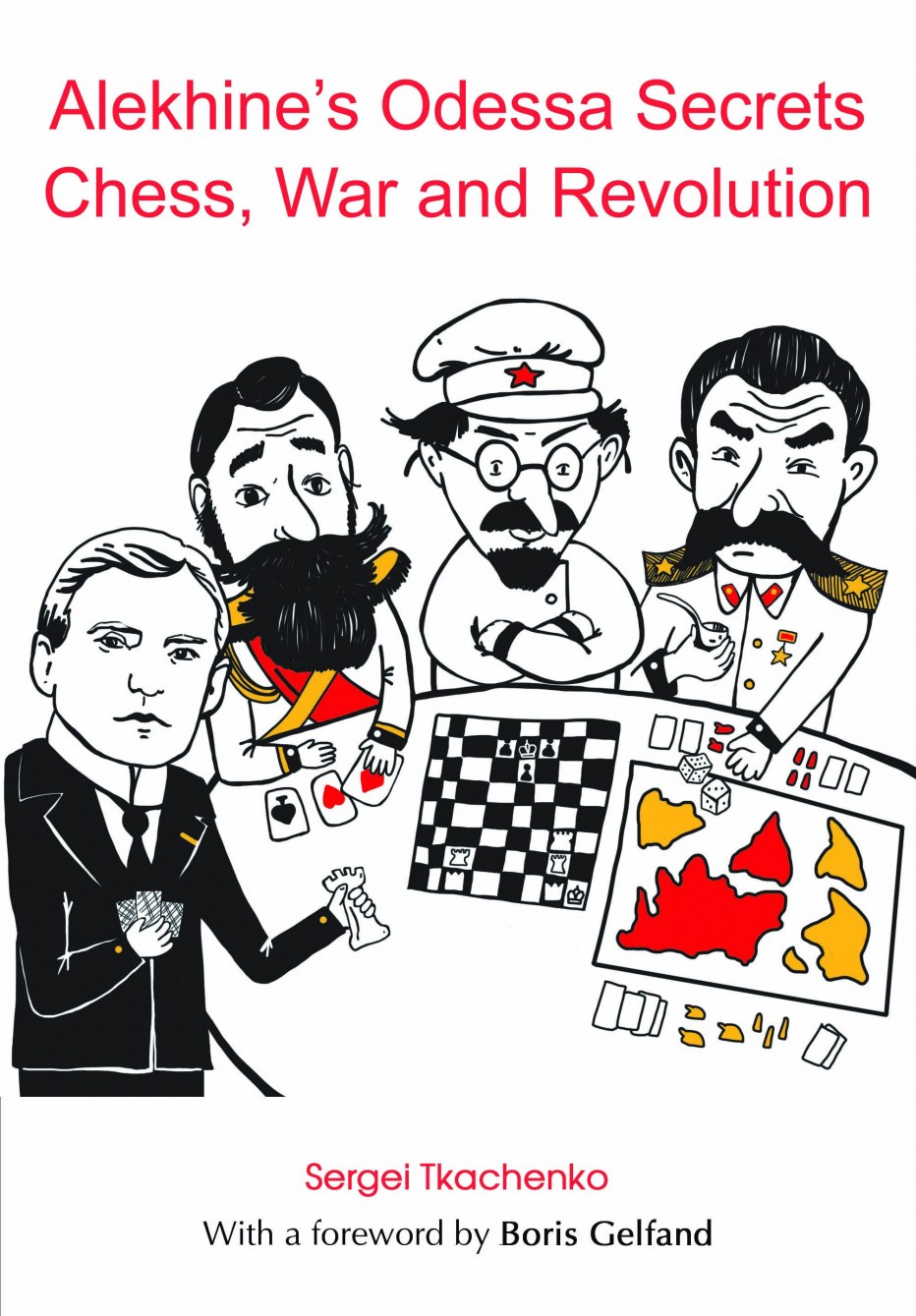
*** SHORT-LISTED FOR THE ENGLISH CHESS FEDERATION BOOK OF THE YEAR AWARD 2018 ***
Sergei Tkachenko has written a fascinating account of Alexander Alekhine’s time spent in Odessa during World War I, the Russian Revolution and Civil War, as well as of the impact of Odessa on his later life. Sergei, an Odessa native and ex-world chess composition champion, has carried out original research drawing from Odessa, Voronezh, Cheka and KGB archives among others, as well as local newspapers from the time. His research, together with a review of Russian-language secondary materials, has dug up lots of new information and analysis on Alekhine, including on his trips to Odessa and their reasons, his service during World War I, his interrogations by the Cheka and his ties to the White Movement. Sergei portrays Alekhine’s Odessa relatives and the Odessite chess masters against whom he played a number of friendly and simultaneous games during his three trips to the Ukrainian city.
Sergei provides a detailed description of chess in Odessa from the beginning of the nineteenth century and through the upheavals of the early twentieth century, including the city’s leading chess organizers, the main and university chess clubs, and even high society’s chess-themed ballroom parties. He goes on to describe the chaos under Bolshevik rule during the Civil War, during which Alekhine was arrested by the Reds and very nearly executed. The author reviews the backdrop to Alekhine’s arrest and investigates the circumstances of his last-minute release. His heart-rending account of terror by the Cheka brings home to the reader how near the chess world was to losing its greatest player of the first half of the twentieth century.
This book then goes on to review the strong Odessa links with key events surrounding Alekhine later – his exile, failing marriages, plans for a match with Botvinnik, murky death and eventual burial ten years later.
Alekhine’s Odessa Secrets: Chess, War and Revolution includes 24 complete games (some handicapped) with annotations from Alekhine, Sergei Tkachenko and Sergei Voronkov (co-author with
David Bronstein of Secret Notes), as well as five puzzles and one fragment. Alekhine played in 22 of these games and the fragment and set three of the puzzles.
Furthermore, the book contains around 100 photos, mostly of Alekhine’s Odessa contemporaries among chess masters and politicians, as well as of the places he frequented in Odessa and key publication clippings and memorabilia.
With an introduction to the English edition by Boris Gelfand.
Selected Games by Peter Romanovsky, with a detailed biography by Sergei Tkachenko (2021) - in paperback, hardback and Amazon Kindle
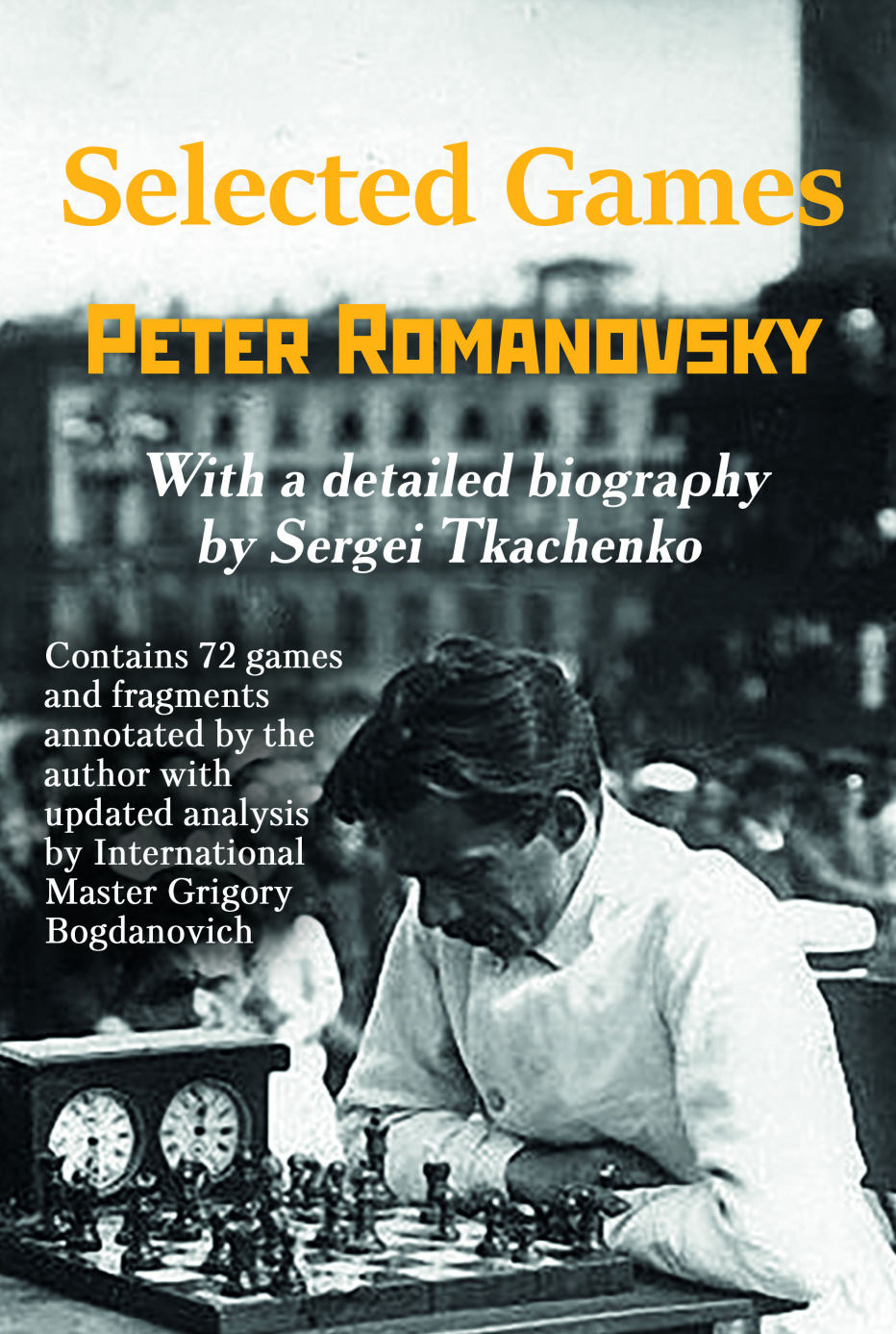
*****Short-listed for the FIDE Book of the Year prize 2022*****
Peter Romanovsky (1892-1964) was Soviet chess champion in 1923 (outright) and 1927 (jointly with Bogatyrchuk). According to Chessmetrics he was ranked 12th in the world in 1925. Romanovsky was also one of Soviet chess’s greatest teachers, standing at the very foundation of the Soviet Chess School. His pupils included Averbakh, Zak, Alatortsev, Lisitsin and many others, and he provided much guidance to Botvinnik in his early career. Author of 16 books, Romanovsky stood for active, fighting and objective chess where the requirements of the position took precedence over positional rules of thumb.
The first half of this book comprises a detailed biography written by chess historian and world chess composition champion Sergei Tkachenko. Tkachenko tells the incredible story of a man who spent nearly a year as a captive in Germany at the start of WWI after participating in the Mannheim chess events of 1914, endured the hardships of Civil War and NEP Russia, won two Soviet championships and lived through the horrors of the Siege of Leningrad in 1941-42, suffering unspeakable family tragedy as he did so. Romanovsky narrowly escaped an early death on three separate occasions.
The second half of this book comprises Romanovsky’s own chess autobiography first published in 1954 in Russian, including 72 of his best games. His instructive annotations have been updated with computer analysis by IM Grigory Bogdanovich, an accomplished historian who published a biography of Bogoljubov in 2020.
Because Romanovsky wrote this book after his career was over, its annotations are considerably more honest than those found in books that collate the annotations of great players made while their career was in full swing. Indeed, in several games Romanovsky comments how his views of certain positions changed over the years as he accumulated greater knowledge and experience.
This book is also a textbook on attacking and positional play. Most games are classified by themes, including Attack on the Castled and Non-Castled King, Counterattack, Attack on the Center, and Queenside Attack. Moreover, it contains discussions on central control, the bishop pair advantage, pawn storms, simplification strategy, exchange sacrifices, king safety, and other key topics.
His opponents include Alekhine, Botvinnik, Bogoljubov, Averbakh, Flohr, Levenfish, Kotov, and many other stars.
Two Knights Save the Day: A World Champion’s Favorite Studies (2022) - in paperback, Amazon Kindle and Forward Chess
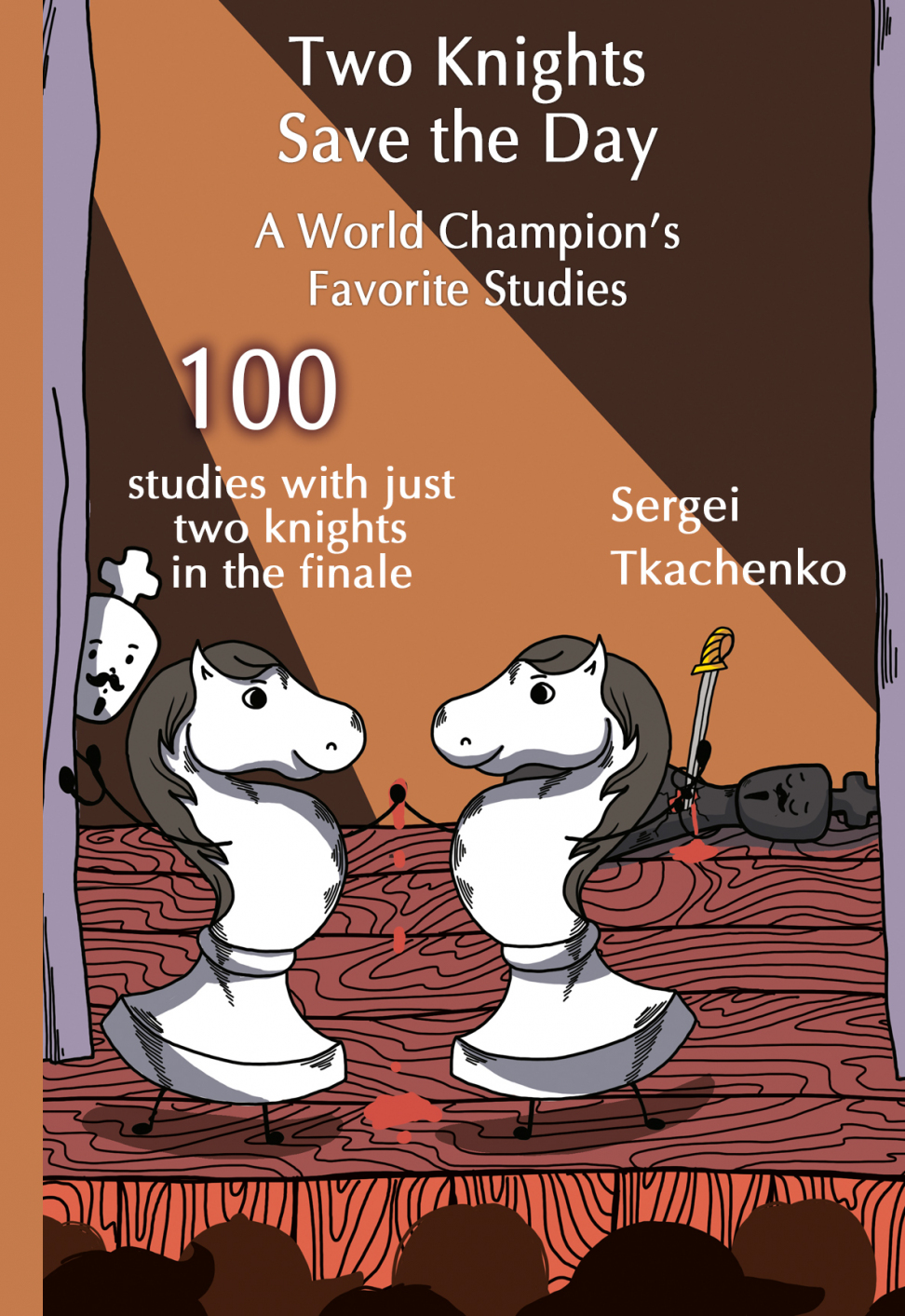
Sergei Tkachenko, a member of the Ukrainian team that won the 5th World Chess Composition Tournament in 1997 and which came second in 2000, 2004, 2013, and 2017, has collected 100 studies whose common theme is that white ends up with just two knights in the finale, yet manages to win or draw.
There are no more than six moves in almost all solutions, so experienced chess players can analyze the positions directly from the diagrams.
Newbies to chess problems will also find analyzing these studies useful. The diverse set of tactical ideas involving two knights in the finale will enable them to gain a deeper understanding of how the knight pair combines.
Some of these studies are classics from bygone ages. Others were originally published in the Soviet Union or ex-Soviet countries.
This is the eighth book in the World Champion’s Favorite Studies series by Sergei Tkachenko to be published by Elk and Ruby Publishing House.
Two Bishops Save the Day: A World Champion’s Favorite Studies (2022) - in paperback, Amazon Kindle and Forward Chess
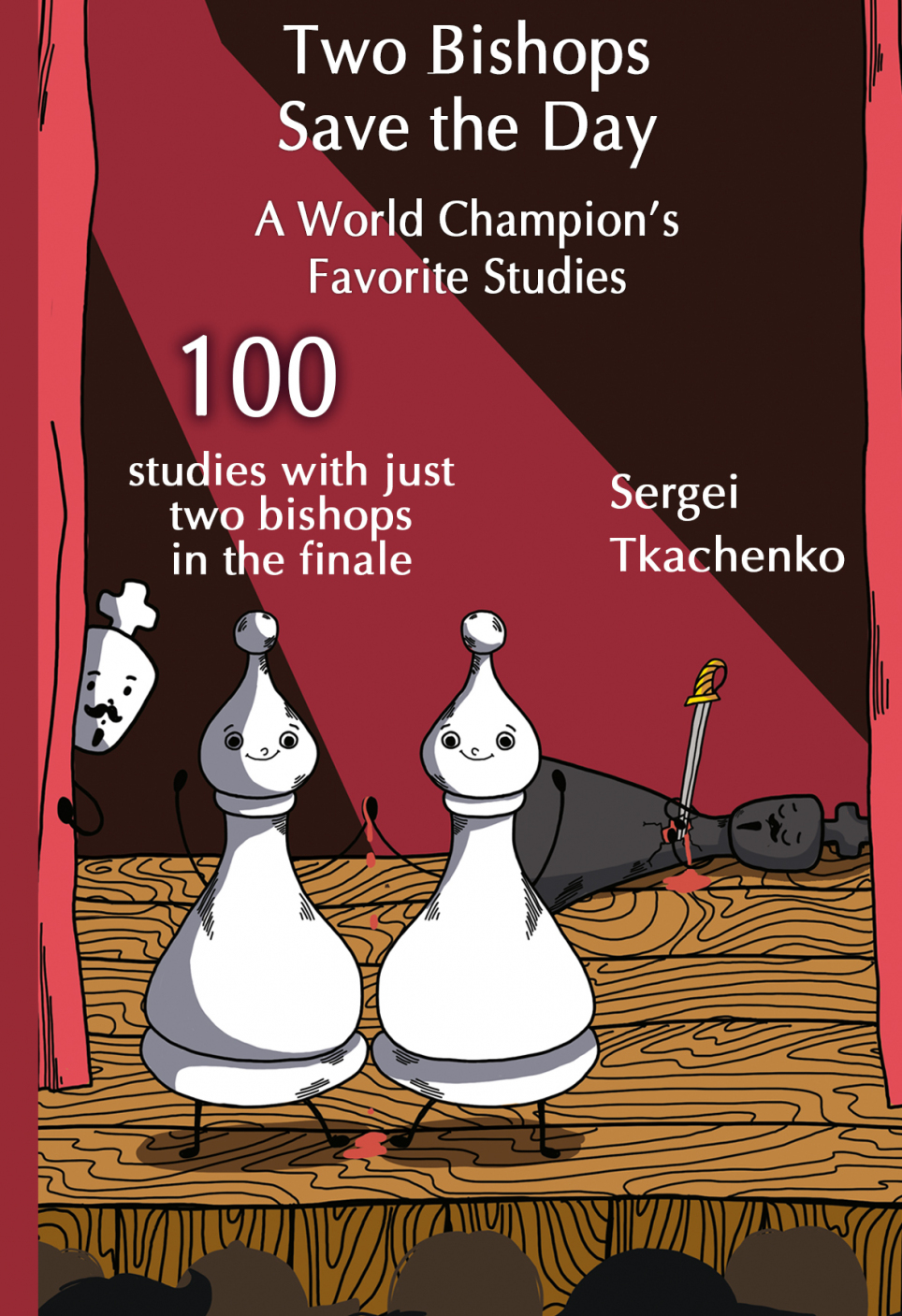
Sergei Tkachenko, a member of the Ukrainian team that won the 5th World Chess Composition Tournament in 1997 and which came second in 2000, 2004, 2013, and 2017, has collected 100 studies whose common theme is that white ends up with just two bishops in the finale, yet manages to win or draw.
There are no more than six moves in almost all solutions, so experienced chess players can analyze the positions directly from the diagrams.
Newbies to chess problems will also find analyzing these studies useful. The diverse set of tactical ideas involving two bishops in the finale will enable them to gain a deeper understanding of how the bishop pair combines.
Some of these studies are classics from bygone ages. Others were originally published in the Soviet Union or ex-Soviet countries.
This is the ninth book in the World Champion’s Favorite Studies series by Sergei Tkachenko to be published by Elk and Ruby Publishing House.
The Pawn Study Composer's Manual by Mikhail Zinar, new edition updated and edited by Sergei Tkachenko (2022) - in paperback, hardback, Amazon Kindle and Forward Chess
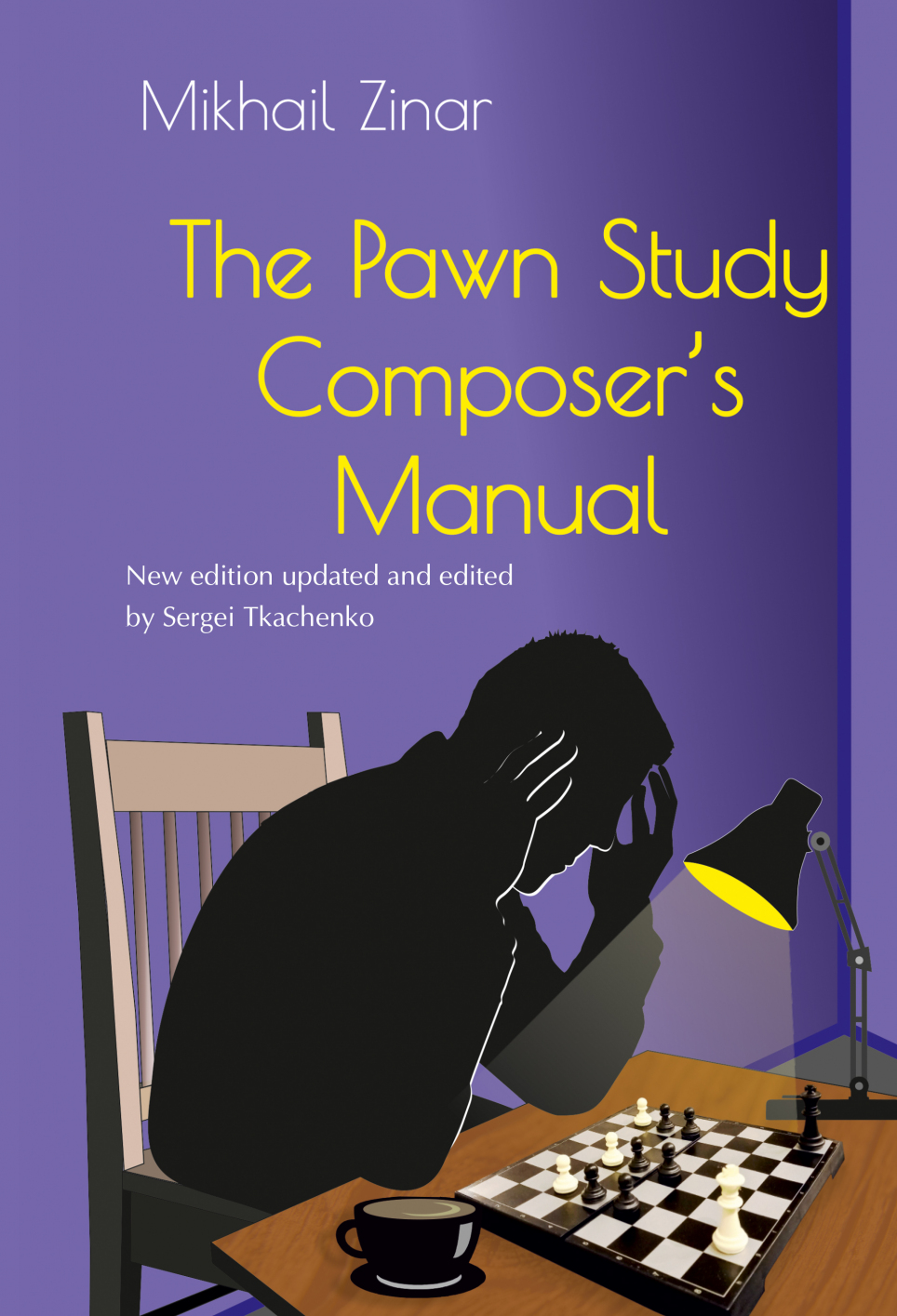
*** SHORT-LISTED FOR THE ENGLISH CHESS FEDERATION BOOK OF THE YEAR AWARD 2023 ***
Have you ever thought about trying your hand at composing endgame studies? Probably not, it always seemed far too difficult. But now, your chance to learn the tools is finally here! Mikhail Zinar's composition manual, first published in Ukraine in 1990 with a 100,000 print run that has long sold out, and now updated and revised by Sergei Tkachenko, reveals the secrets that will give you a head-start in composing chess poetry!
Dissecting over 400 examples, Zinar's manual begins by explaining the basic tactics of pawn studies: simplest maneuvers, roundabout way, feint, tortoise move, queening the pawn, Reti double threat, Reti - Sarychevs feint, luring into check, Grigoriev anti-check feint, anti-check retreat and king double threat (Eilazyan branch). It then goes on to consider key study ideas, including beacons, winning a pawn, checkmate, stalemate, anti-stalemate, underpromotions, studies with two or more phases, domination, anti-domination and logical studies. Further sections of the book cover artistic requirements for endgame studies, practical tips and a series of demanding tests that you may spend days, weeks or even months completing!
Careful study of this book will not turn you into an overnight prize-winning sensation, but following its recommendations and putting in hard work will place you firmly on the right path. Today's leading Ukrainian studies composer Sergei Didukh told Sergei Tkachenko that he read Zinar's manual several times before he composed his first study.
Mikhail Zinar (1950-2021) was considered the world's leading pawn studies composer in his life-time, inheriting the mantle from Nikolai Grigoriev. He composed several hundred studies in his career, winning multiple prizes. Zinar was awarded the title of Master of Sports of the USSR in 1987 and won the bronze medal in the studies competition of the 3rd FIDE World Cup in Composing in 2013. He lived his last years in Hvozdavka near Odesa in Ukraine.
First Grandmaster of the Soviet Union: A Chess Biography of Boris Verlinsky (2023) - in paperback, hardback, Amazon Kindle and Forward Chess
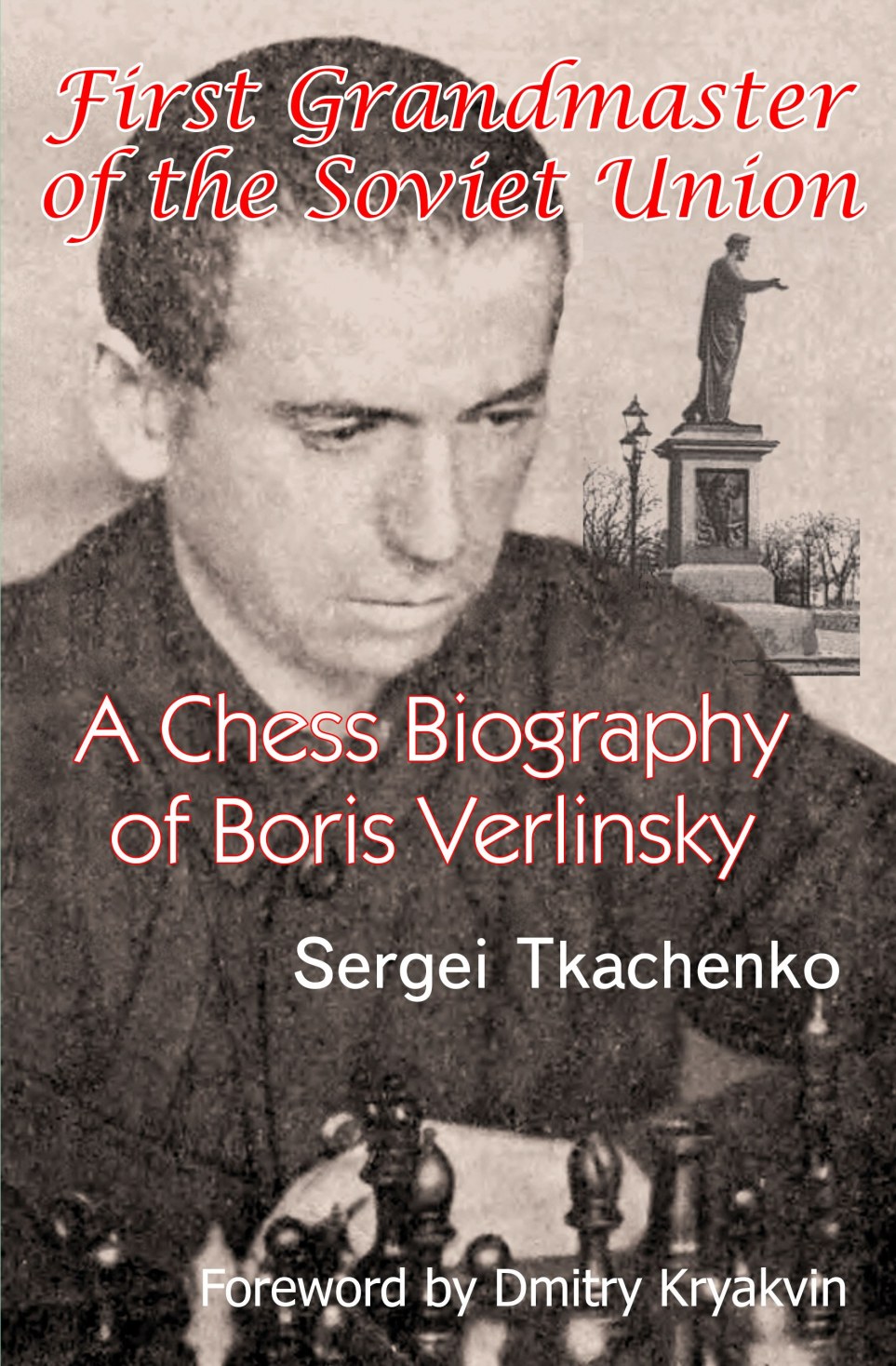
Born in Bakhmut, Ukraine, and brought up in Odessa, Boris Verlinsky (1888-1950) was the first holder of the grandmaster title in the Soviet Union, and he was consistently one of the top Soviet players in the 1920s.
He earned the master’s title at the 1924 Soviet Championship and won fourth prize at the 1925 Championship, defeating the tournament winner Bogoljubov along the way. Verlinsky then crushed Capablanca at the 1925 Moscow International Tournament, where he finished twelfth equal with Rubinstein and Spielmann, both of whom he also beat. He won the Soviet Championship in 1929, for which he was awarded the grandmaster title, and came third in 1931 despite poor health. Verlinsky played in five Soviet Championship finals in total. He also won a number of other major Tsarist and Soviet-era tournaments, including the Southern Russia Championship, Odessa Championship, Ukrainian Championship, Moscow Championship and others. Moreover, he achieved all this despite being profoundly deaf.
According to the Chessmetrics website, Verlinsky’s highest world ranking was #15 in 1926, and that year he achieved his highest rating of 2627.
Verlinsky possessed a sharp attacking style. As Grandmaster Dmitry Kryakvin highlights in his foreword, “I think that this great attacking player was way ahead of his time, and in his best years he played spectacular, beautiful, dynamic and modern chess more characteristic of the famous players of the second half of the twentieth century. As you study Verlinsky’s brilliant victories, you think of the masterpieces of Mikhail Tal, Leonid Stein, Viktor Kupreichik, Alexei Shirov, and other modern successors of the ‘Fire-On-Board’ dynasty.”
Ukrainian historian and former world champion at composing chess studies Sergei Tkachenko presents a comprehensive biography of this unique player. This book analyzes 130 games and fragments, in which opponents include Capablanca, Alekhine, Botvinnik, Bronstein, Bogoljubov, Spielmann and other stars. The games are frequently annotated by Verlinsky or his opponents and contemporaries, and they have all been reviewed using modern engines by grandmasters or international masters especially for this work.
YouTube review by WIM Charlize van Zyl
Tigran Gorgiev, Maestro of Practical Studies: A World Champion’s Favorite Composers (2018) - in paperback, Amazon Kindle and Forward Chess
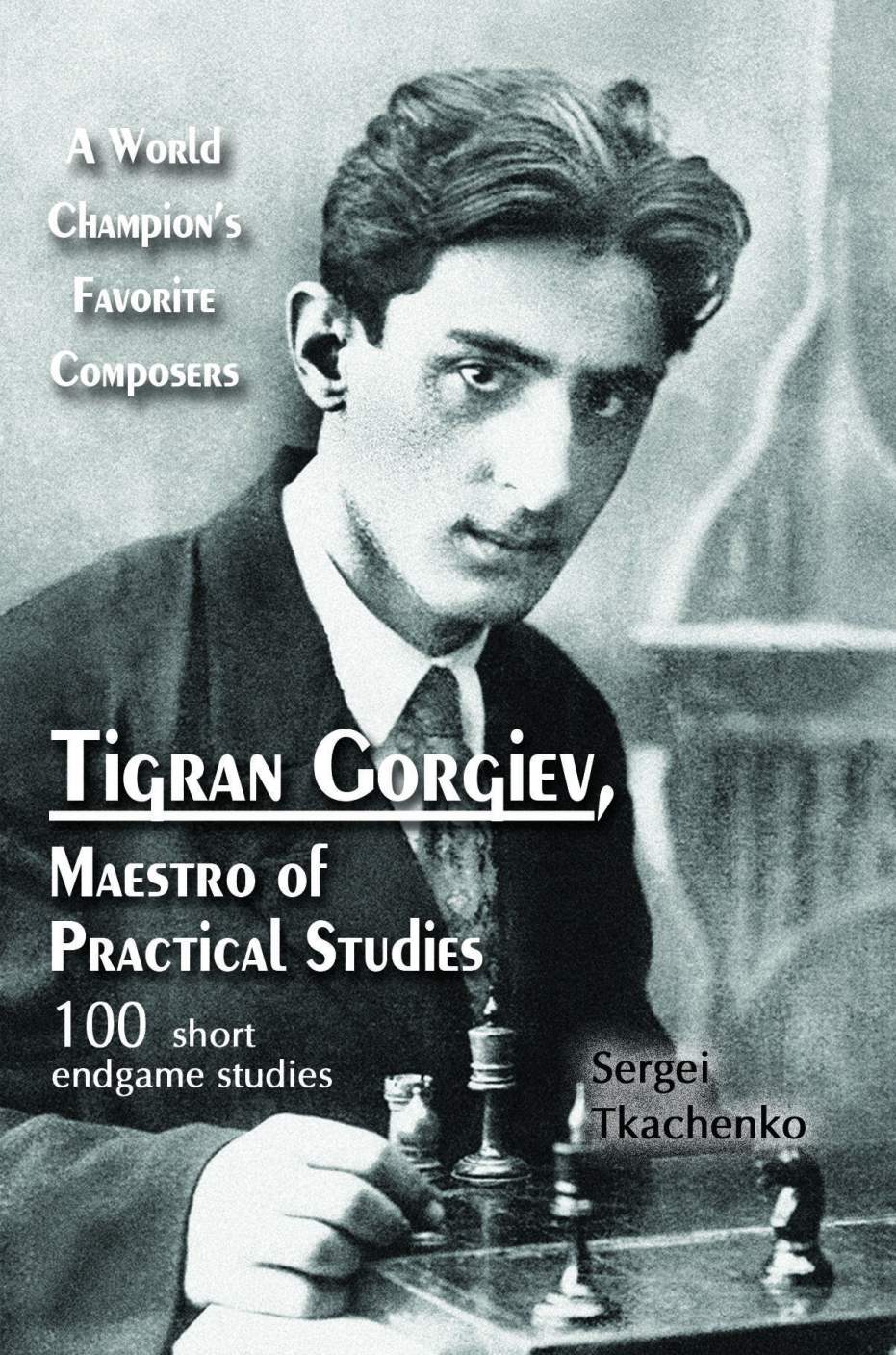
Tigran Gorgiev (1910-1976) was one of the Soviet Union’s best endgame study composers. In his lifetime he produced around 400 studies and wrote three books and 101 articles with chess compositions. The vast majority of his endgame studies are of a practical nature, meaning that the positions presented could have arisen in over-the-board play. This makes them particularly useful to study for practical players as well as study fans.
Sergei Tkachenko, a member of the Ukrainian team that won the 5th World Chess Composition Tournament in 1997 and which came second in 2000, 2004, 2013, and 2017, has selected his 100 favorite Tigran Gorgiev studies, revising some of them and providing explanations suitable for less experienced solvers. There are no more than six moves in most solutions, so experienced chess players can analyze the positions directly from the diagrams.
This is the third book in a series of studies and problems compiled by Sergei Tkachenko, in which each book focuses on a particular composer, published by Elk and Ruby Publishing House.
Mikhail Zinar's Difficult Pawn Endings: A World Champion's Favorite Composers (2018) - in paperback, Amazon Kindle and Forward Chess
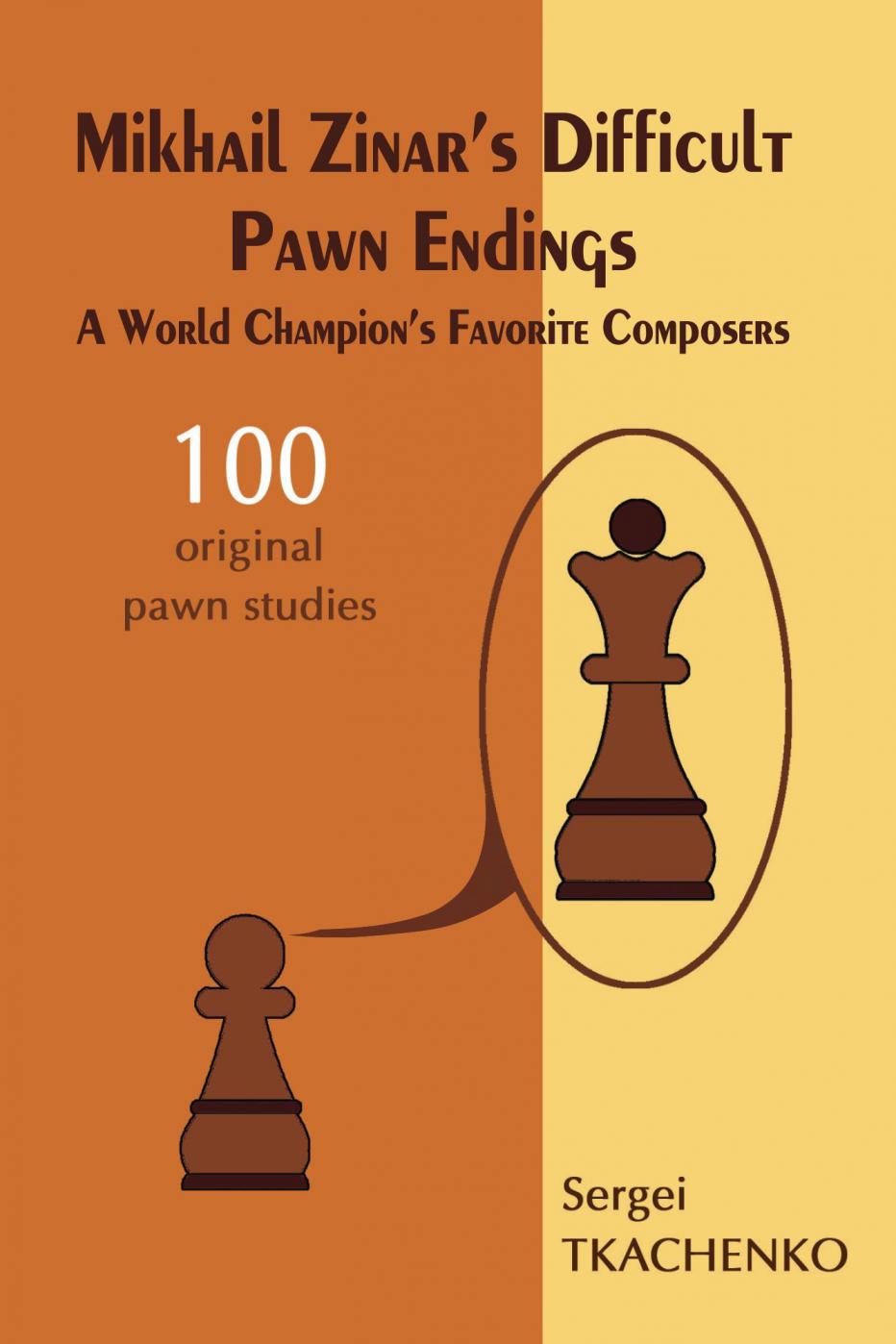
Sergei Tkachenko, a member of the Ukrainian team that won the 5th World Chess Composition Tournament in 1997 and which came second in 2000, 2004, 2013, and 2017, has selected 100 pawn endings composed by the leading Ukrainian problemist Mikhail Zinar.
Zinar is a prolific endgame expert who has produced several hundred studies since the 1970s, with a focus on pawn endings. His works have appeared in many leading Russian-language chess publications, including Chess in the USSR, 64 – Chess Review, and Chess Bulletin. He collaborated with Yuri Averbakh on the second edition of Averbakh’s Chess Endings (1983), in which he revised the theory of “corresponding squares”. In the foreword, Averbakh wrote: “Chapter ten, devoted to corresponding square systems, was written by chess composer M.A. Zinar – a big specialist in pawn endings. Otherwise, this chapter would have looked out of date.”
Zinar co-authored a Russian-language manual for creating pawn studies with Vladimir Archakov in 1990 called Harmony of the Pawn Study. He collaborated with Tkachenko in compiling this book.
This is the first book in a new series of endgame studies compiled by Sergei Tkachenko, in which each book focuses on a particular composer, published by Elk and Ruby Publishing House.
Nikolai Rezvov, from Child Burglar to Grandmaster: A World Champion's Favorite Composers (2018) - in paperback, Amazon Kindle and Forward Chess
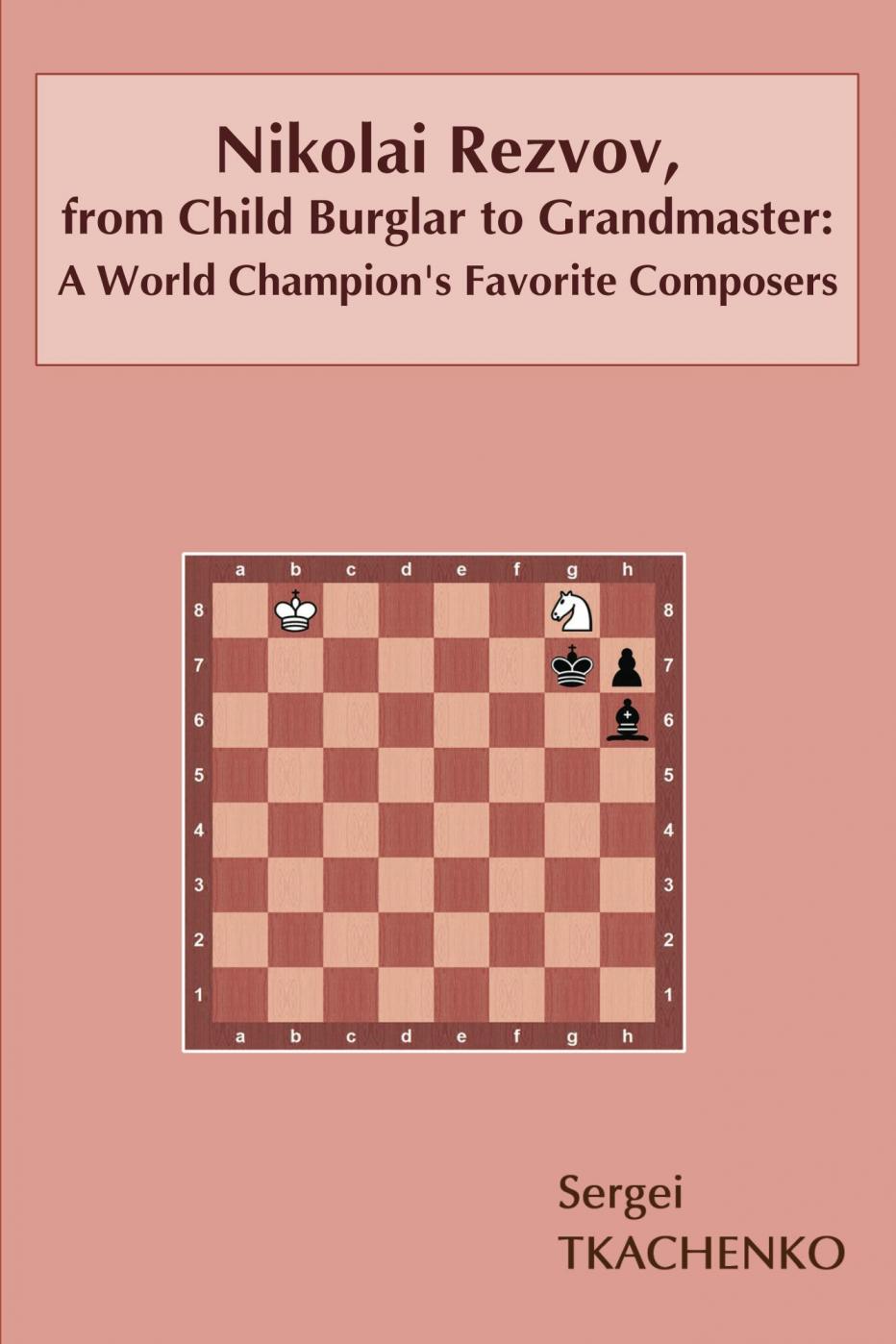
Sergei Tkachenko, a member of the Ukrainian team that won the 5th World Chess Composition Tournament in 1997 and which came second in 2000, 2004, 2013, and 2017, has selected 100 studies and problems by Odessite chess master Nikolai Vasilevich Rezvov (1921–2013), which will help you to appreciate the splendor and depth of the royal game.
Rezvov lived a long and tragic life: it was at the age of nearly 90 that he was awarded the titles of Ukrainian chess composition grandmaster and FIDE chess composition international master, and his love of chess kept him going through life as a child laborer, WWII solder, prisoner of war and later prisoner in the Soviet Union. His compositions appeared in leading chess magazines such as Chess in the USSR, 64 – Chess Review and The Problemist, and he won many prizes. Several of these compositions were produced jointly with Sergei Tkachenko.
The readers will find these studies and problems highly educational, illustrating many theoretical and combinational ideas that can be used in the readers’ own games. Some of them are simply breathtaking in their beauty and originality.
This is the second book in a series of studies and problems compiled by Sergei Tkachenko, in which each book focuses on a particular composer, published by Elk and Ruby Publishing House.
One Pawn Saves the Day: A World Champion’s Favorite Studies (2017) - in paperback, Amazon Kindle and Forward Chess
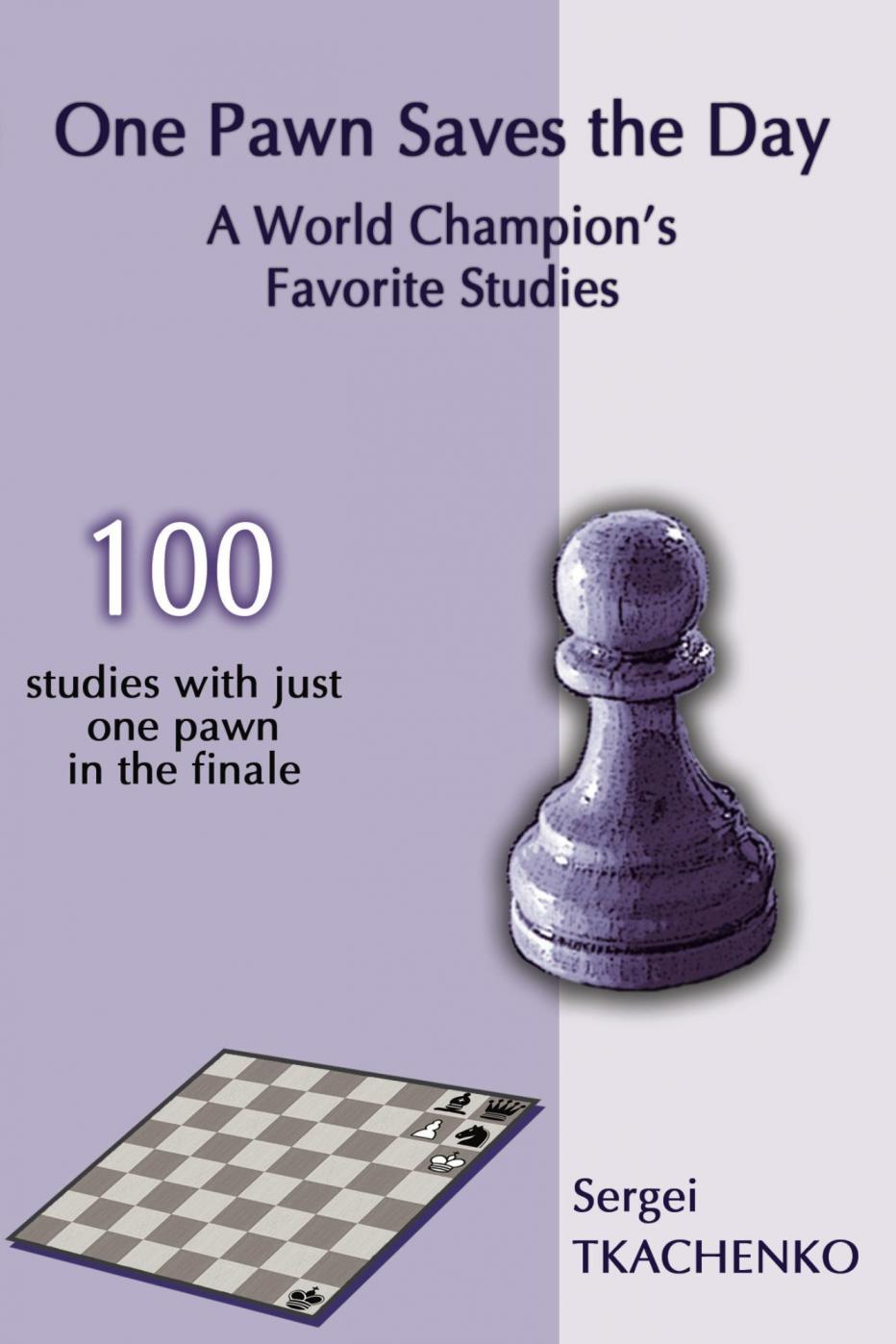
Learn great traps, turn losses into draws and draws into wins!
Sergei Tkachenko has collected 100 studies whose common theme is that white ends up with just one pawn in the finale, yet manages to win or draw.
With the exception of three studies, there are no more than six moves in any solution, so experienced chess players can analyze the positions directly from the diagrams.
Newbies to chess problems will also find analyzing these studies useful. The diverse set of tactical ideas involving a single pawn in the finale will enable them to gain a deeper understanding of the pawn's resourcefulness.
Some of these studies are classics from bygone ages. Others were originally published in the Soviet Union.
One Knight Saves the Day: A World Champion’s Favorite Studies (2017) - in paperback, Amazon Kindle and Forward Chess
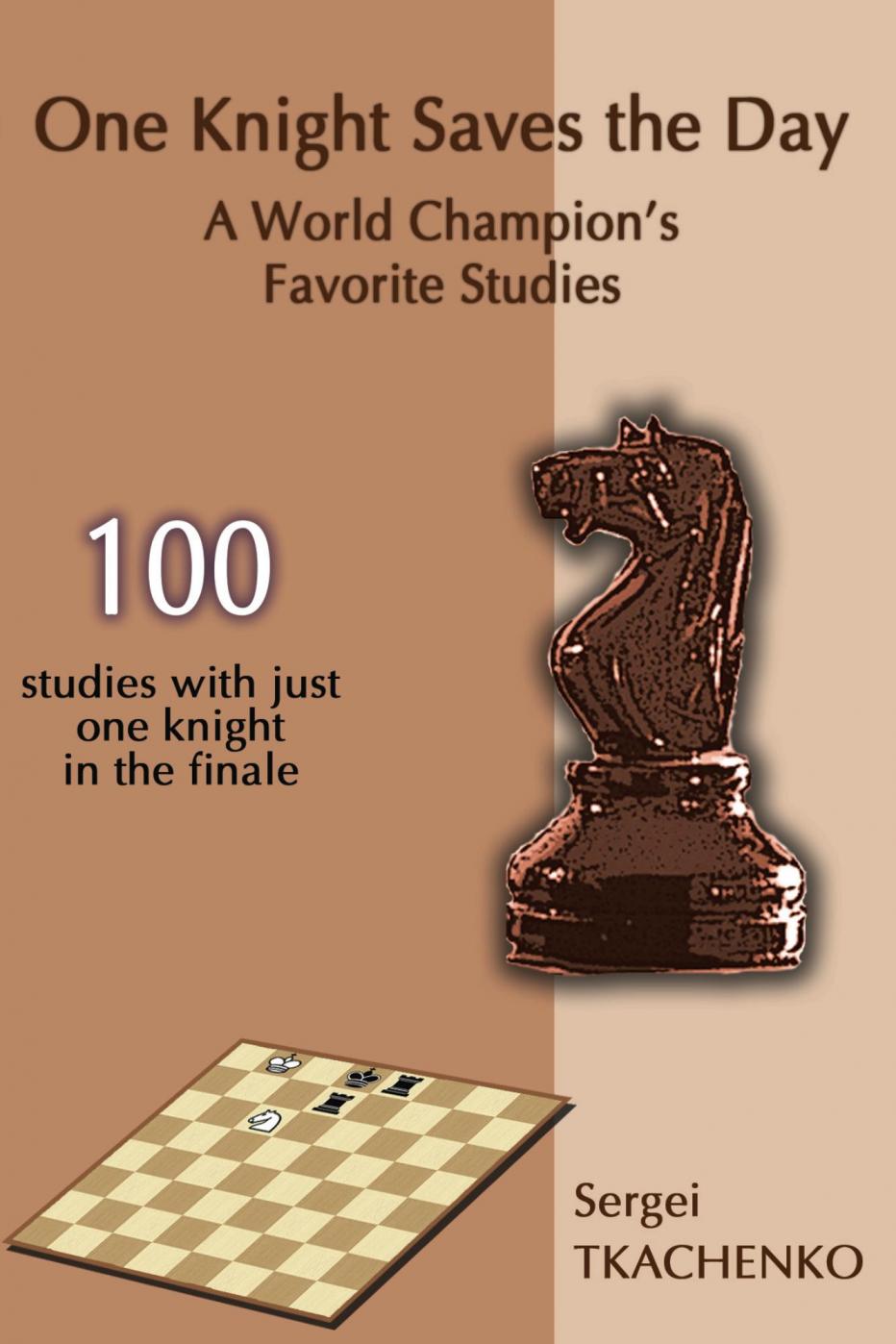
Learn great traps, turn losses into draws and draws into wins!
Sergei Tkachenko, a member of the Ukrainian team that won the 5th World Chess Composition Tournament in 1997 and which came second in 2000, 2004, 2013, and 2017, has collected 100 studies whose common theme is that white ends up with just one knight in the finale, yet manages to win or draw.
There are no more than six moves in most solutions, so experienced chess players can analyze the positions directly from the diagrams. Newbies to chess problems will also find analyzing these studies useful. The diverse set of tactical ideas involving a single knight in the finale will enable them to gain a deeper understanding of the knight’s resourcefulness.
Some of these studies are classics from bygone ages. Others were originally published in the Soviet Union or ex-Soviet countries. Several are Sergei’s own compositions.
This is the second book in a series of endgame studies by Sergei Tkachenko to be published by Elk and Ruby Publishing House.
One Bishop Saves the Day: A World Champion’s Favorite Studies (2017) - in paperback, Amazon Kindle and Forward Chess
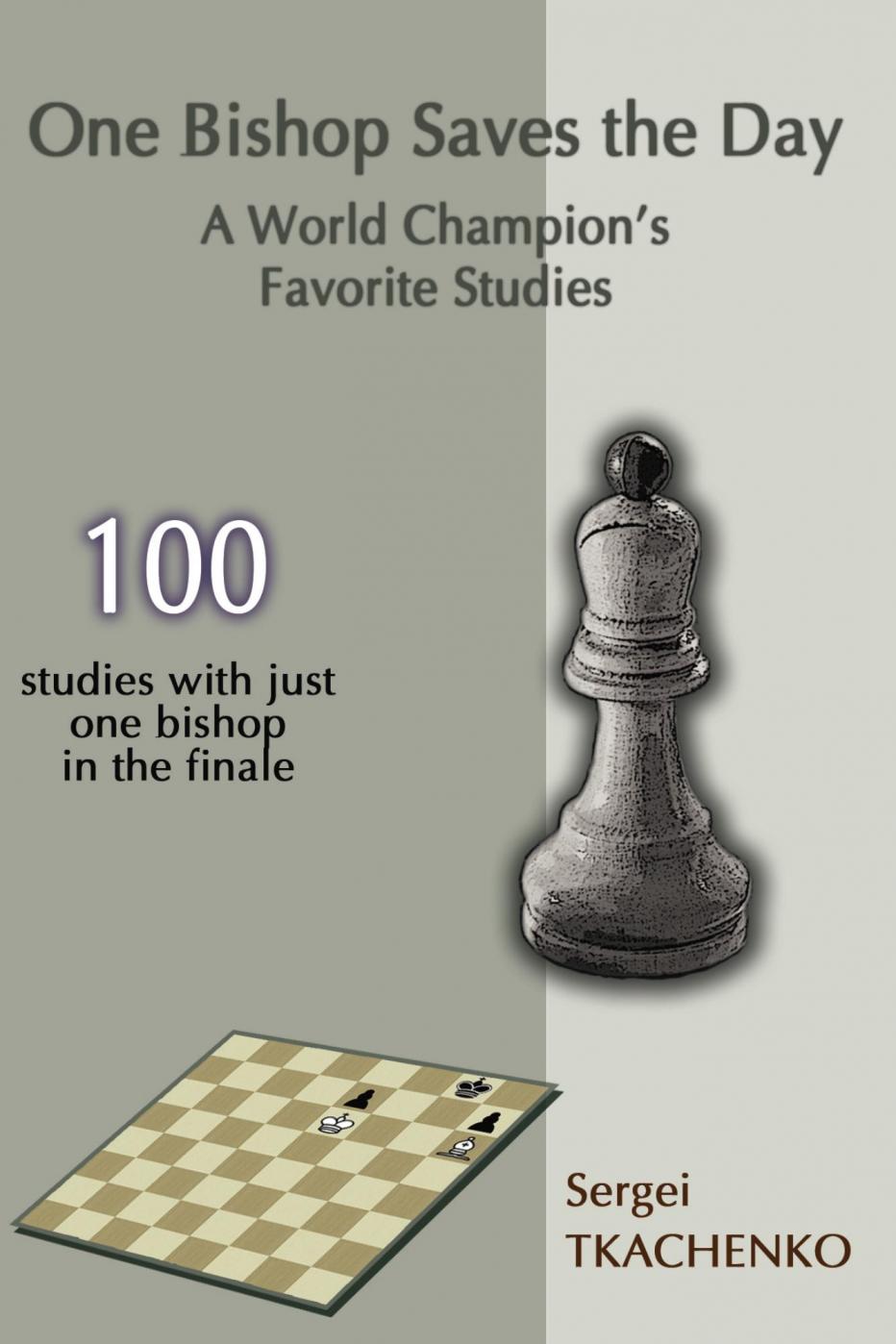
Learn great traps, turn losses into draws and draws into wins!
Sergei Tkachenko, a member of the Ukrainian team that won the 5th World Chess Composition Tournament in 1997 and which came second in 2000, 2004, 2013, and 2017, has collected 100 studies whose common theme is that white ends up with just one bishop in the finale, yet manages to win or draw.
There are no more than six moves in any solution, so experienced chess players can analyze the positions directly from the diagrams. Newbies to chess problems will also find analyzing these studies useful. The diverse set of tactical ideas involving a single bishop in the finale will enable them to gain a deeper understanding of the bishop’s resourcefulness.
Some of these studies are classics from bygone ages. Others were originally published in the Soviet Union or ex-Soviet countries. Several are Sergei’s own compositions.
This is the third book in a series of endgame studies by Sergei Tkachenko to be published by Elk and Ruby Publishing House.
One Rook Saves the Day: A World Champion’s Favorite Studies (2017) - in paperback, Amazon Kindle and Forward Chess
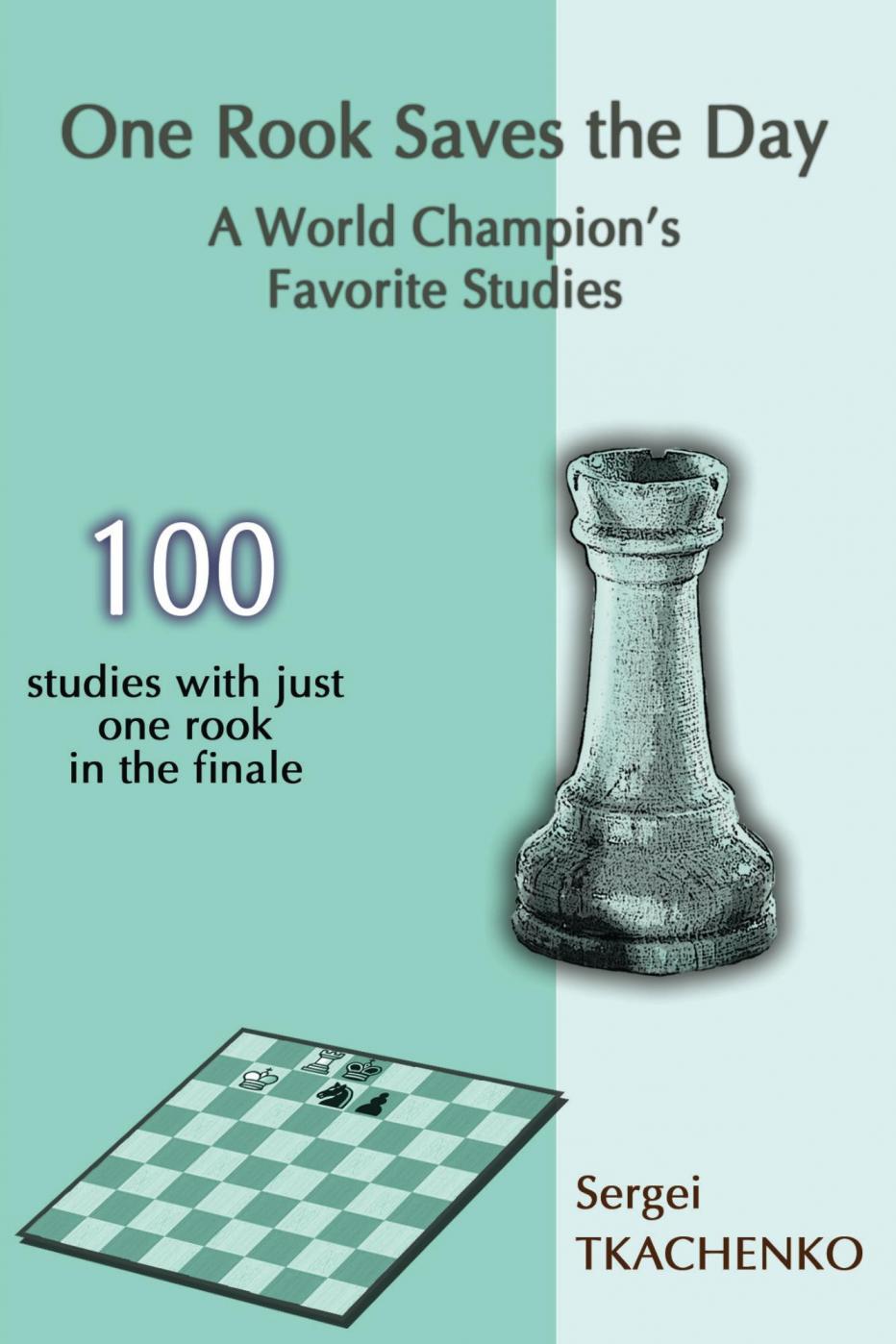
Learn great traps, turn losses into draws and draws into wins!
Sergei Tkachenko, a member of the Ukrainian team that won the 5th World Chess Composition Tournament in 1997 and which came second in 2000, 2004, 2013, and 2017, has collected 100 studies whose common theme is that white ends up with just one rook in the finale, yet manages to win or draw.
There are no more than six moves in almost all solutions, so experienced chess players can analyze the positions directly from the diagrams. Newbies to chess problems will also find analyzing these studies useful. The diverse set of tactical ideas involving a single rook in the finale will enable them to gain a deeper understanding of the rook’s resourcefulness.
Some of these studies are classics from bygone ages. Others were originally published in the Soviet Union or ex-Soviet countries. Several are Sergei’s own compositions.
This is the fourth book in a series of endgame studies by Sergei Tkachenko to be published by Elk and Ruby Publishing House.
The Queen Saves the Day: A World Champion’s Favorite Studies (2018) - in paperback, Amazon Kindle and Forward Chess
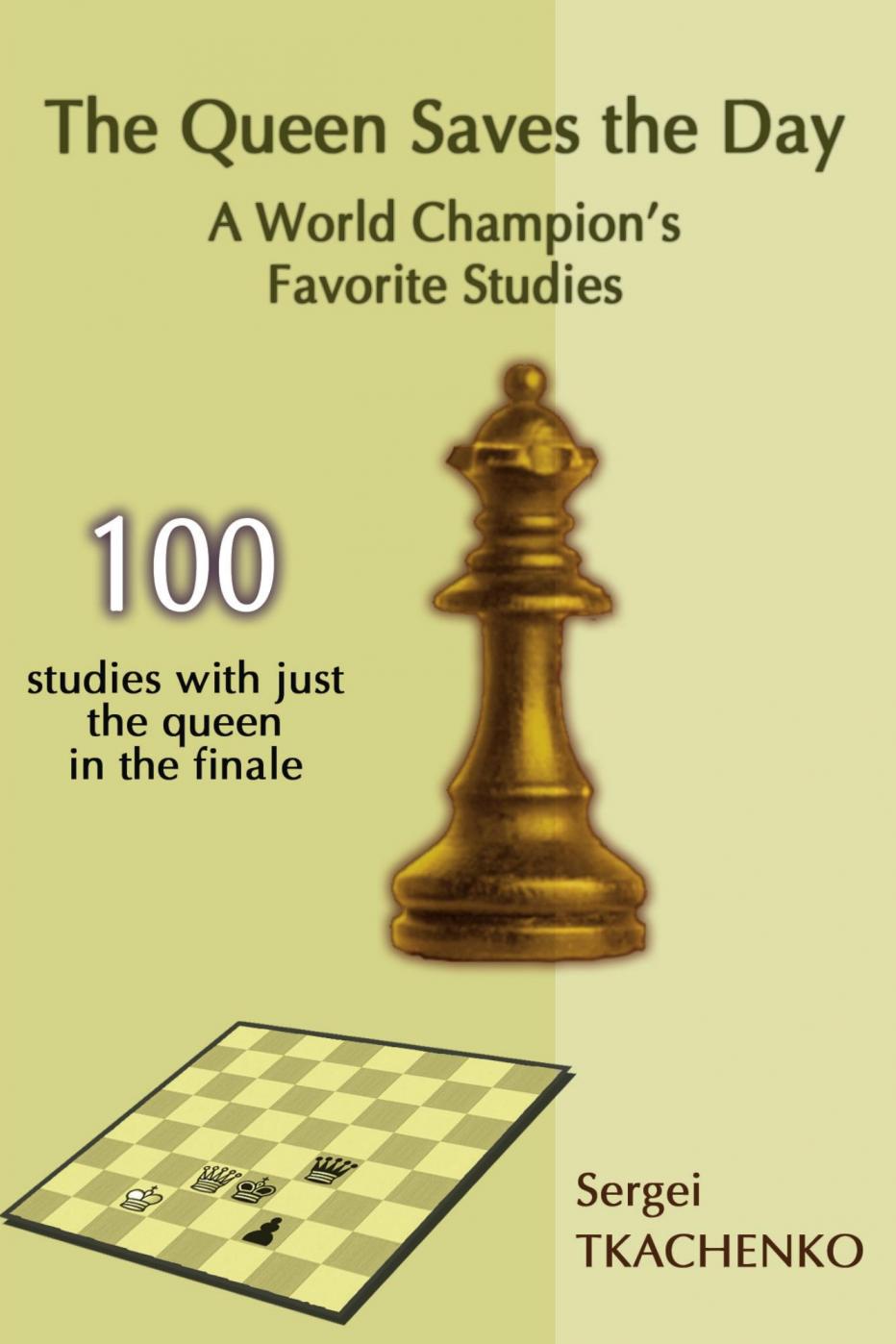
Learn great traps, turn losses into draws and draws into wins!
Sergei Tkachenko, a member of the Ukrainian team that won the 5th World Chess Composition Tournament in 1997 and which came second in 2000, 2004, 2013, and 2017, has collected 100 studies whose common theme is that white ends up with just the queen in the finale, yet manages to win or draw.
There are no more than six moves in almost all solutions, so experienced chess players can analyze the positions directly from the diagrams. Newbies to chess problems will also find analyzing these studies useful. The diverse set of tactical ideas involving a single queen in the finale will enable them to gain a deeper understanding of the queen’s resourcefulness.
Some of these studies are classics from bygone ages. Others were originally published in the Soviet Union or ex-Soviet countries. Several are Sergei’s own compositions.
This is the fifth book in a series of endgame studies by Sergei Tkachenko to be published by Elk and Ruby Publishing House.
The King Saves the Day: A World Champion’s Favorite Studies (2018) - in paperback, Amazon Kindle and Forward Chess
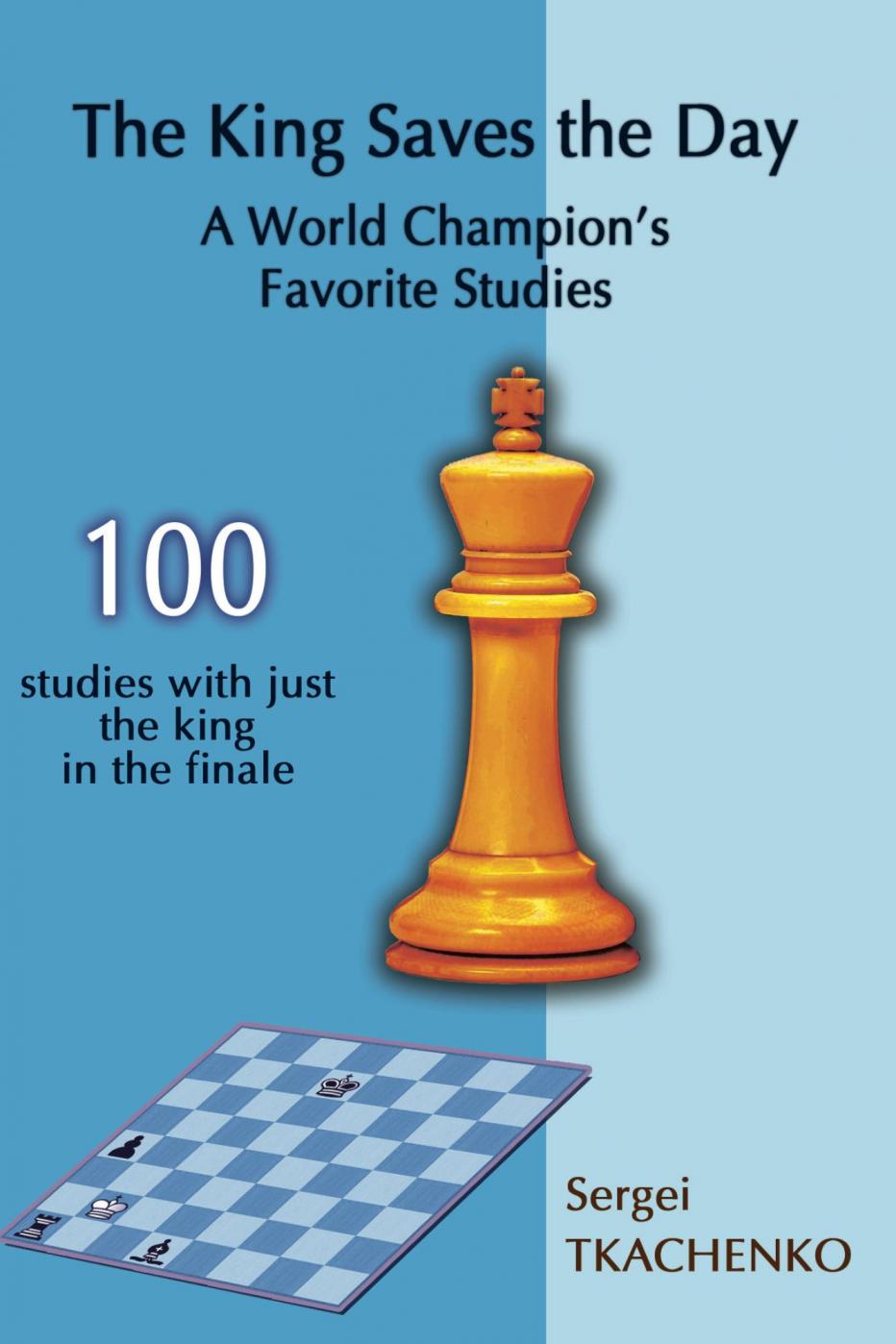
Learn great traps, turn losses into draws!
Sergei Tkachenko, a member of the Ukrainian team that won the 5th World Chess Composition Tournament in 1997 and which came second in 2000, 2004, 2013, and 2017, has collected 100 studies whose common theme is that white ends up with just one king in the finale, yet manages to draw.
There are no more than six moves in almost all solutions, so experienced chess players can analyze the positions directly from the diagrams. Newbies to chess problems will also find analyzing these studies useful. The diverse set of tactical ideas involving the king in the finale will enable them to gain a deeper understanding of the king's resourcefulness.
Some of these studies are classics from bygone ages. Others were originally published in the Soviet Union or ex-Soviet countries. Several are Sergei’s own compositions.
This is the sixth book in a series of endgame studies by Sergei Tkachenko to be published by Elk and Ruby Publishing House.
Valentin Kirillov
Valentin Kirillov (1938-2017) was a Latvian chess master, coach, and journalist. He took part in numerous Latvian and Baltic states championships, as well as the 1967 USSR championship in Kharkov, the USSR team championships, international tournaments in Hungary, Poland, Finland, France, and the Czech Republic, and the German team championships, playing for Godesburg (Bonn) and Brakel (Dortmund).
Mikhail Tal’s second (1968-1976), coach and captain of Latvia’s national teams at Soviet championships, Deputy Director of the Latvian Chess Club, head coach of the Latvian Republic and of the Latvian members of the USSR National Team. Executive Secretary and Executive Director of the Latvian Chess Federation. He worked as a chess coach in several countries abroad.
Kirillov wrote and edited chess columns for various Soviet and Latvian publications. He authored a seven-volume treatise considered to be the definitive Russian-language work analyzing Tal’s games, among other books.
Team Tal: An Inside Story (2017) - in paperback and Amazon Kindle
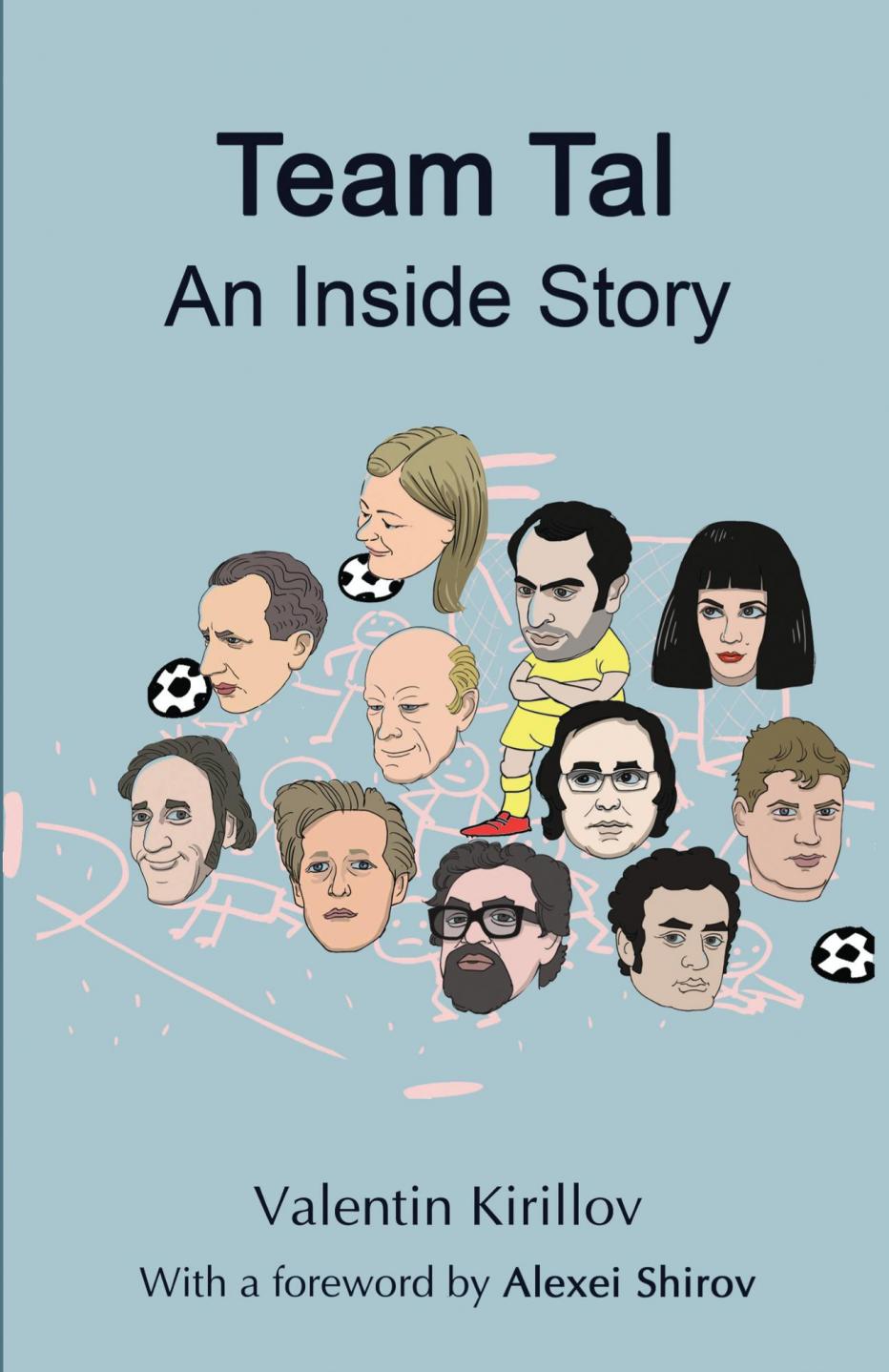
First published in Russian in 2016, this memoir describes key events from Tal’s life, portrays his mentors and opponents, and reveals previously unknown facts and funny stories about the Magician of Riga.
A real collectors’ item for all true Tal fans, it provides color on Janis Kruzkops, who was Tal’s first coach and who died tragically young, Tal’s mentor Alexander Koblencs, and the chess masters to whom Tal was close, including Genna Sosonko, Aivars Gipslis, Janis Klovans, Alvis Vitolins, the young Alexei Shirov, and Kirillov himself, as well as the mysterious doctor Joseph Geikhman. It also traces the efforts of the Latvian chess community to preserve and build on Tal’s memory after his death, in particular with the attempt to establish a Tal museum and hold regular tournaments in his honour.
With a foreword to the English edition by Alexei Shirov.
The Livonian Knight: Selected Games of Alvis Vitolins, by Zigurds Lanka, Edvins Kengis, Janis Klovans and Janis Vitomskis (2021) - in paperback, Amazon Kindle and Forward Chess
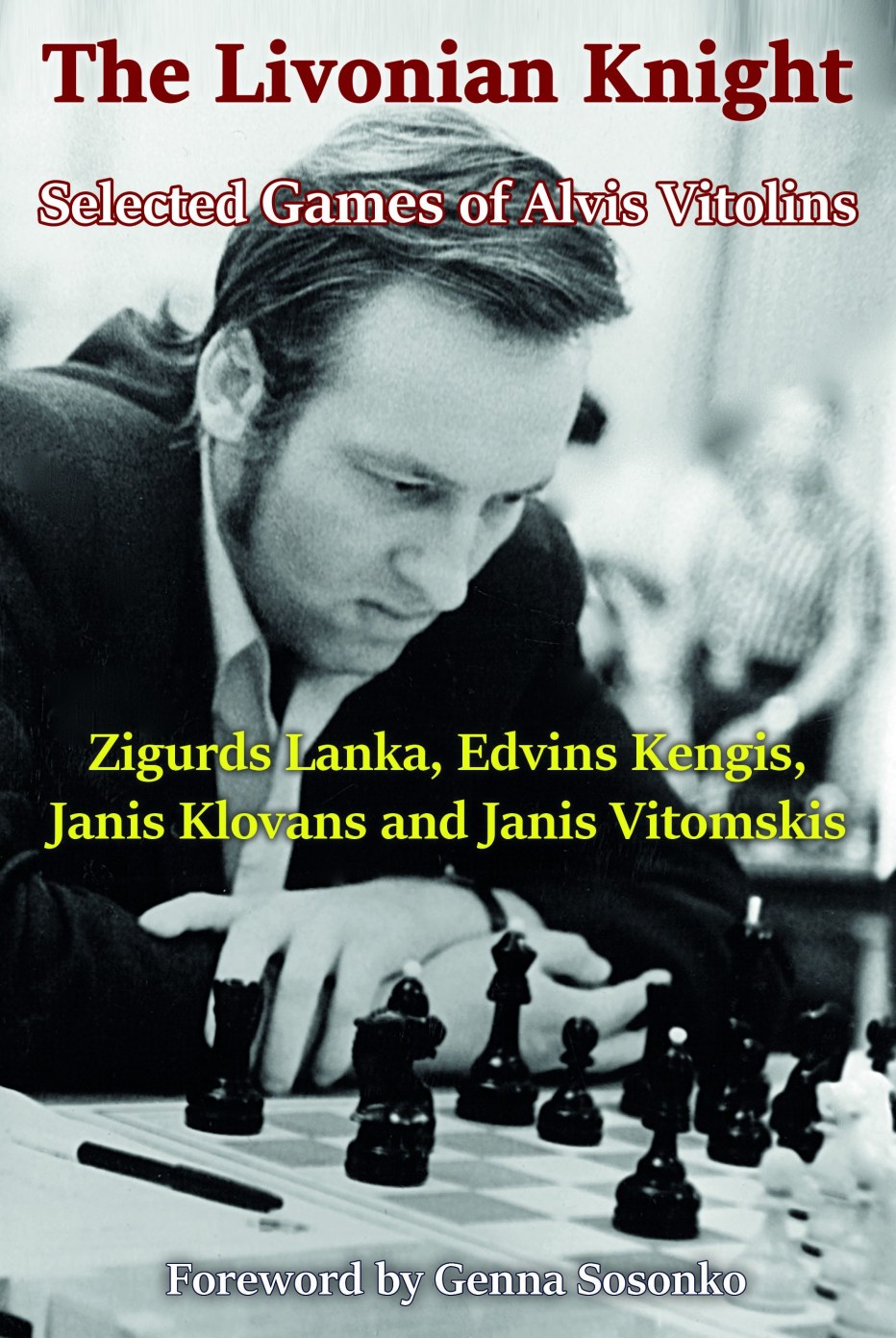
Alvis Vitolins (1946-1997) was a seven-time chess champion of Latvia, a player with a ferocious attacking style, and one of the game’s last true openings innovators in the pre-computer age. He was a world-class blitz player and was a regular blitz sparring-partner of his friend, world champion Mikhail Tal. Vitolins often deployed gambits, and his attack-minded novelties in the Ruy Lopez, Sicilian, Nimzo-Indian and Bogo-Indian set trends that were copied at top-level chess, including in world championship and candidates matches. He gained the International Master title in 1980.
Through an analysis of 25 of his most exciting games, this book, first published in Latvia in 2008, tells the reader of Alvis’s chess legacy, which includes many breathtaking Talesque sacrifices. Additional full games and fragments from Vitolins’s career are incorporated in the annotations. Opponents include the authors of this book as well as grandmasters Alexei Shirov, Vladimir Bagirov, Vladimir Tukmakov and other stars of Soviet and post-Soviet chess.
The book contains a new foreword specially written for the English edition by Genna Sosonko, who met Vitolins on several occasions.
About the authors
Zigurds Lanka (born 1960) and Edvins Kengis (born 1959) are Latvian Grandmasters, coaches and multiple chess champions of Latvia (two and eight times, respectively). Janis Klovans (1935-2010) was a Latvian Grandmaster and correspondence chess Grandmaster, nine-time champion of Latvia and three-time world senior champion. Janis Vitomskis (1936-2009) was a Latvian correspondence chess Grandmaster and European correspondence chess champion.


Sergei Belavenets (1910-1942) was one of the strongest Soviet chess masters of the 1930s and early 1940s, a renowned theoretician and journalist. He competed in three Soviet championship finals, finishing 3rd in 1939. He also won the Moscow championship twice. Sergei was working on a manual for club players, but his book remained unfinished – he perished on the front lines early in World War II, defending Leningrad from the Nazi invaders.
His daughter Ludmila Belavenets (1940-2021) also dedicated her life to chess: she won Soviet and Moscow women’s chess championships and became women’s world correspondence chess champion in 1992. Ludmila seconded Alla Kushnir at three world championship matches against Nona Gaprindashvili and spent decades as a leading chess coach of the USSR and then Russia. Her most successful pupils included grandmasters Morozevich, Sokolov, Oparin, and Vyzmanavin.
Ludmila edited the textbook materials prepared by her father – over 70 pages of high-quality instruction on middlegame and endgame strategy illustrated with 36 fragments involving top contemporary players such as Capablanca, Alekhine, Euwe, Botvinnik and Smyslov – and first published them in the USSR in 1963 in her book Master Sergei Belavenets. Indeed, Dvoretsky stated in an interview that the 1963 book prompted him to work on his own endgame notes.
Ludmila then included them together with 31 of her father’s best games and 22 of her own for this book, annotated in detail. Sergei’s games are mostly against famous players such as Keres, Flohr, Kotov, Lilienthal, and Levenfish. Ludmila’s games are mostly against top female correspondence players.
Further, Ludmila added substantial biographical history as well as family and tournament photographs. The book is supplemented with reflections on the life and legacy of Sergei Belavenets by leading peers including Averbakh and Levenfish. It was written together with Grandmaster Sergey Yanovsky and International Master Vladimir Barsky, both of whom were close to Ludmila in the second half of her career. All games and materials were updated using the latest engines by International Master Tibor Karolyi for the 2024 English version.
This book is available in three editions – paperback, hardback and full-color hardback. The full-color version is only available from specialist chess bookshops.
Chess Family Belavenets, by Ludmila Belavenets, Sergey Yanovsky and Vladimir Barsky (2024) - in paperback, hardback, full-color hardback and Amazon Kindle
Critical Theory: A Chess Biography of Isaak Lipnitsky (2024) - in paperback, hardback, Amazon Kindle and Forward Chess
Isaak Lipnitsky (1923–1959) was a leading Ukrainian chess player of the early 1950s as well as a celebrated chess theoretician and journalist, whose textbook Questions of Modern Chess Theory became an internationally recognized classic. Born in Kiev shortly after the establishment of Soviet control over Ukraine, he achieved a career-best result of second equal in the 1950 Soviet Championship, half a point behind the winner Paul Keres, during which he defeated Petrosian, Smyslov, and Geller. He also played in the finals of the 1951 and 1952 Soviet Championships, as well as winning the Ukrainian Championship in 1949 and 1956, and the Kiev Championship in 1956. According to the Chessmetrics website Lipnitsky was ranked no. 12 in the world between September and December 1950 with a peak rating of 2700 and a best TPR of 2729 recorded in the 1950 Soviet Championship.
In the words of Grandmaster Kevin Spraggett: “As a player Lipnitsky was well trained in strategy and tactics, capable of playing all types of positions equally well. However, what he really liked doing was playing complicated positions, a trait that many of the finest Ukraine masters seemed to have inherited.”
Lipnitsky’s fascinating biography with original research by the authors takes us from his childhood in a poor Jewish family, through to his membership of the Kiev children’s chess club at the Pioneer Palace under the tutelage of the great coach Alexander Konstantinopolsky, who nurtured David Bronstein’s talent at the same time. It introduces the reader to the origins of the Soviet Chess School in Kiev, which was one of the USSR’s greatest talent mills. Lipnitsky’s World War Two service as an intelligence officer is discussed, as is what is known of his wife and daughter and his eventual full-time chess career.
Lipnitsky died at the tragically young age of 35 from a terminal disease that curtailed his tournament performances in his final years. His tragedy was not confined to that, however. His paternal grandparents and aunts were murdered by the Nazi occupiers during the War, and his daughter later died in a psychiatric hospital.
Kyiv-based Candidate Masters and chess historians Mykola Fuzik (born in 1957) and Alexei Radchenko (1947-2013) spent several years researching Isaak Lipnitsky’s biography, which was first published in Ukraine in 2018. This book provides instructional analysis of 63 of his best games, mostly annotated by Lipnitsky and his contemporaries, supported by computer corrections. Opponents include Tal, Petrosian, Smyslov, Botvinnik, Bronstein, Keres, Geller, Averbakh and Taimanov among other names. It also contains a highly original article he wrote on attack along the a1-h8 diagonal, as well as a number of interesting photographs of the protagonist and his family.

Mykola Fuzik
Mykola Fuzik (born in 1957) is a Kyiv-based Candidate Master and chess historian. He has also written a biography of the Ukrainian chess player Yuri Sakharov, which we will be publishing later.
Alexei Radchenko (1947-2013) was a Kyiv-based Candidate Master and chess historian.
Alexei Radchenko
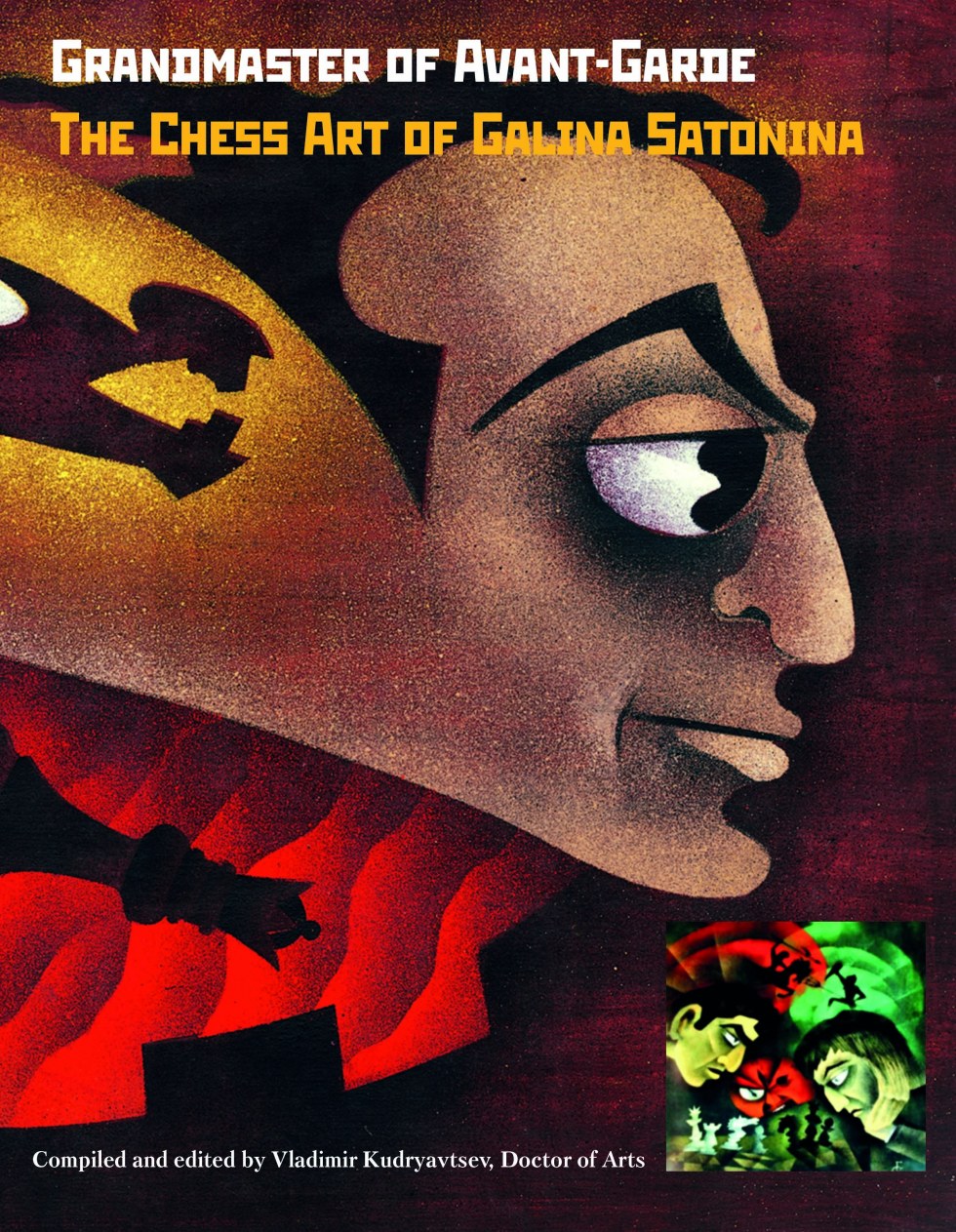
Sally Landau
Sally Landau, born in 1938, Vitebsk, Soviet Union, was Mikhail Tal’s first wife, a highly talented actress and singer. Sally and Misha were married from 1959 to 1970 in a period that encompassed Tal’s two world championship matches with Botvinnik as well as many of his greatest tournament performances. Sally lived in Antwerp, Belgium, from 1981 until her death in 2023.
Checkmate! The Love Story of Mikhail Tal and Sally Landau (2019) - in paperback and Amazon Kindle
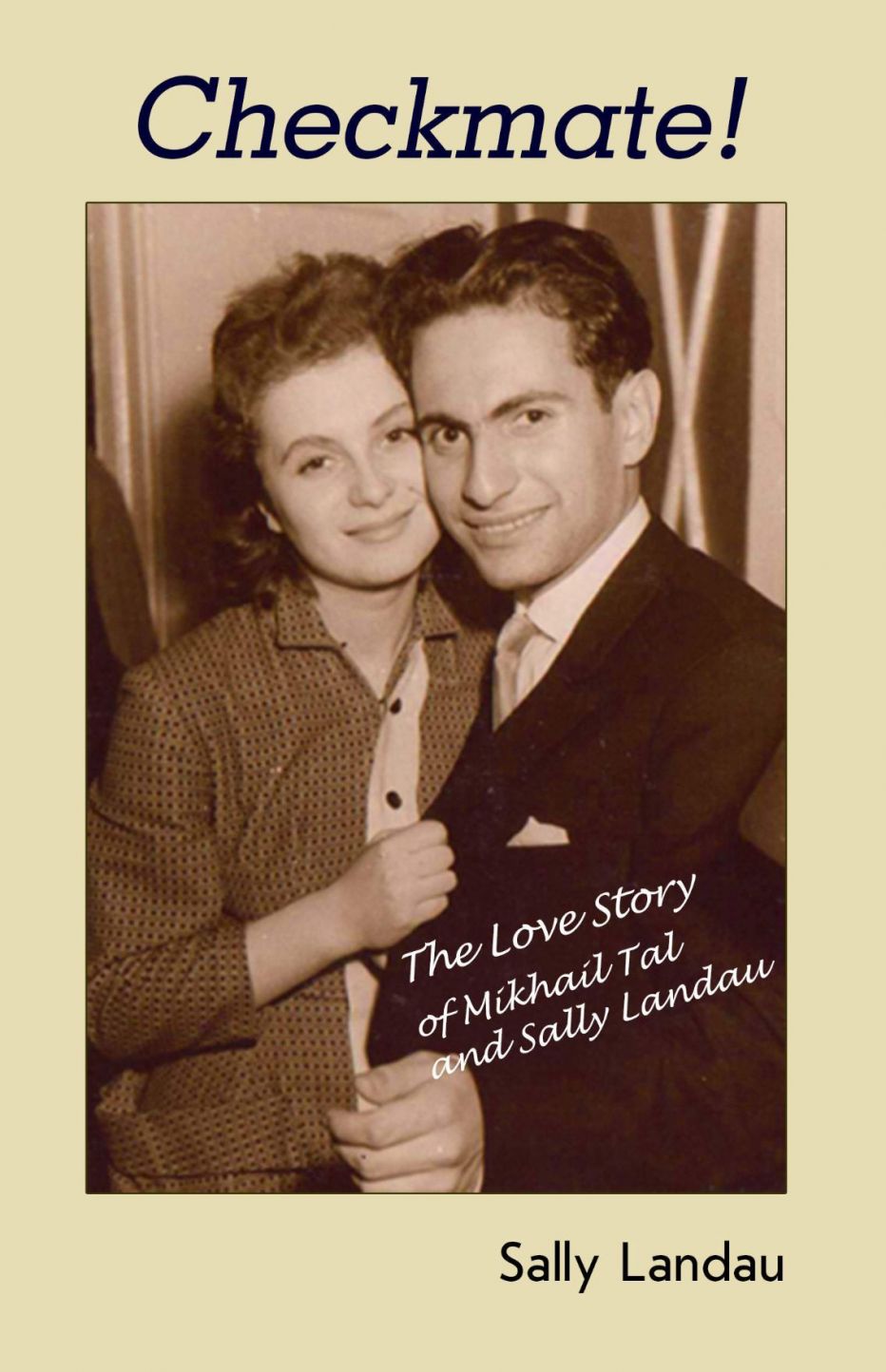
*** SHORT-LISTED FOR THE ENGLISH CHESS FEDERATION BOOK OF THE YEAR AWARD 2019 ***
Sally’s breathtaking story, first published in Russia in 1998 and which has been reprinted multiple times, is a memoir of her time with Tal, with whom she remained friends long after they divorced right up until his death in 1992. Full of detail about Tal and their life together, it is a tale of triumph and tragedy, love, parenthood, sorrow, jealousy, betrayal and revenge. Colored by a historical and social background including the Second World War, the Soviet chess scene, Rigan high society, the shadow economy in the Soviet Union, and Jewish emigration, it contains a fascinating portrait of Misha’s mysterious family and is illustrated with photos from Sally’s private archive. And it all just happens to be true…
Dorian Rogozenco
Dorian Rogozenco is a German-Romanian Grandmaster originally from Chisinau, Moldova, born in 1973. He graduated from the Sports Faculty of the State Pedagogical University in Chisinau in 1994 and gained the Grandmaster title in 1996. He was coached by Vyacheslav Chebanenko.
Dorian has played in four Chess Olympiads. He was Moldovan Champion in 1994 and a winner of the following major tournaments as well as many others: Moscow GM 1992, Lvov 1995 (co-winner), Chemnitz 1997, Bucharest GM 1998, and International Hamburg Championship 2004. He has winner's medals from the national team championships of the Czech Republic (2019) and Romania (2008, 2014, 2015, 2017 and 2020). Dorian achieved a career-high Elo rating of 2577 in 1999. He qualified for the FIDE World Championship knockout stage in 2001 in Moscow and was a member of Ruslan Ponomariov's coaching team preparing for the planned world championship reunification cycle in 2003. He became a FIDE Trainer in 2011 and a FIDE Senior Trainer in 2019. He was national trainer of Germany in 2014-2020.
Dorian is the author of two books: Anti-Sicilians - a Guide for Black in 2003 and The Sveshnikov Reloaded in 2005, as well as the author or co-author of many chess DVDs. He was also Chief Editor of the Romanian chess magazine Gambit in 2003-2013.
Dorian has lived in Hamburg, Germany, since 2007.
Eight Good Men: The 2020-2021 Candidates Tournament (2021) - in paperback, hardback, Amazon Kindle and Forward Chess
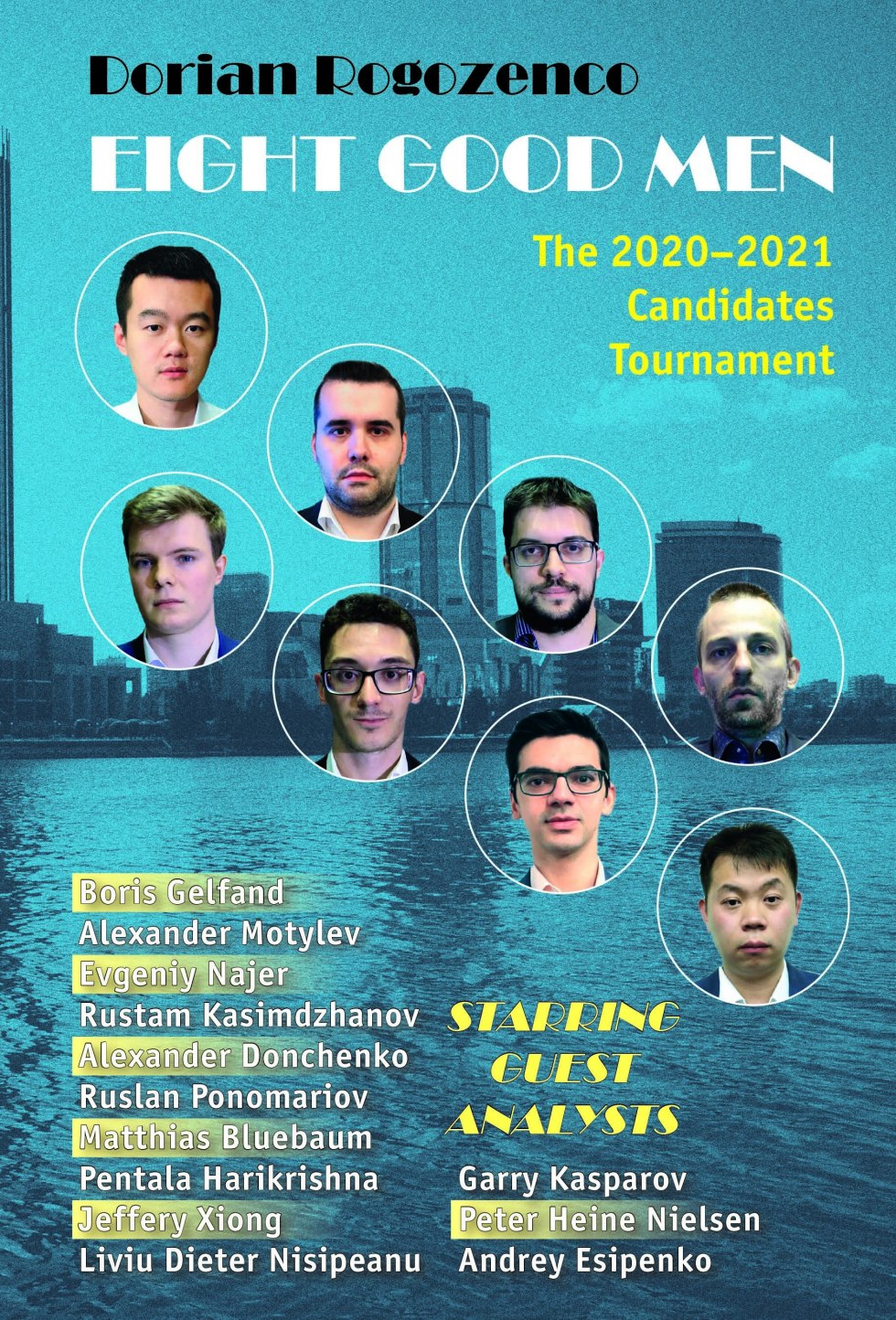
*****Short-listed for the FIDE Book of the Year prize 2022*****
The 2020-2021 FIDE Candidates Tournament held in Ekaterinburg, starring super-grandmasters Ian Nepomniachtchi, Maxime Vachier-Lagrave, Anish Giri, Fabiano Caruana, Ding Liren, Alexander Grischuk, Kirill Alekseenko and Wang Hao, delivered an awesome display of fighting chess. Grandmaster and FIDE Senior Trainer Dorian Rogozenco, coach of the German national team from 2014-2020, provides a comprehensive move by move analysis of all 56 games together with an assembled Dream Team of 13 super-class GM guest commentators including Garry Kasparov and Boris Gelfand. The commentary covers opening strategy and novelties, middlegame battles and instructive endgames, psychology and practical observations, together comprising a swathe of learning material valuable to players from club level to titled masters. The book is illustrated with a selection of official FIDE photographer Lennart Ootes’s best shots from both halves of the event.
Sergei Grodzensky
Sergei Grodzensky, born in 1944 in the Gulag city of Vorkuta, gained the Soviet Master of Sport title for over-the-board chess in 1985, and the international grandmaster title for correspondence chess in 1999. He twice won the All-Russian Problem and Studies Solving Olympiad (1963 and 1964) and has also won composition competitions. Grodzensky has represented Russia in world and European championships at correspondence chess. He is the author of over 600 articles covering the history and theory of chess, as well as 17 books. Outside chess, he made a career as a professor of engineering, gaining a doctorate in 2002.
The Lubyanka Gambit (2022) - in paperback, hardback, Amazon Kindle and Forward Chess
First published in Russian in 2004 and now available in English for the first time, The Lubyanka Gambit is a classic work investigating the darkest side of chess history in the Soviet Union. It is the culmination of nearly two decades of research by Correspondence Chess Grandmaster, historian and human rights campaigner Sergei Grodzensky, whose own father was sent to the Gulag in Stalin’s times. It describes the careers and life stories, based on archival documents and witness testimony, of Soviet chess composers, players and famous amateurs who were repressed by the Soviet authorities, ending up either executed or sent to the Gulag. Featured names include Lazar Zalkind, Arvid Kubbel, Vladimirs Petrovs, Petr Izmailov, Georgy Schneideman, Nikolai Krylenko and Natan Sharansky, among many others. The theoretical contribution to the history of composition is one key theme in this work.
The Lubyanka Gambit also looks in detail at the historical context of the purges of chess players and describes how chess was played by prisoners in the Gulags and internal exile. Perhaps the icing on the cake is provided by Grodzensky’s personal memories of the Soviet Union’s foremost Gulag writers Alexander Solzhenitsyn (his schoolteacher) and Varlam Shalamov (his father’s close friend). This book contains 72 full games and fragments analyzed by the participants, contemporaries, the author and other leading players, as well as 145 computer-checked compositions.
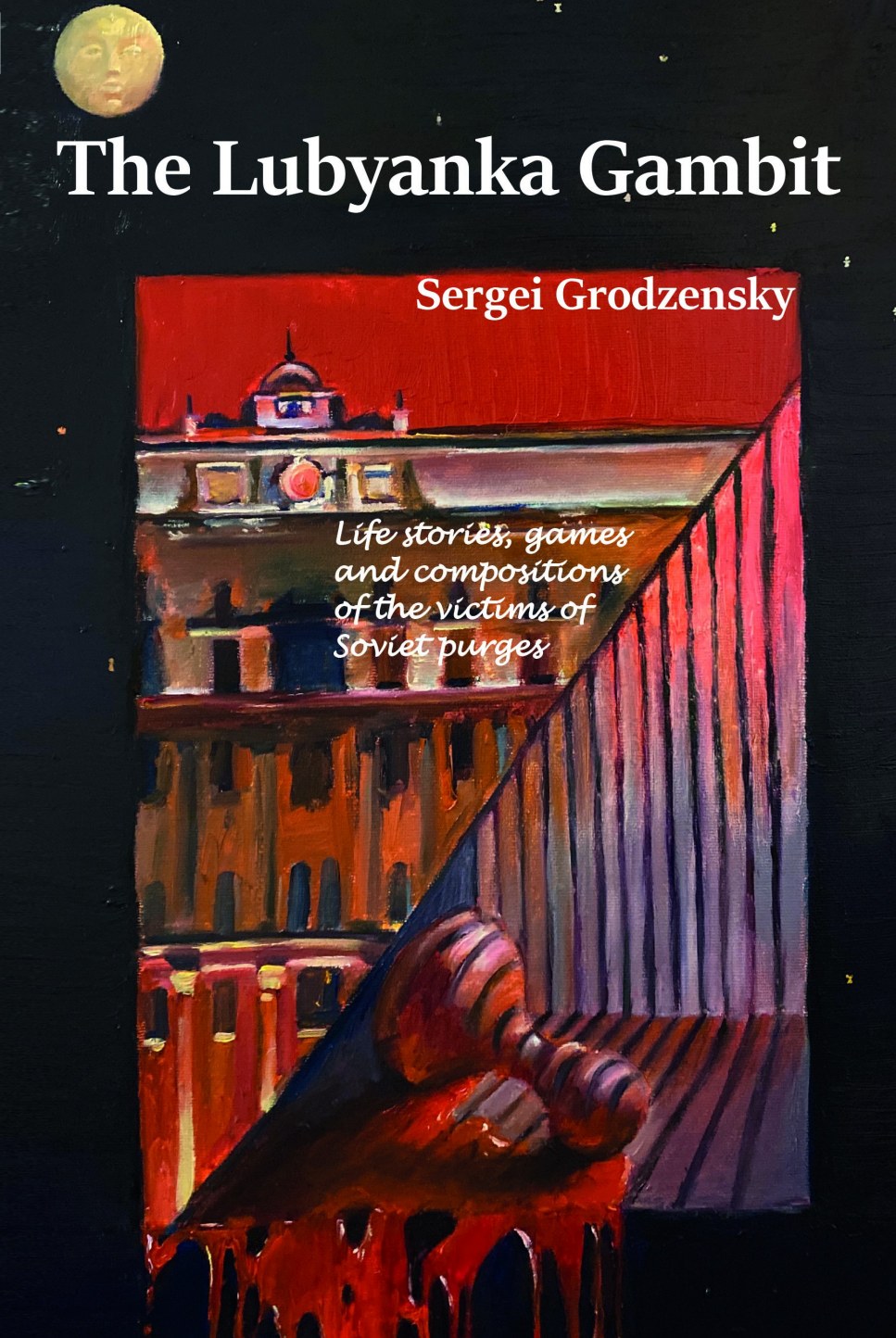
Dmitry Kryakvin
Galina Petrova-Matisa
Dmitry Kryakvin (born in 1984) is a grandmaster (2009), journalist, chess historian and coach. His pupils have included many grandmasters, of which the strongest is Andrei Esipenko. Dmitry has written a number of chess books on a wide variety of subjects.
Galina Petrova-Matisa (1914 – 2000) was a Latvian human rights activist and the wife of Vladimirs Petrovs. She was the head of the Latvian chapter of the Memorial Society.
Hero of the Pre-War Olympiads: Grandmaster Vladimirs Petrovs (2022) - in paperback, hardback, Amazon Kindle and Forward Chess
Our short life together was fun, fascinating and happy. I accompanied my husband to chess tournaments. We traveled a lot, saw a lot, met the most interesting people. Meeting Alekhine, Euwe, Flohr, Capablanca, Keres was unforgettable. We became friends with many of them. Now, when I turn the pages of my life and remember my family, which was obliterated so ruthlessly, the old wounds open again and start bleeding.
This book tells the story of one of the most enigmatic and tragic figures in chess history – the Latvian grandmaster Vladimirs Petrovs (1908 – 1943). His name was struck out of chess literature for decades. His games and biography are largely unknown to the public – even though Petrovs defeated Alekhine, Fine, Reshevsky, Boleslavsky and many other great players of the past, gained prizes at supertournaments including joint first at the famous Kemeri 1937 tournament, and performed strongly for Latvia at chess Olympiads. According to the Chessmetrics website, Petrovs was ranked no. 14 in the world in November 1938, and his performance at Kemeri 1937 was 2709. He had a 2.5-2.5 lifetime score against Alekhine.
In the first part of this book, grandmaster and chess historian Dmitry Kryakvin instructively analyzes Petrovs’ career through 52 games and fragments. As well as the above players, opponents include Smyslov, Euwe, Bogoljubov, Keres, Stahlberg, Flohr, Spielmann, and many other global stars of pre-war chess. In the second part, Petrovs’ widow Galina Petrova-Matisa recounts the tragic fate of her husband and family members and her search for the truth of what happened to Petrovs. She further provides biographical details of their short, blissful family life for four-and-a-half years, including unforgettable meetings with the world’s strongest chess players and their families. The work contains a large number of rare family and tournament photos.
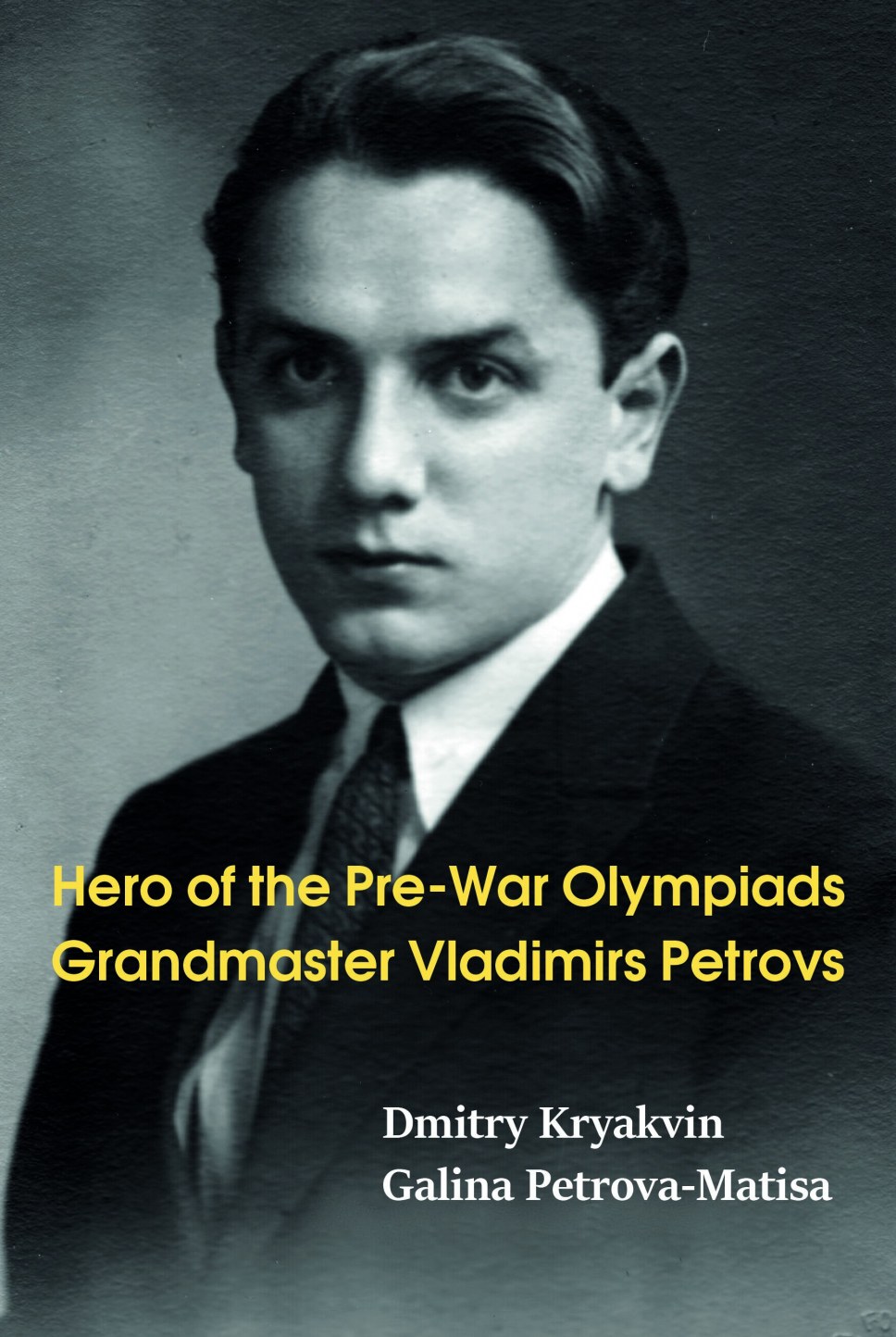
Grandmaster of Avant-Garde: The Chess Art of Galina Satonina (2023) - in paperback, hardback and Amazon Kindle
Galina Satonina (1905–2000) was the leading chess painter of the Soviet era. A multiple-time Kazan and Tatarstan ladies chess champion, she saw life as a game of chess, and her paintings speak the language of Caissa. She painted world champions and other famous players, ranging from early stars Philidor, Morphy and Anderssen, all the way through to Fischer, Karpov and Kasparov. Several of her paintings depict the chess pieces themselves and emotions felt during play, as well as different aspects of the game such as time-trouble and checkmate.
Satonina’s works were exhibited at Soviet-era world championship matches. They were widely written about in the Soviet and international chess press, including Shakhmaty v SSSR, 64 and Ceskoslovensky Sach.
This full-color coffee-table book, based on original paintings from museum and private collections, was compiled by Dr. Vladimir Kudryavtsev, who has published many tomes on national and regional visual art of the Soviet and pre-Soviet periods. It additionally contains other works from Satonina’s career as well as her unique life story.
YouTube review by Grandmaster Danny Gormally

Magnus Carlsen begins to read Checkmate! The Love Story of Mikhail Tal and Sally Landau, Lindores Abbey (Scotland), May 2019. Photo by ChessBase India.
ChessBase India interview of Magnus Carlsen in which he discusses reading Checkmate! The Love Story of Mikhail Tal and Sally Landau
Maxim Chetverik
Maxim Chetverik, born in Voronezh in 1963, is one of Russia's biggest chess writers and opening experts. He has written books published in Russian, English, French and German on chess strategy, the Bogo-Indian Defense, Queen's Indian Defense, Catalan Opening, English Opening, Benoni System, Queen's Gambit Accepted, Sicilian Defense, Petroff Defense, Dutch Defense, Alekhine Defense and Albin Counter Gambit, as well as more general opening books and books on the games of Alekhine, Tal and Spassky.
He became an International Master in 2003 and is a regular tournament player to this day, as well as being a coach in his native Voronezh. His best tournament results include Budapest Open, 1st place, 1996, Open championship of Slovan Club, Bratislava, 1st place, 1998, Prague Open, 2nd equal, 2002, Kecskemet (Hungary) round robin tournament, 1st place, 2003, Stuttgart Open, 2nd place, 2009, Yaroslavl Open, 3rd place, 2015, Olomouc (Czech Republic), 2nd place, 2017, and Heraklion (Greece), 2nd place, 2019.
The Complete Bogo-Indian Defense (2020) - in paperback, Amazon Kindle and Forward Chess
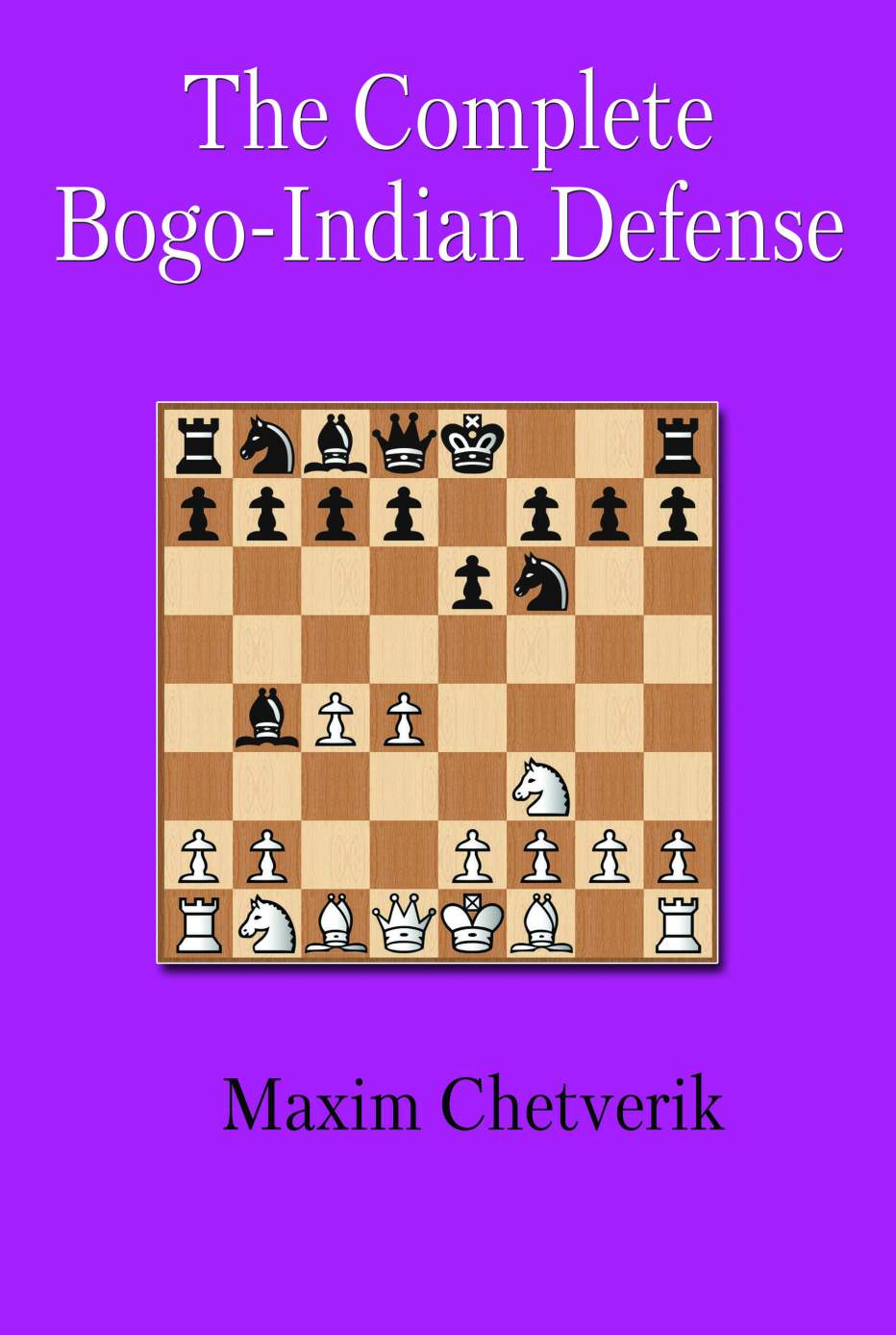
International Master Maxim Chetverik’s book covers the Bogo-Indian Defense which is normally arrived at after the moves 1.d4 Nf6 2.c4 e6 3.Nf3 Bb4+. This book additionally covers Catalan-Bogo hybrids, in particular, the Bogo response to the Catalan Opening with 1.d4 Nf6 2.c4 e6 3.g3 Bb4+. Maxim is a big expert in this opening, having played it in 76 official games as of the publication date, and one of his full games as well as several fragments from his play are included in this volume.
While this solid opening remains part of the repertoire of top-level players, it is also interesting for club players to study and adopt. Its strategic ideas are easier to absorb than those of the Queen’s Indian Defense, and black will not be required to learn as much theory as in the QID. Sharp variations are rare, and tactics play very much a subordinate role to strategy. The key focus is pawn structures, with most pawns remaining on the board in generally closed positions. Yet black retains the ability to vary the pawn and piece setup to suit his taste.
114 deeply annotated games are grouped into 20 chapters with Maxim’s carefully considered recommendations. Many of the featured games and fragments are played by world champions and supergrandmasters, including Carlsen, Kasparov, Alekhine, Anand, Kramnik, Smyslov, Korchnoi, Caruana, Short, Gelfand, Topalov, Shankland, Nakamura, Judit Polgar, Ivanchuk, Yusupov, Ding Liren, Giri, Aronian, Svidler, Hou Yifan, Timman, and many others. Many of the games are drawn from the very recent past and are not covered in previous books on the Bogo-Indian. Indeed, a large number of games from 2018-2019 are included, hence this work, which is full of Maxim’s original analysis, covers the latest theory as of the publication date.
This book is essential reading for both black and white in the Bogo-Indian Defense.
Strategic Plans: 75 Modern Battles (2019) - in paperback, Amazon Kindle and Forward Chess
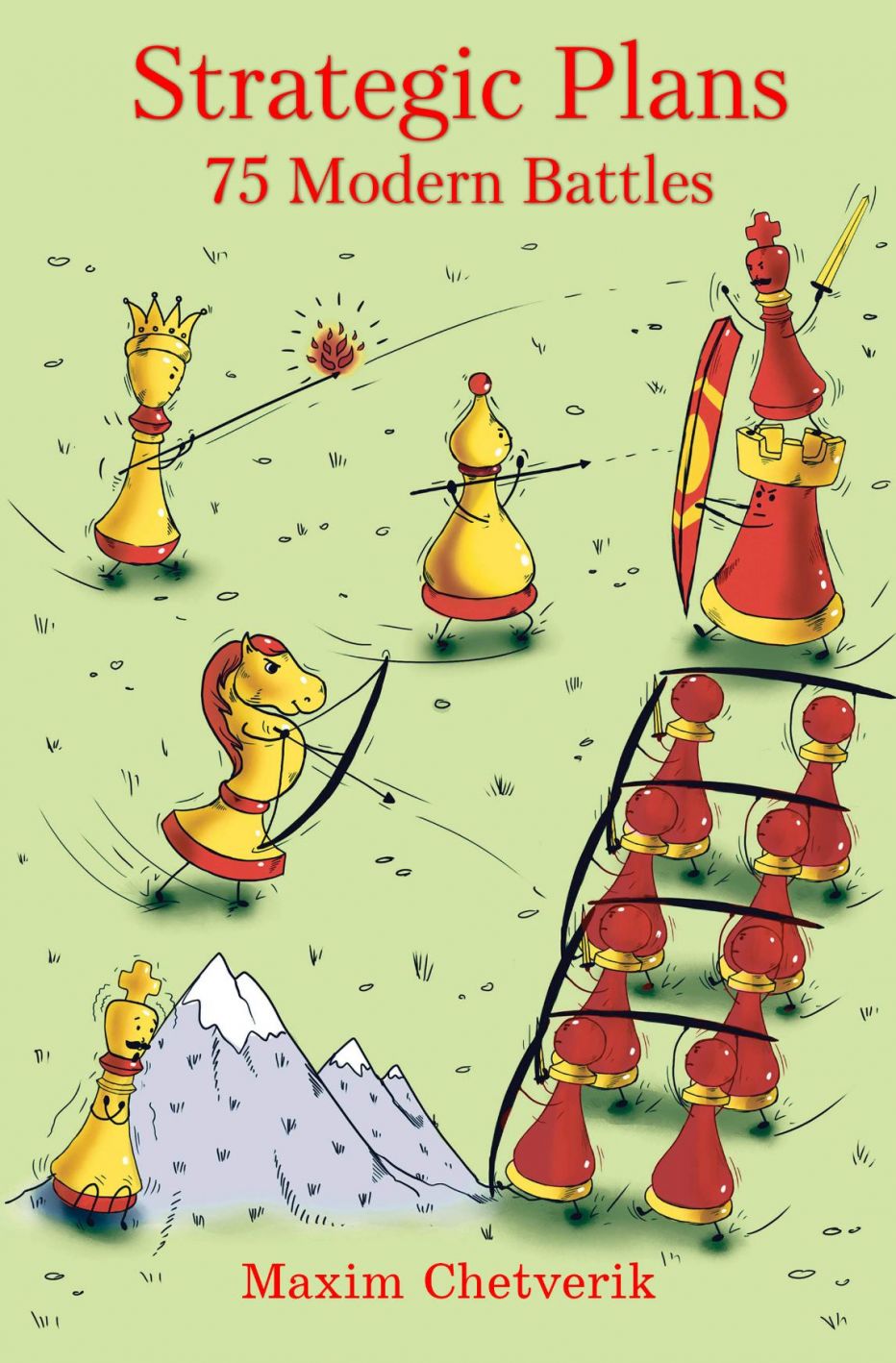
Russian International Master Maxim Chetverik has written a strategy textbook containing 75 deeply annotated positional games that show players how to devise plans to handle a number of key strategic themes, such as when to open up the game, how to activate the pawn chain, how to carry out positional sacrifices and many others. Unlike most other textbooks, the strategic plans are viewed as battles where the plans of each player clash, and Maxim analyzes why one plan comes out on top.
Also unlike most other textbooks, all example games are drawn from grandmaster play in the 21st century, some played in 2018, and consider the plans right out of the opening stage. This makes the book of particular value to players wishing to better understand the strategies that the openings they play may lead to, bearing in mind the author is an openings expert with ten openings books published. The majority of games are played by elite grandmasters, including Carlsen, Caruana, Anand, Kramnik, Karjakin, Giri, So, Vachier-Lagrave, Aronian, Mamedyarov, Nakamura, Gelfand, Svidler, Ivanchuk, Shirov, Leko, J. Polgar, Topalov, Kamsky, Morozevich, Korchnoi and Spassky.
Chetverik introduces and illustrates the concepts of macroplan and microplan, which provide a simple structural framework for players seeking to devise plans in their own games. The macroplan is the specific way to achieve the required result (usually, a win), for example, the successful exploitation of a queenside pawn majority. The microplan is a way of solving a local problem that involves several moves, such as transferring a knight from a bad square to a good one. Ideally, a macroplan is a chain of sequential and carefully calculated microplans.
This book is largely aimed at strong club players wishing to improve, or their coaches. The recommended Elo range is approximately 1,800 – 2,200, although it may of course be of interest to players a bit lower and a bit higher than this range.
The Queen's Indian Defense Main Line 4.g3 System (2018) - in paperback, Amazon Kindle and Forward Chess
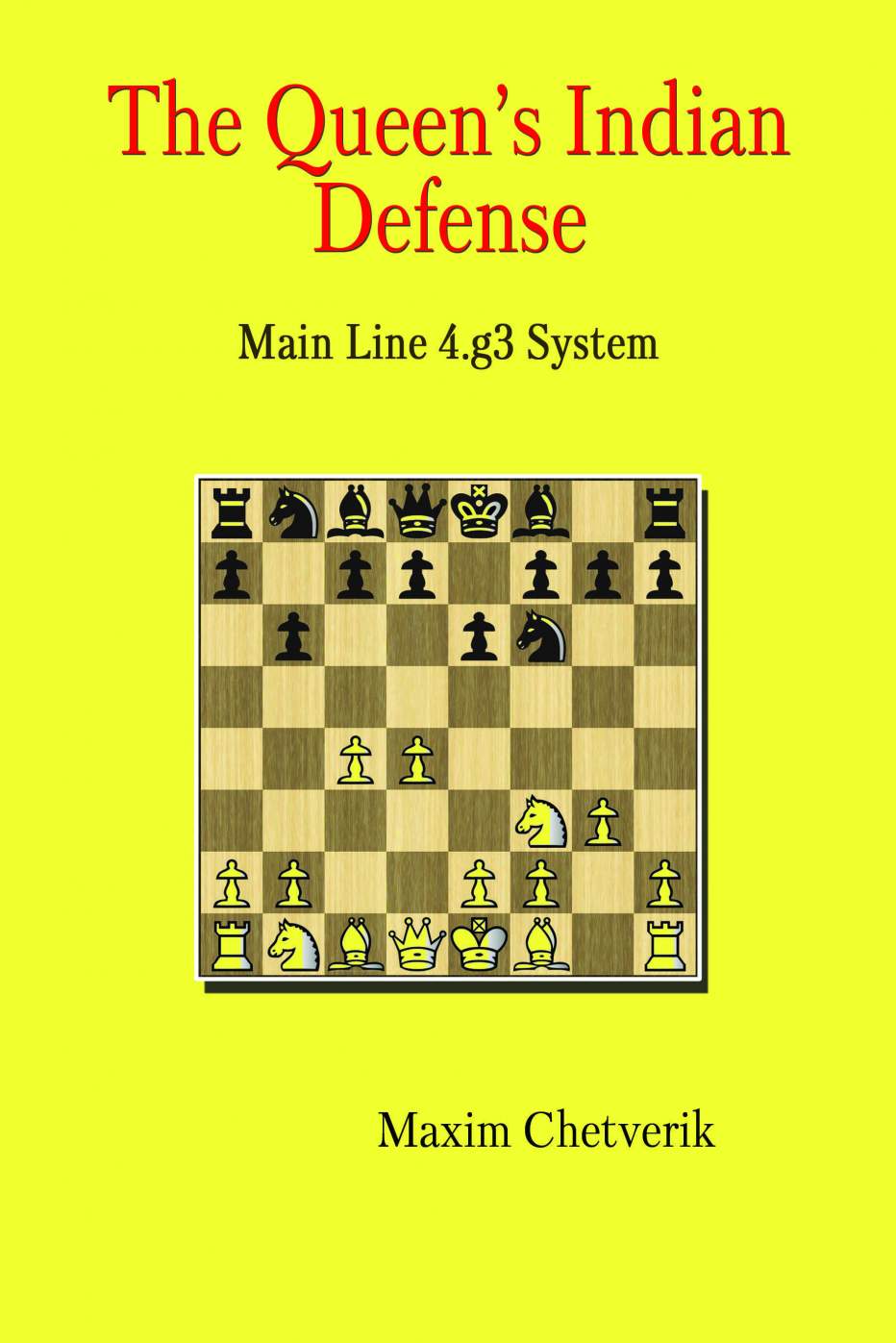
International Master Maxim Chetverik has written an in-depth study of one of the most popular choices by white in the Queen's Indian Defense - the main line with 4.g3, where white fianchettoes his bishop. This line is often seen at top-level chess.
A key focus of this work is an examination of new lines that have recently appeared in the arsenal of grandmasters. The full range of continuations for both white and black are covered in this textbook, including hybrids with the Bogo-Indian Defense and certain Catalan, Dutch, Benoni and Hedgehog-type set-ups, as well as key themes such as hanging pawns, the isolated queen's pawn, white's four versus three ranks advantage, the closed center with the pawn structure being c4-d5-e4 against c5(c7)-d6-e5 and structures with semi-open files, making it an essential and comprehensive guide for players on both sides of the board in this variation.
Maxim makes this book particularly user-friendly by his focus on learning the key ideas through practical games, as well as his use of "land-mines," transposition alerts and key tips.
This book contains 181 full games in this line and several hundred fragments with detailed and original commentary by the author focused throughout on giving a balanced evaluation in what are complicated positions. Many of these games feature the world's greatest players, including world champions Carlsen, Anand, Kramnik, Kasparov, Karpov, Spassky, Petrosian, Tal, Smyslov, Botvinnik and Alekhine, and other top players including Caruana, Shankland, Nakamura, So, Mamedyarov, Aronian, Grischuk, Ivanchuk, Karjakin, Harikrishna, Adams, Shirov, Gelfand, Topalov, Korchnoi and Timman.
Maxim himself has played over 100 official games in this line, making him a leading expert in the Queen's Indian Defense in general and the 4.g3 line in particular. Four of his games are in included in full in this volume, as well as a number of fragments.
Alexander Galkin
Alexander Galkin was born in 1979 in Rostov-on-Don, Russia. International grandmaster (1997). Russian junior champion in his age-groups (1989 and 1993). Russian under 20 champion (1999). Second in the Soviet junior championship in his age-group (1991). Second in the European junior championship in his age-group (1991). Member of the winning Russian team in the world junior olympiad (1994). World under 20 champion (1999). Member of the winning Khimik team in the Russian team championship (1999). Prize-winner in other Russian team championships for various teams (1996, 1998, 2003, 2008). Participant in two FIDE world championships (2000 and 2004) and the FIDE world cup (2007). Member of the Russian team in the European team championship (1999). Outright winner or prize winner in a number of international tournaments.
His pupils include outright winners or prize winners in Russian, European and world championships among juniors and junior girls across the age-groups. He was named Children’s Trainer of the Year in 2016 by the Russian Chess Federation. Possesses three university degrees.
101 Endgame Crimes and Punishments (2020) - in paperback, Amazon Kindle and Forward Chess
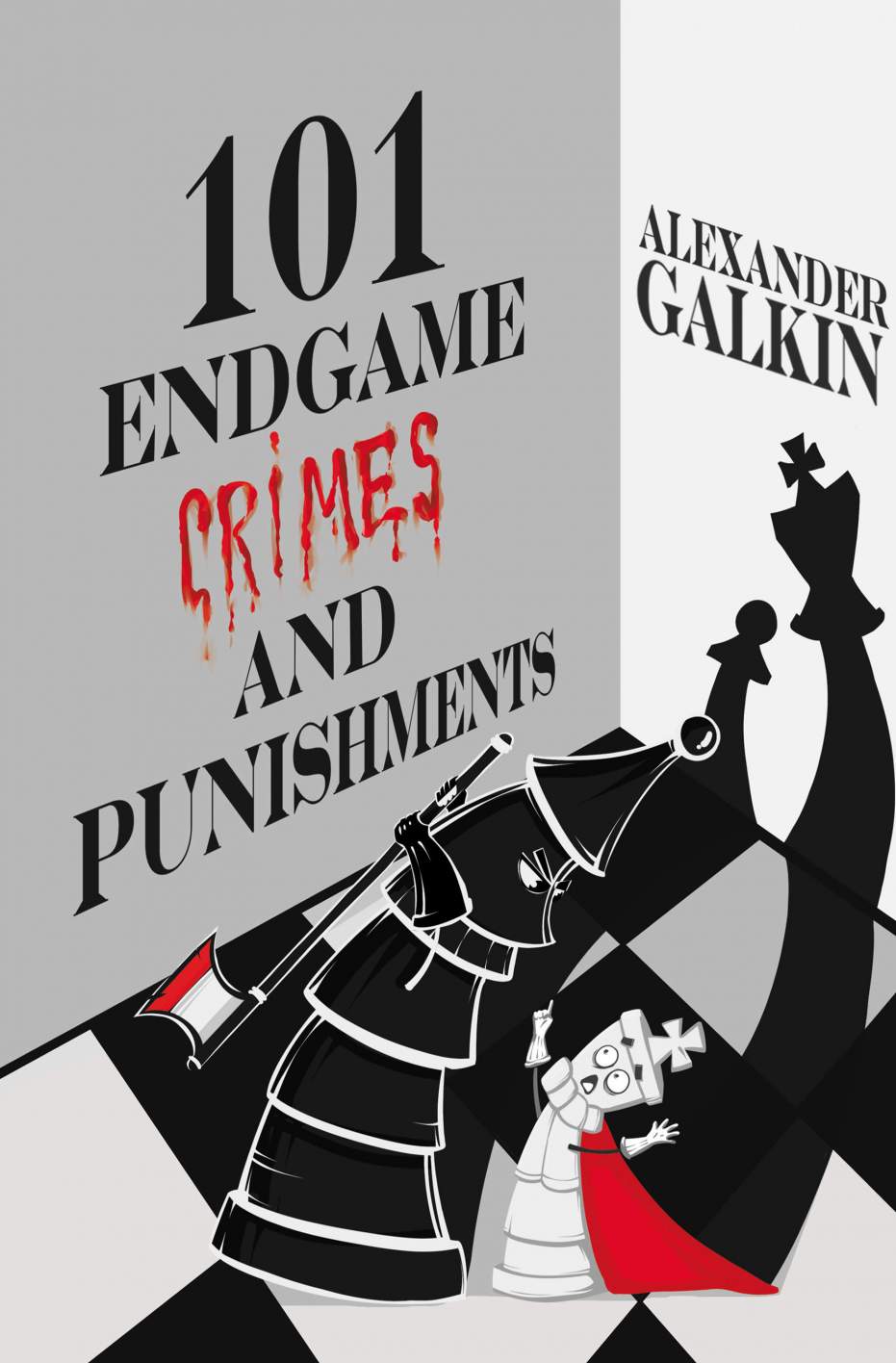
This endgame tactics textbook by Grandmaster Alexander Galkin, who was named Children’s Trainer of the Year in 2016 by the Russian Chess Federation, provides a large volume of practical knowledge. The vast majority of chess combination textbooks contain a selection of positions and exercises where the student is asked to find a tactic or carry out an attack against the enemy king. That way, they learn to develop their combinational vision and ability to attack. However, there is not much focus on the mistake by one of the players that led to the critical position where the combination or decisive attack became possible.
In this book, aimed at strong tournament players (1900-2300 Elo or fast improving juniors) the author introduces a wider approach to developing endgame tactics skills that a formidable chess player needs. Specifically, he presents 101 positions from games of grandmasters played in 2019, including super-GMs such as Magnus Carlsen, Ding Liren, Alireza Firouzja, Maxime Vachier-Lagrave, Alexander Grischuk, Wang Hao, Alexei Shirov, Samuel Shankland, Kirill Alekseenko, and Levon Aronian, in which he first explains the mistake made by one of the players in underestimating their opponent’s counterplay, then he analyzes how the game progressed where punishment for the mistake is meted out. After that, he returns to the starting position to demonstrate the correct or a more promising continuation. Therefore, the text is structured so that each challenge contains the starting diagram twice – before the moves in the actual game, and then, on the page overleaf, before the solution.
Studying these key fragments from grandmaster games will help a player to develop their endgame approach. Firstly, the student analyzes why a move or series of moves by one of the players was erroneous. What counterplay by the opponent did the player making the mistake underestimate? Secondly, armed with this answer, the student can review the position to try and figure out the better move. If the student is working with a coach, then the coach should first set up the position on the board, demonstrate the erroneous move played, and ask the student to find the refutation to that bad move. After the refutation is found by the student, the coach should once again set up the critical position and ask the student to find the strongest continuation for the initial player. This may be one or more moves, depending on the position. Naturally, in the case of self-study the student can change their approach, either trying to figure out the refutation to the error by covering up the subsequent text, or simply studying the moves in the game before trying to find the better continuation, which is detailed overleaf together with the starting diagram.
101 Endgame Masterclasses: Rooks and Material Imbalances (2022) - in paperback, Amazon Kindle and Forward Chess
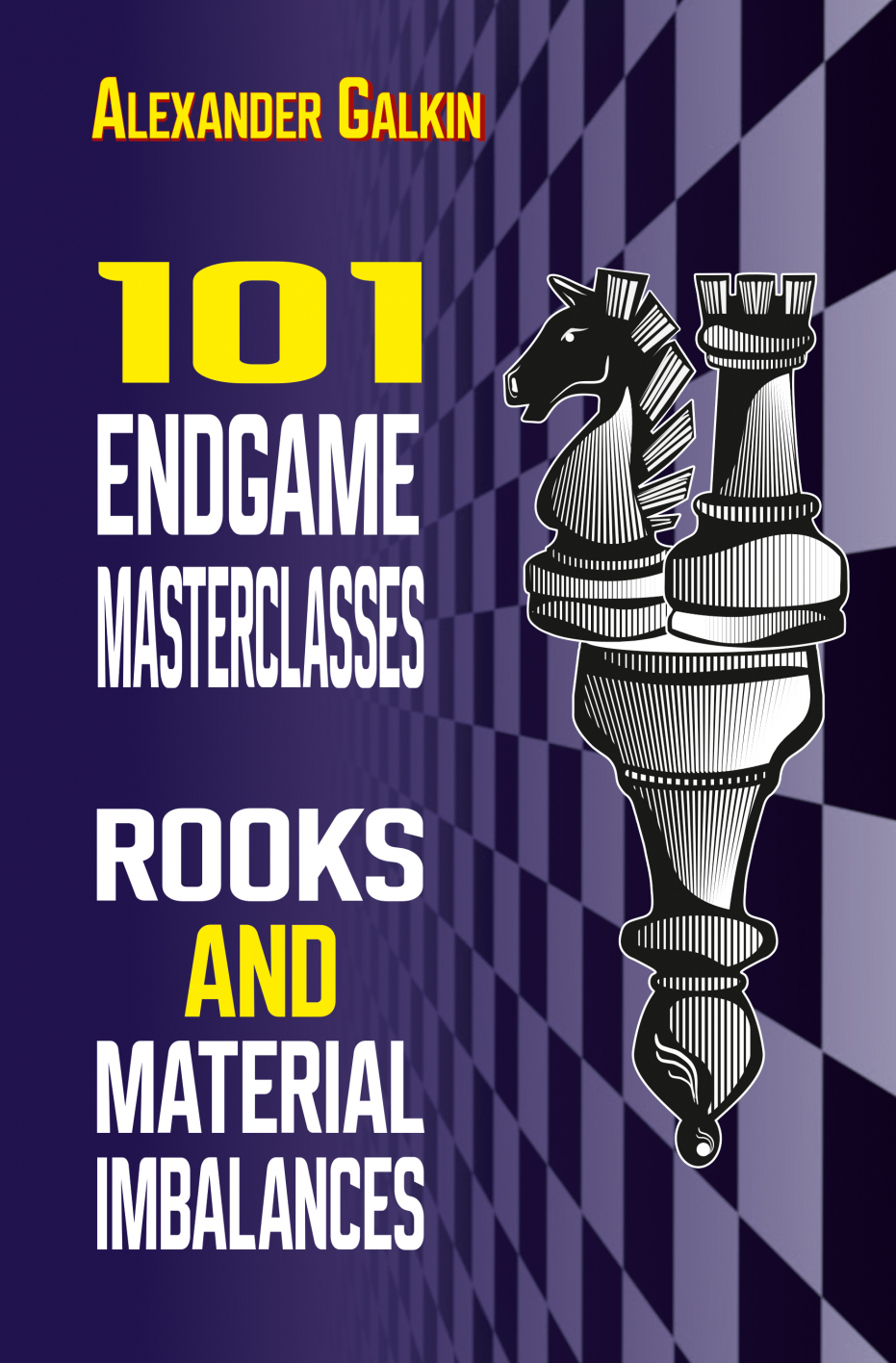
This book aims to give you a wealth of self-study knowledge about handling different types of endings that occur frequently but on which there is not much literature analyzing recent games. Imbalanced material endgames involving rooks are a key focus of the book, covering three-fifths of the material, and all endings in the book feature at least one rook. The vast majority of games are taken from the last few years, including many from 2021-2022. Like the author's previous endgame book published with Elk and Ruby, 101 Endgame Crimes and Punishments (2020), this one is aimed at strong tournament players (1900-2300 Elo) and fast improving juniors.
Specifically, this book covers the following endings: rook vs. minor piece (chapter 1), rook vs. a pair of minor pieces (chapter 2), rook and minor piece vs. rook and minor piece, rook and minor piece vs. rook, rook and minor piece vs. two minor pieces, rook and minor piece vs. a pair of rooks, and rook and minor piece vs. queen (all in chapter 3).
The material arrangement principles applied for this book are largely consistent with those adopted for the author's books published earlier. He has selected examples only from games played over the board and in which at least one of the players is a grandmaster. Six of the included games were played by world champion Magnus Carlsen. Other examples come from games by top players such as former world champions Garry Kasparov, Vladimir Kramnik and Vishy Anand, as well as Ian Nepomniachtchi, Ding Liren, Hikaru Nakamura, Sam Shankland, Jan-Krzysztof Duda, Judit Polgar, Gata Kamsky, Daniil Dubov and others. Eight of the 101 examples in this book come from the author's own games.
Endgame positions have been selected so that a person studying the book can see the critical moments of play, such as a single or a series of errors that led to a loss or when one of the sides missed a winning move. Before playing through the correct continuation the reader is advised to try and work it out from the initial diagram.
Anastasia Travkina
Anastasia Travkina was born in 1992 in Rostov-on-Don, Russia. Woman International Master (2018) with a career high rating of 2304. Winning team member in Russian women’s blitz team championship (2016). European universities women’s blitz champion (2016). Winning team member in Russian students women’s team championship (2017). Prize winner in many international tournaments. She has coached children since 2008.
111 Middlegame Crimes and Punishments (2020) - in paperback, Amazon Kindle and Forward Chess
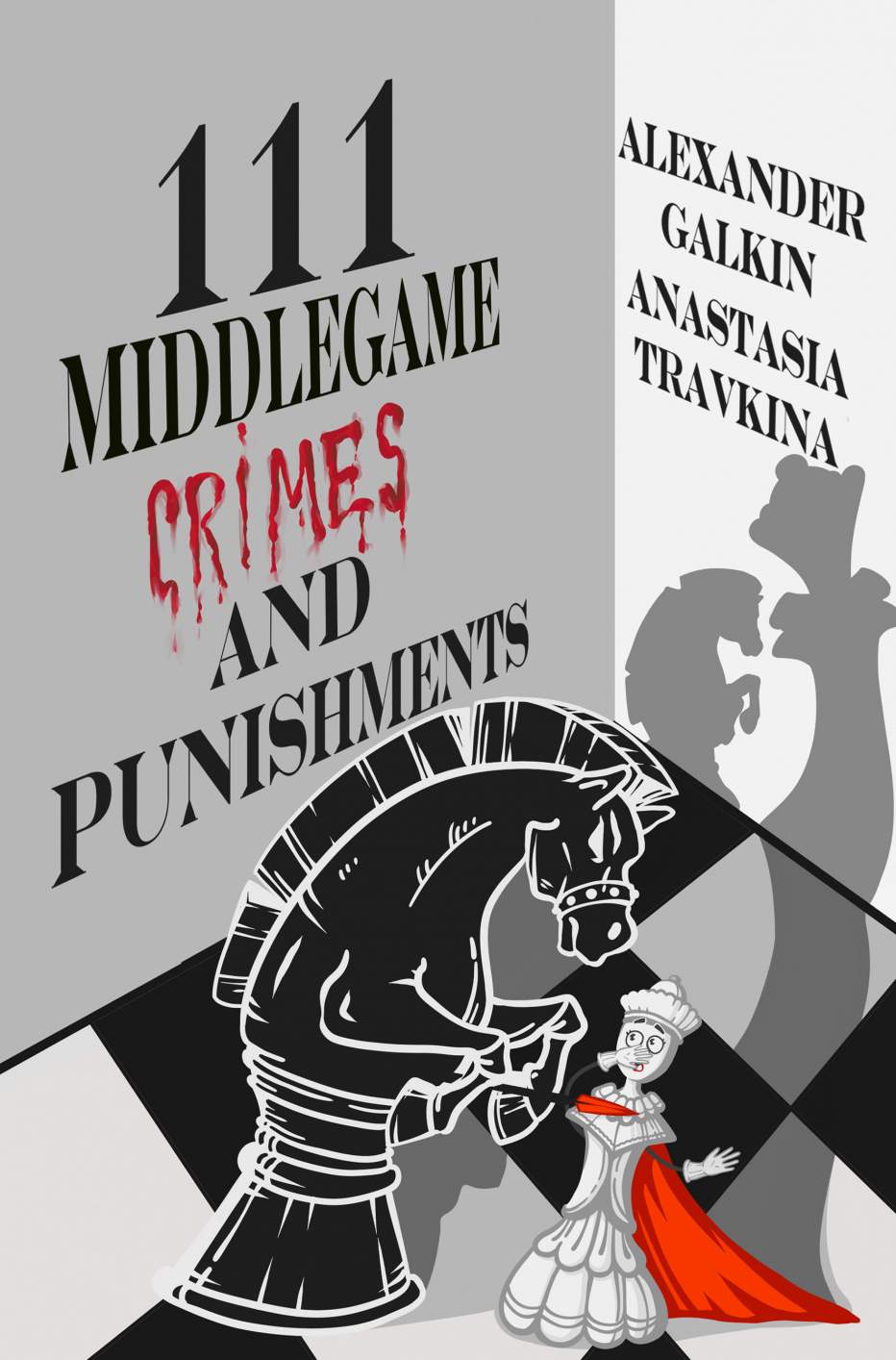
Most chess games end in the middlegame. Therefore, to achieve good results, you have to play well at this stage of the game. This middlegame textbook by Grandmaster Alexander Galkin, who was named Children’s Trainer of the Year in 2016 by the Russian Chess Federation, and Woman International Master Anastasia Travkina, provides a large volume of practical knowledge. The vast majority of middlegame tactics and positional textbooks contain a selection of positions and exercises where the student is asked to find a tactic, carry out an attack against the enemy king or choose the right positional approach based on certain “rules”. However, there is not much focus on the mistake by one of the players that led to the critical position where the combination, decisive attack or positional improvement became possible.
In this book, aimed at strong tournament players (1900-2300 Elo or fast improving juniors) the authors introduce a wider approach to developing middlegame tactical and positional skills that a formidable chess player needs. Specifically, they present 111 positions from games of grandmasters played in 2019, including super-GMs such as Magnus Carlsen, Fabiano Caruana, Ding Liren, Anish Giri, Ian Nepomniachtchi, Daniil Dubov, Wesley So, Hikaru Nakamura, Levon Aronian, and Wang Hao, in which they first explain the mistake made by one of the players in underestimating their opponent’s counterplay, then they analyze how the game progressed where punishment for the mistake is meted out. After that, they return to the starting position to demonstrate the correct or a more promising continuation. Therefore, the text is structured so that each challenge contains the starting diagram twice – before the moves in the actual game, and then, on the page overleaf, before the solution.
There are numerous elements that a chess player should keep in mind in the middlegame and the authors have designed this book to address specific middle-game thematic mistakes: unsound sacrifices, creating imaginary threats, imaginary defense against threats, pawn-grabbing, give check or attack material – which is best?, wrong evaluation of changes to the pawn structure, lack of vigilance in decision-making, replacing strategy with tactics and taking wrong positional decisions.
Studying these key fragments from grandmaster games will help a player to develop their middlegame approach. Firstly, the student analyzes why a move or series of moves by one of the players was erroneous. What counterplay by the opponent did the player making the mistake underestimate? Secondly, armed with this answer, the student can review the position to try and figure out the better move. If the student is working with a coach, then the coach should first set up the position on the board, demonstrate the erroneous move played, and ask the student to find the refutation to that bad move. After the refutation is found by the student, the coach should once again set up the critical position and ask the student to find the strongest continuation for the initial player. This may be one or more moves, depending on the position. Naturally, in the case of self-study the student can change their approach, either trying to figure out the refutation to the error by covering up the subsequent text, or simply studying the moves in the game before trying to find the better continuation, which is detailed overleaf together with the starting diagram.
Obsession: A Chess Biography of Vsevolod Rauzer (2023) - in paperback, hardback, Amazon Kindle and Forward Chess
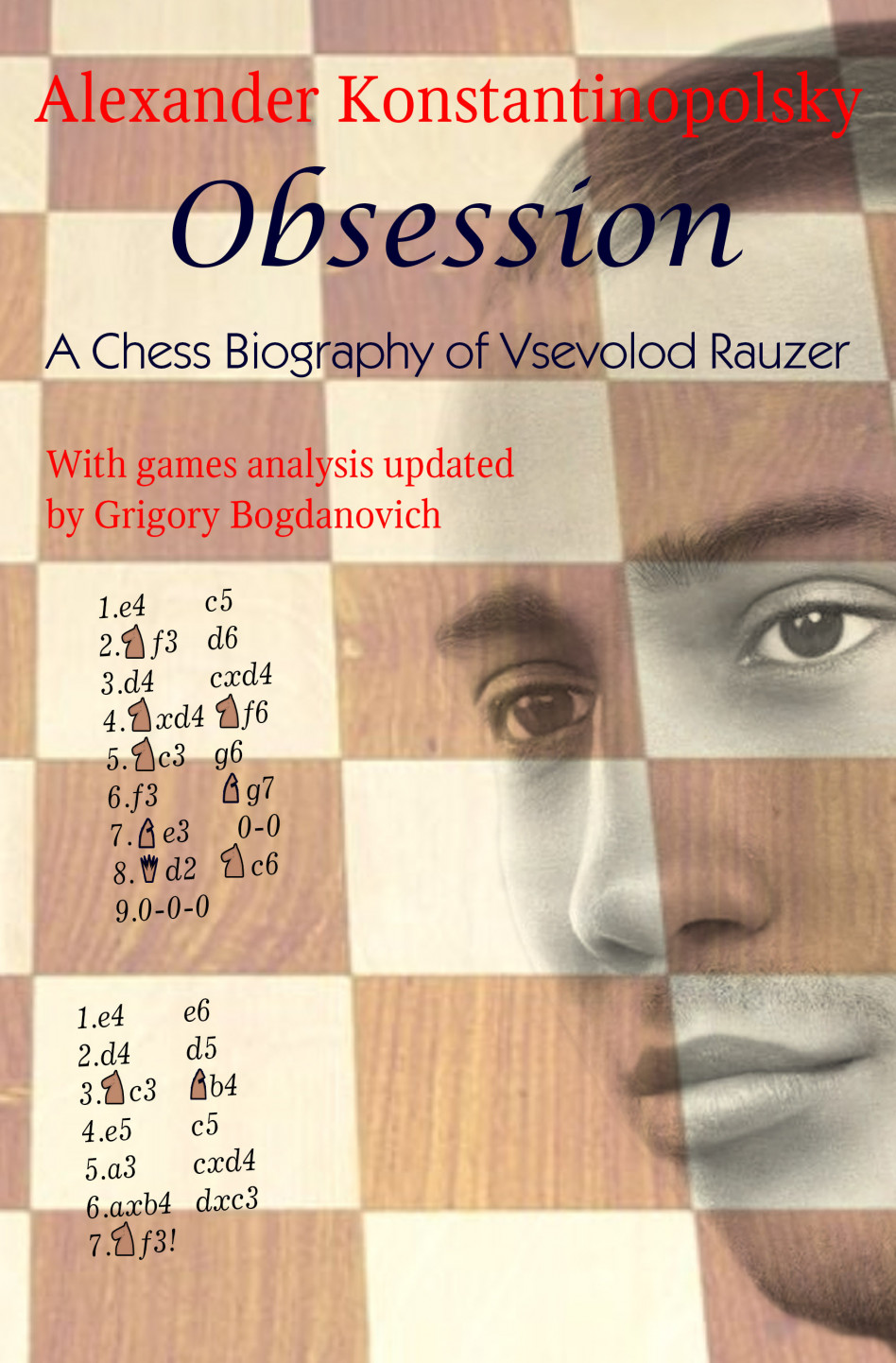
Vsevolod Rauzer, born in Kiev in 1908, was one of the world’s leading chess opening theoreticians and thinkers in the 1930s. As a player, he was an uncompromising attacker, trying to avoid draws as well as to prove that 1.e4 wins by force. According to Mikhail Botvinnik, “His opening research…with linked middlegame plans, gives us every reason to place V. Rauzer among the founders of the Soviet chess school.”
Awarded the Master of Sport title in 1929, Rauzer’s best tournament performances included joint eighth place in the 1931 Soviet Championship, sixth in 1933 and eighth in 1937. According to Chessmetrics, he was ranked in the world’s top 30 for several years.
He made big contributions to theory in the Sicilian, French and Caro-Kann defenses among others. The book’s introductory articles contain deep dives into Rauzer’s opening laboratory and shed light on the historical development of key variations.
The present work contains 96 games, nearly all of them played by Rauzer. Opponents include Botvinnik, Fine, Levenfish, Lilienthal, Romanovsky, the author and other leading pre-War Soviet players. Many games come with Rauzer’s own annotations together with analysis by Konstantinopolsky, Botvinnik, Levenfish and others. The commentary has been updated by International Master Grigory Bogdanovich using the latest engines.
Ultimately, Rauzer’s story was a sad one. Chess, and especially opening analysis, was an obsession for him: he once told Panov: “Unfortunately, I just can’t make myself work on theory of the game for more than 16 hours a day! My head can’t endure more.” This obsession eventually drove him mentally ill and he spent much of his final period in care. Vsevolod Rauzer lived largely in poverty and tragically died in the Siege of Leningrad.
Maria Manakova
A Zillion Chess and Life Hacks (2024) - in paperback, hardback, full-color hardback, Amazon Kindle and Forward Chess


How should a chess player, be they amateur or professional, achieve their full potential? What’s the best way to prepare psychologically for the game, opponents, tournaments? How can they set goals at the board and achieve them? What techniques can they employ to react when the game takes an unexpected turn? How should they plan to avoid time trouble, and then handle it (or their opponent’s) if it occurs? What about maintaining concentration and controlling emotions at the board? How to use psychology when choosing a move or trying to achieve a draw? What’s the best approach to facing much stronger opponents? What should a player do if one’s opponent breaks the rules? How to bounce back from losses?
Woman Grandmaster Maria Manakova has written a detailed psychological manual on how to navigate these and other key matters for both club players and those setting out on their professional journey. This book contains a huge number of practical and actionable tips, drawn from both Maria’s personal experience and that of her professional peers among players and coaches. It provides examples from 24 games, some taken from Maria’s career and others played by the greats of the game (among them Carlsen, Kramnik, and Anand). It also contains a generous selection of photos from Maria’s life, as well as her own magnificent drawings that illustrate her advice. This book is available in three editions – paperback, hardback and full-color hardback.
Here’s what Alexei Shirov had to say about the first edition of her book, published in 2023 in Russian: “While we ‘strong’ grandmasters narrow our perception of Earthly chess to one or two lines, Maria Manakova has embraced our entire galaxy in her work. This book will not leave any chess lover unmoved.”
Maria Manakova (born 1974) is a Serbian WGM of Russian origin with a career-high rating of 2395 who has played for Yugoslavia and Serbia in two Olympiads and three European team championships. Honors include silver medal at the European team championship (1999) representing Yugoslavia, gold medal in the European club championship (2002), Moscow women’s champion (2009) and Serbian women’s champion (2013). Maria has coached for three decades. Away from the board, she obtained a university degree in journalism and also studied theater. Maria has acted in theater plays and movies, co-hosted a talk show on Russian terrestrial TV, sung in a jazz band, and regularly performs as a singer-guitarist, including solo shows. Several documentary films have been made about Maria, the reason being, according to Boris Spassky, she is “a woman with a uniquely interesting life story”.
Alexander Konstantinoposky
Alexander Konstantinopolsky (1910-1990), Rauzer’s close friend and collaborator over many years, was a leading Soviet player and coach, also from Ukraine. He trained David Bronstein and was head coach of the Soviet women’s team from 1954 to 1982. His best tournament performance was joint second at the 1937 Soviet Championship.
YouTube review by Grandmaster Danny Gormally
YouTube review by WIM Charlize van Zyl
Alexander Kalinin, born in 1968 near Moscow, Russia, is a Grandmaster and a distinguished chess trainer. He has coached Daniel Naroditsky (USA) to win the World Youth Championship, European and Russian Women's Champion Grandmaster Valentina Gunina and Olympiad gold medal winner Women’s Grandmaster Olga Girya, among many others. He has previously written a number of books in English and Russian, including on Fabiano Caruana, the Slow Italian Opening, the French Defence, the King’s Indian Defence, the Sicilian Defence and chess learning methods. He has regularly commentated at the annual Moscow Open. Tournament successes include Champion of the Moscow Military Region (1987), and outright or shared winner of a number of international tournaments – Purmerend (Netherlands, 1993), Haarlem (Netherlands, 1993,1994 and1995), Wijk aan Zee master’s tournament, 1996), Leiden (Netherlands, 1997), North Bay (Canada, 1999), and Springfield (USA, 2001).
Alexander Kalinin
Sergey Karjakin: Best Games of the Minister of Defence (2020) - in paperback and Amazon Kindle
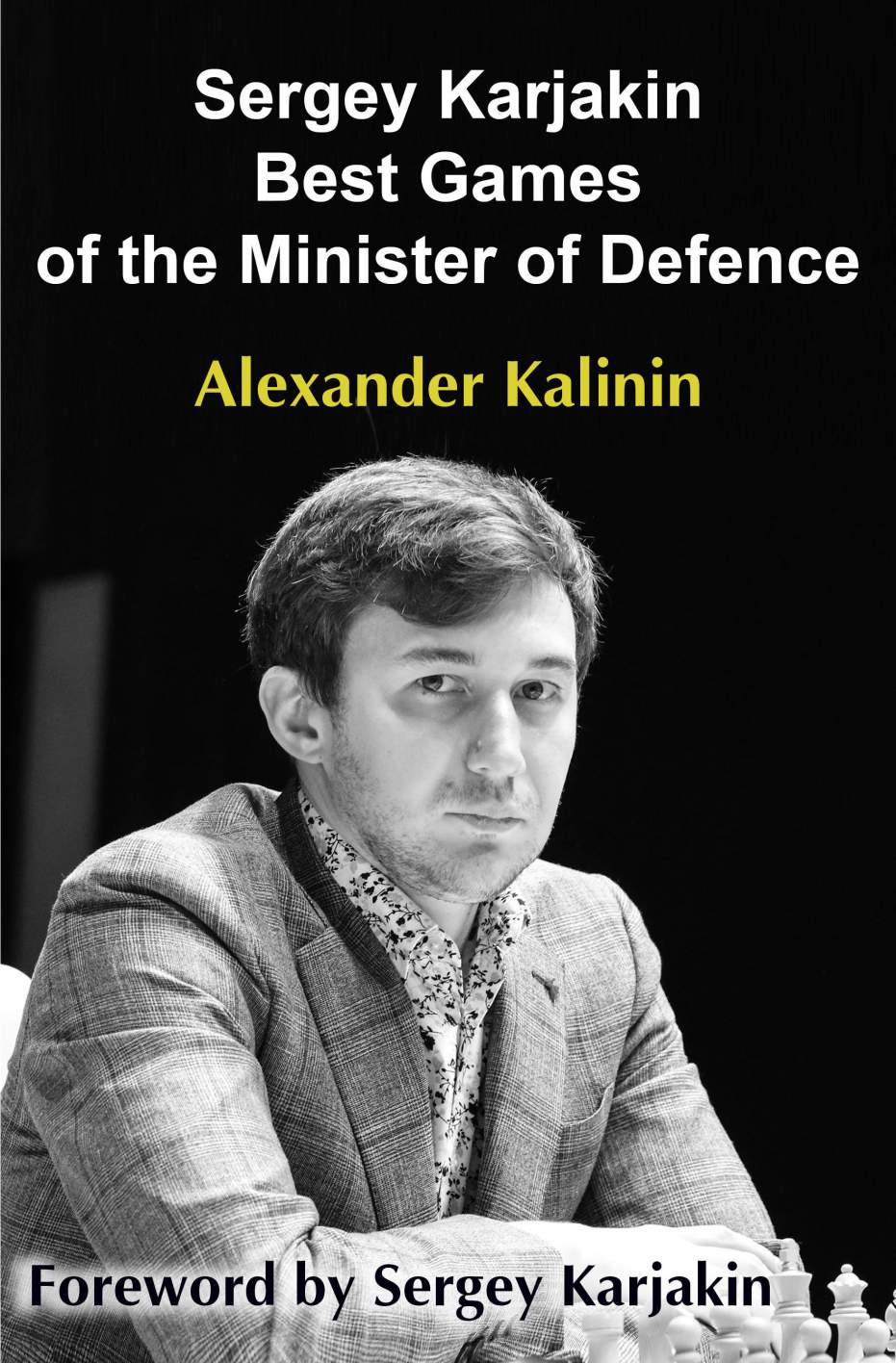
Sergey Karjakin has consistently been one of the strongest chess players of the early 21st century. World U12 Chess Champion in 2001. The world’s youngest ever grandmaster at the age of 12 in 2003. World Rapid Chess Champion in 2012. World Chess Championship Challenger in 2016, drawing 6-6 in the classical games and just one game away from winning the chess crown from Magnus Carlsen. World Blitz Chess Champion in 2016. Tied for 2nd-3rd place in the 2018 Candidates Tournament.
This best games collection begins with a biographical chapter, discussing the Russian grandmaster’s rise from early childhood to the chess elite. It contains 66 fully annotated games and 9 fragments, illustrating the distinctive feature of Karjakin’s style: a harmonious blend of subtle positional understanding and an acute sense of dynamics.
50 of the games are grouped according to learning themes: direct attack on the king; attack in the center and on the queenside; combined attack on both flanks; opening wins; symmetrical pawn structure in the center; positional sacrifice; defence and counter-attack; and endgames.
The author is a grandmaster and Distinguished Coach of the Russian Federation.
Sergey Karjakin wrote in his foreword: “The annotations are captivating and not overloaded with computer variations; instead, the author provides practical explanations so that the reader can use this games collection to study all three stages of the chess game.”

Petr Izmailov: From Chess Champion of Russia to Enemy of the People - The Truth About My Father (2021) - in paperback, hardback, Amazon Kindle and Forward Chess
Petr Izmailov was considered to be one of the top four players of the Soviet Union in 1929 according to Yuri Averbakh, and he was ranked around number 50 in the world at the time based on Chessmetrics methodology. Izmailov won the 1928 Championship of Soviet Russia, reached the last four of the 1929 Soviet Championship, and had a 2/2 lifetime score against Botvinnik. He was a regular winner of Siberian regional and city championships as well as a pioneer in some openings, playing a line similar to the Makogonov Attack against the King’s Indian more than ten years before Makogonov himself.
Izmailov, like many players of his generation, fell victim to Stalin’s purges. He was arrested on spurious charges in 1936 and executed in 1937. His name was then mostly expunged from the Soviet chess press for over 50 years.
At the time of Petr’s arrest, his son Nikolai was less than two years’ old. Once the Soviet-era archives opened up, Nikolai set out to reconstruct the life and chess career of the father he never knew. This book is the result of his research over many years. It contains as complete a tournament record of Izmailov as could be found, as well as all 25 games and fragments that were reported in the contemporary press. At the time of this book’s publication in English Nikolai is a sprightly 86-year old great-grandfather.
All games and fragments have been thoroughly analyzed in this book in move-by-move style by Romanian Grandmaster and leading chess author Mihail Marin. While his analysis is in itself highly instructional Marin has provided a comprehensive historical background to the chess openings deployed in these games, often showing their origin, contemporary treatment by such masters as Alexander Alekhine and Jose Capablanca, and how they have evolved to modern interpretation by today’s leading grandmasters, such as Magnus Carlsen and Anish Giri. This book will hence be of interest both to practical players wishing to improve their play and fans of chess history.
Nikolai Izmailov
Mihail Marin
Mihail Marin is a Romanian grandmaster. He has won the Romanian championship on three occasions and participated in 12 Chess Olympiads, winning a bronze individual medal in 1988. In 1987 and 1990 he qualified for the Interzonal tournament. For many years he has been a collaborator of Judit Polgar, accompanying her as a second in three tournaments in 2005. Marin is an active chess writer, winning the Book of the Year award on several occasions.
Nikolai Izmailov (born 1934 in Tomsk) was the son of 1928 Champion of Soviet Russia Petr Izmailov. Prior to publishing his biographical book on his father, Nikolai wrote several articles in the Russian chess press about him. A retired engineer, he lives in Irkutsk.
Alexander Bakin, Vladimir Barsky, Dmitry Kryakvin, Dmitry Kurnosov, Svetlana Kurnosova, Igor Lysy, Pavel Ponkratov and Alexander Riazantsev (editors)
The Chelyabinsk Meteorite: Selected Games of Igor Kurnosov (2018) - in paperback, Amazon Kindle and Forward Chess
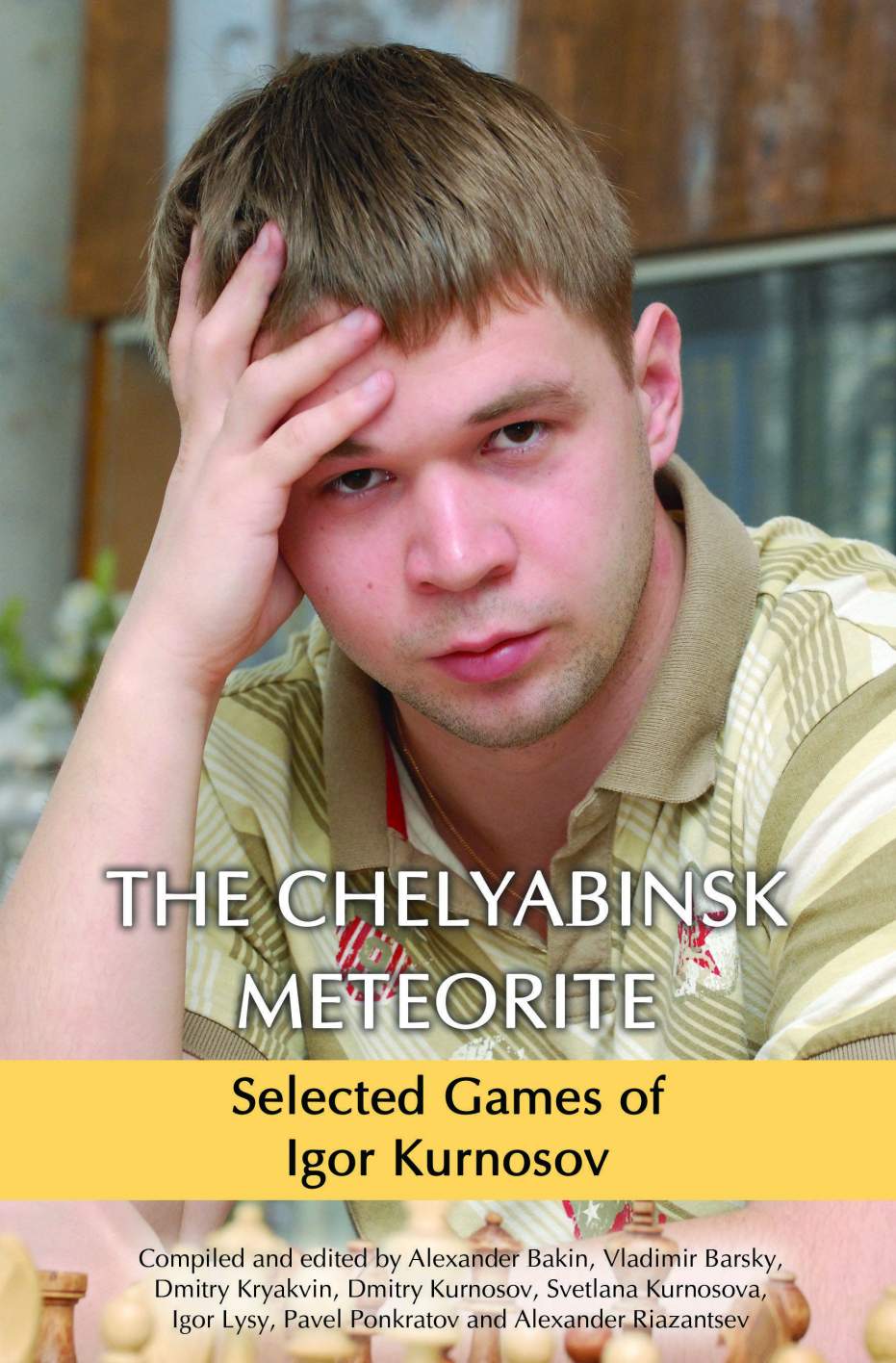
This book contains fifty illustrative games and a career overview of Chelyabinsk grandmaster Igor Kurnosov, who was tragically hit and killed by a car in 2013 at the age of just 28. At his last tournament prior to his death, Igor attained a super-grandmaster tournament performance rating in excess of 2700.
Kurnosov left an indelible mark on the chess world—he was a Russian youth champion, a member of the Russian national team that won the world student team championship and the Tomsk-400 team that finished first at the Russian championship. He won or placed highly at dozens of international tournaments.
The games in this book, with highly instructional commentary by Kurnosov’s friends and colleagues, or sometimes by Kurnosov himself, are filled with blistering attacks and subtle endgame play. They have been selected in part to demonstrate the progression of his career, rather than being his absolute best games. Igor had several signature openings, but he undoubtedly is best known in the chess world as a master of the Grunfeld Defense. According to Grandmaster Dmitry Bocharov in this book, Igor was one of the world’s leading experts in the Grunfeld. Igor was a sophisticated analyst, and many of his opening ideas are still relevant to this day. This book will be useful for both beginners and highly-rated players to improve.
Commentators in this book include such well-known grandmasters as Ernesto Inarkiev, Roman Ovechkin, Dmitry Kryakvin, Sergei Rublevsky, and Kateryna Lahno, while his opponents in these games include such names as Boris Gelfand, Shakhriyar Mamedyarov, Ian Nepomniachtchi, and Dmitry Andreikin.
Andy Mack was born in 1970, in Bromley, South-East England. A keen chess player from an early age, he has competed three times in the British Chess Championships and achieved the title of FIDE Master. He also plays poker to a high standard, and has written a book entitled Omaha 8 or Better – Winning at Hi-Low Poker. In his professional life, Andy qualified as a Chartered Accountant and is a Director in a large accounting firm. Andy continues to live in South-East England. His favourite European city is Berlin, and The Berlin Defence is his first novel.
The Berlin Defence: A Novel (2020) - in paperback and Amazon Kindle
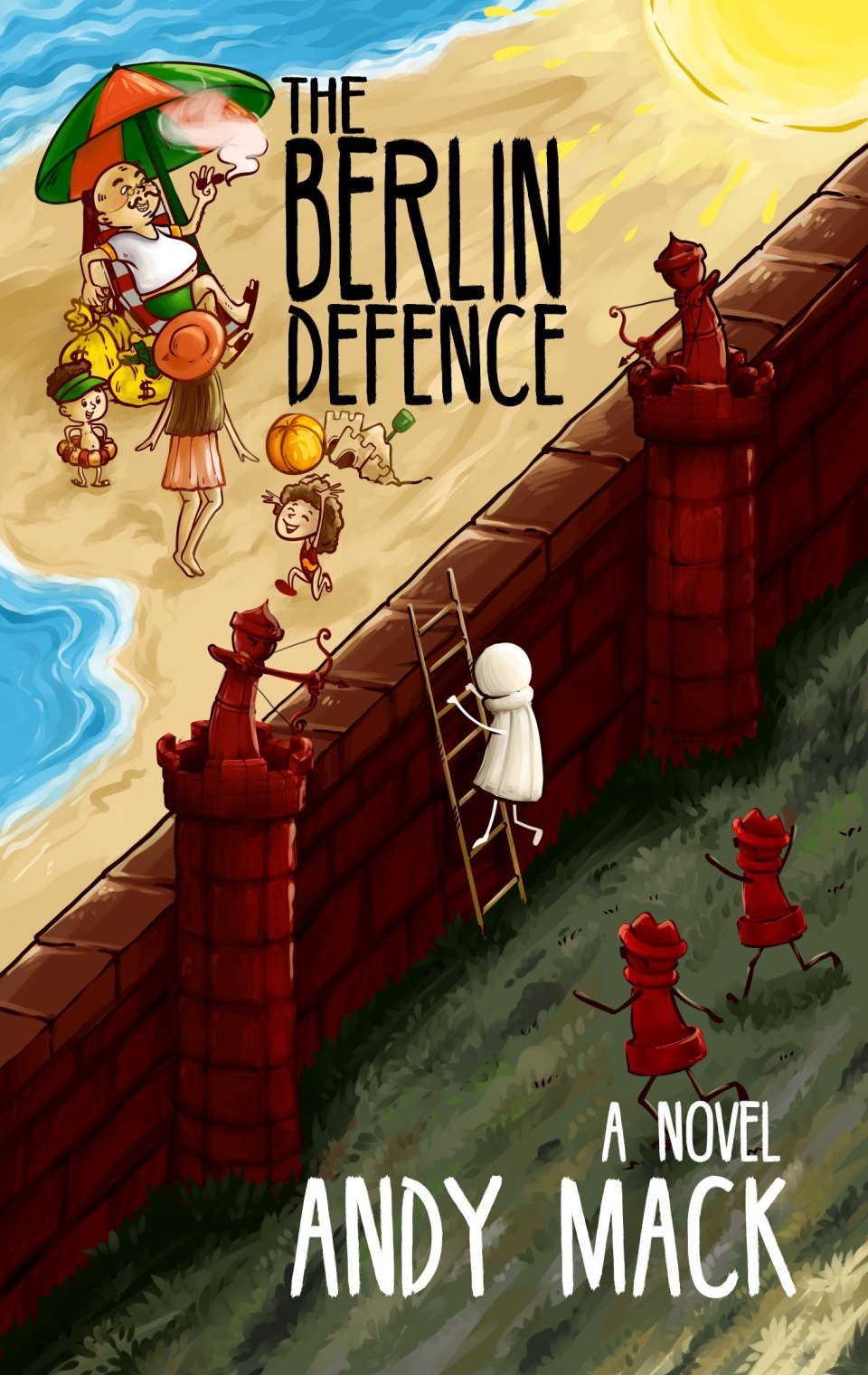
That afternoon, Lothar sat down opposite Lev Ivanov, and with a furrowed brow, determinedly pushed his King’s pawn forward two squares, punching down the clock as he did so. When Ivanov ventured a Sicilian Defence, Lothar sacrificed first a Knight and then a Rook for a raging attack.
Lothar Hartmann dreams of reaching the big time in chess. Overcoming the mind-games of his opponents at the chessboard is a challenge in itself, but how will he cope when he comes face to face with the political manipulation and oppression of his own corrupt government? A tale told with dark humour of love and loss, hopes dashed and regained, it is a window into a world of tactics, psychological warfare and the balance of fate and opportunity, while asking fundamental questions about life’s purpose and moral choices. As Lothar begins to realise that his world is not simply black and white, and that the chess players themselves are pieces, moved across a board to further the reach of East German propaganda, he hatches a plan that defies all expectations.
Anastasiya Geller (born in 1994) attained the Woman International Master title by decision of FIDE in 2021. She has won first place and other prizes at many international and Russian tournaments. Anastasiya is a six-times girls junior champion of the Urals. She has a career-high FIDE rating of 2228, attained in 2021. Anastasiya has a degree in teaching and psychology as well as another degree in information technologies. She has over ten years of chess coaching experience, focusing on beginners and young children.
Check and Mate - A Beginners Guide With 2000 Examples (2022) - in paperback, Amazon Kindle and Forward Chess

Woman International Master and experienced children’s coach Anastasiya Geller has written a textbook for beginners teaching them the very basics of attacking the enemy king. The reader will learn how to find a simple check and fully master one of the most important tactical elements in chess – checkmate in 1 move! The reader also learns how to choose the best defense against a check.
The book contains 2000 exercises, most of which are checkmates in 1 move – from the simplest mates with one piece to mating using several tactical techniques at once. The first part of the book introduces the concept of check and shows the reader how to recognize a safe check, before teaching discovered check. The second part gradually introduces different types of mate in a logical sequence by the different pieces, beginning with the rook and then progressing to the bishop, queen and knight. The third part of the book explains how to checkmate in one move using key techniques: checkmate with capturing, checkmate with a pawn promotion, checkmate with protection (including checkmate with a pawn), checkmate with pinning, checkmate with a discovered check, and checkmate with a double check.
Most of the positions to be solved have been selected from actual games of the strongest grandmasters of the present and the great masters of the past.
For beginner chess players, their parents and coaches.
Anastasiya Geller
Andy Mack
Andy Mack interviewed on YouTube by Grandmaster Matthew Sadler and WIM Natasha Regan, including discussion of The Berlin Defence: A Novel
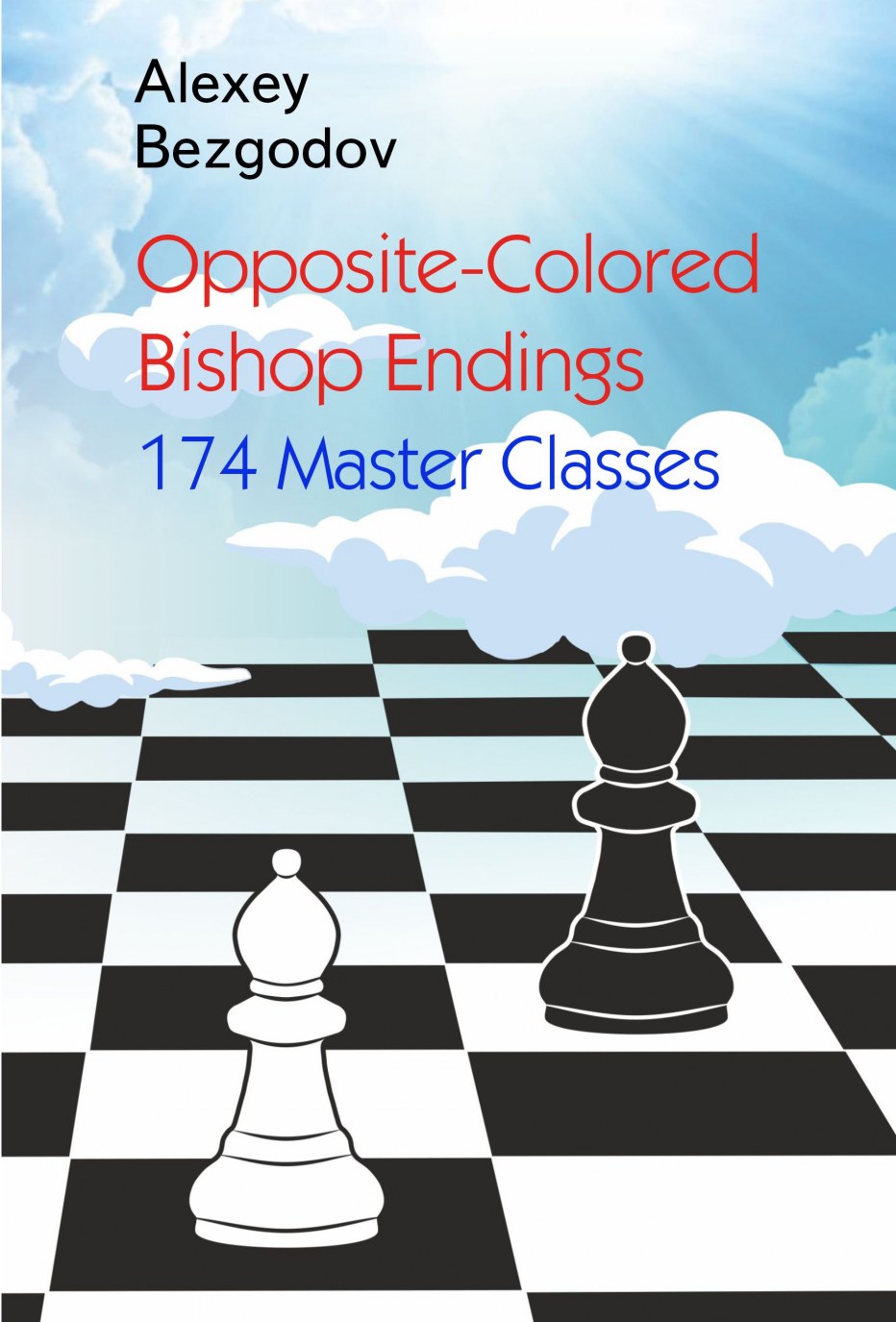
Opposite-Colored Bishop Endings: 174 Master Classes (2024) - out of print. Second edition in production
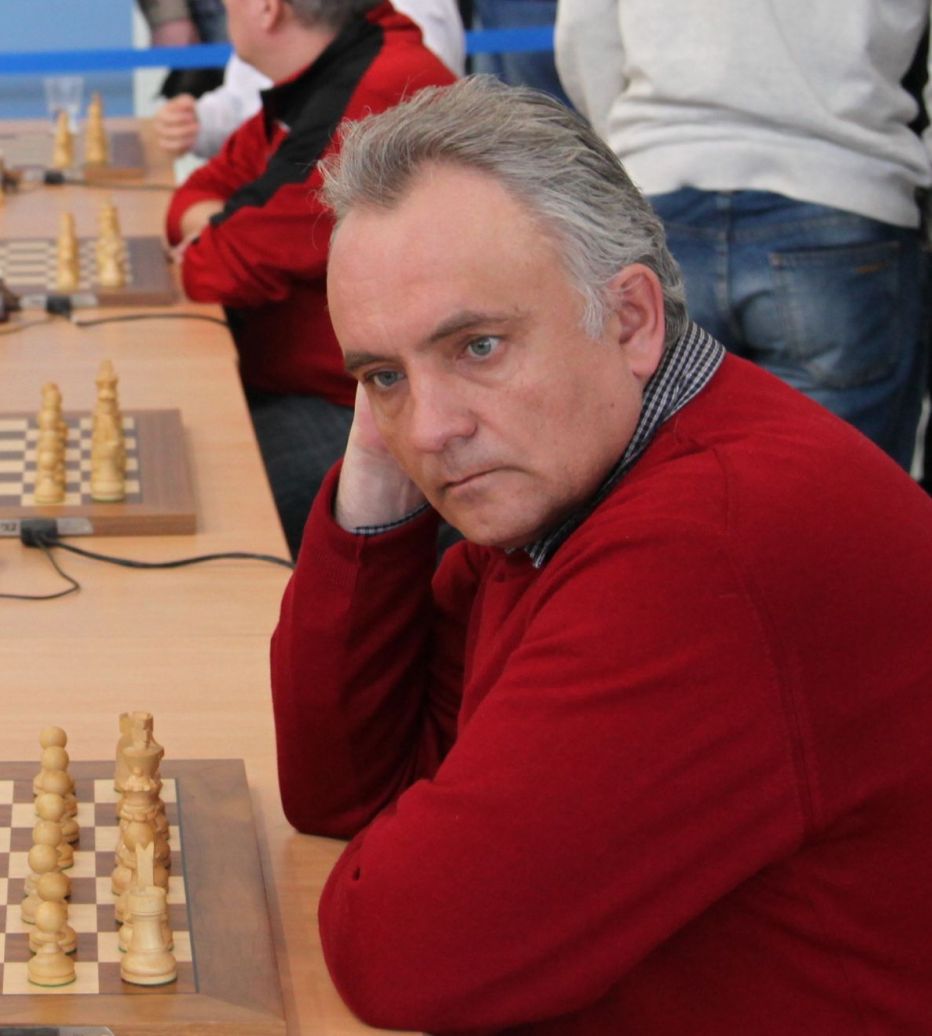
Alexey Bezgodov
Grandmaster Alexey Bezgodov, born in 1969, was Russian champion in 1993 and runner up in 1999. He has written around 20 books on all aspects of chess.
There are many secrets in chess, knowledge of which distinguishes a chess virtuoso from an amateur. One of these secrets is the ability to play positions with opposite-colored bishops.
Why is it so important? The point is that the presence of opposite-colored bishops is not always a sign of an impending draw. Due to a number of factors, one of the bishops may turn out to be stronger than its opposite number. This can lead to a successful attack, material gains or obtaining some other advantages that contribute to winning the game.
Grandmaster Alexey Bezgodov has written a book analyzing 174 endgame positions with opposite-colored bishops as training material for advanced players who wish to deepen their endgame skills. Endgame theory, tactics and strategy are all covered, and this will help strong improvers to grind out wins instead of draws, and to avoid losing in difficult positions. Most positions are taken from modern games, and they mostly feature world champions and top grandmasters, including Carlsen, Anand, Kramnik, Kasparov, Karpov, Fischer, Tal, Korchnoi, Andersson, Shirov, Gelfand, Caruana, Nepomniachtchi, and others.





